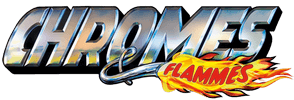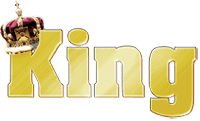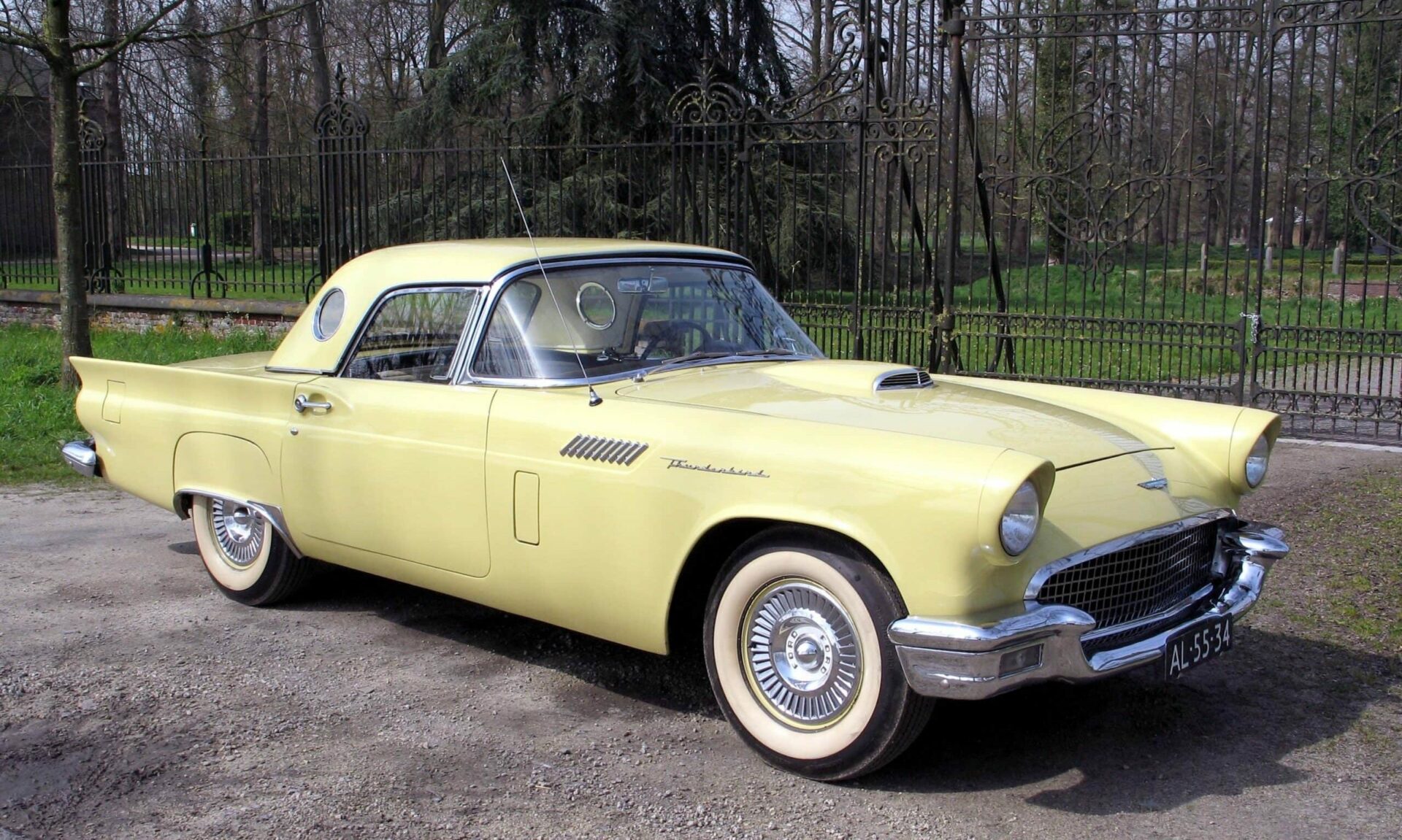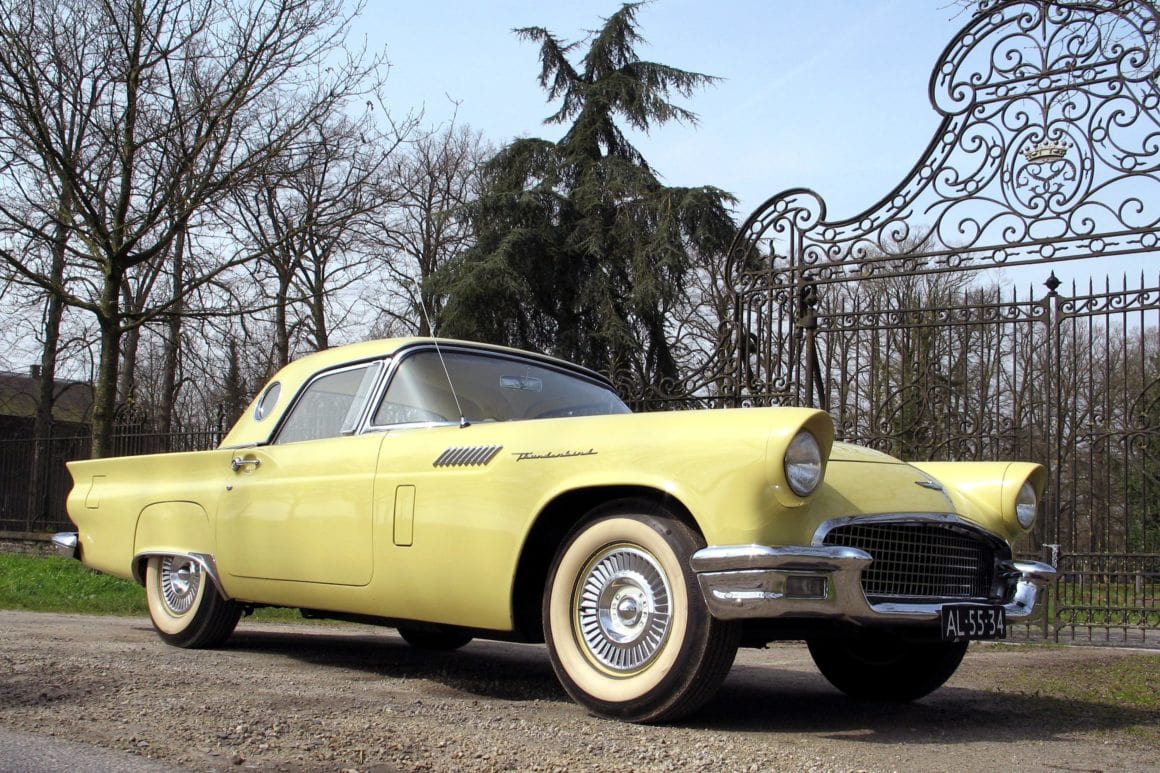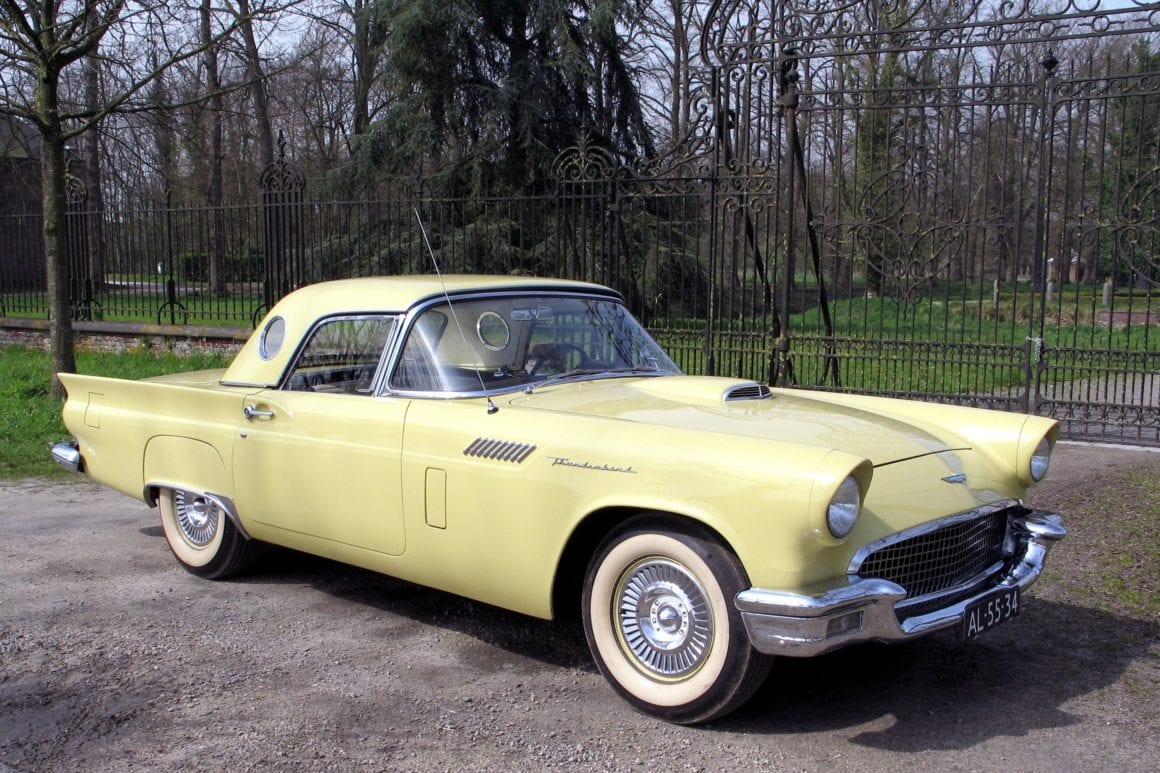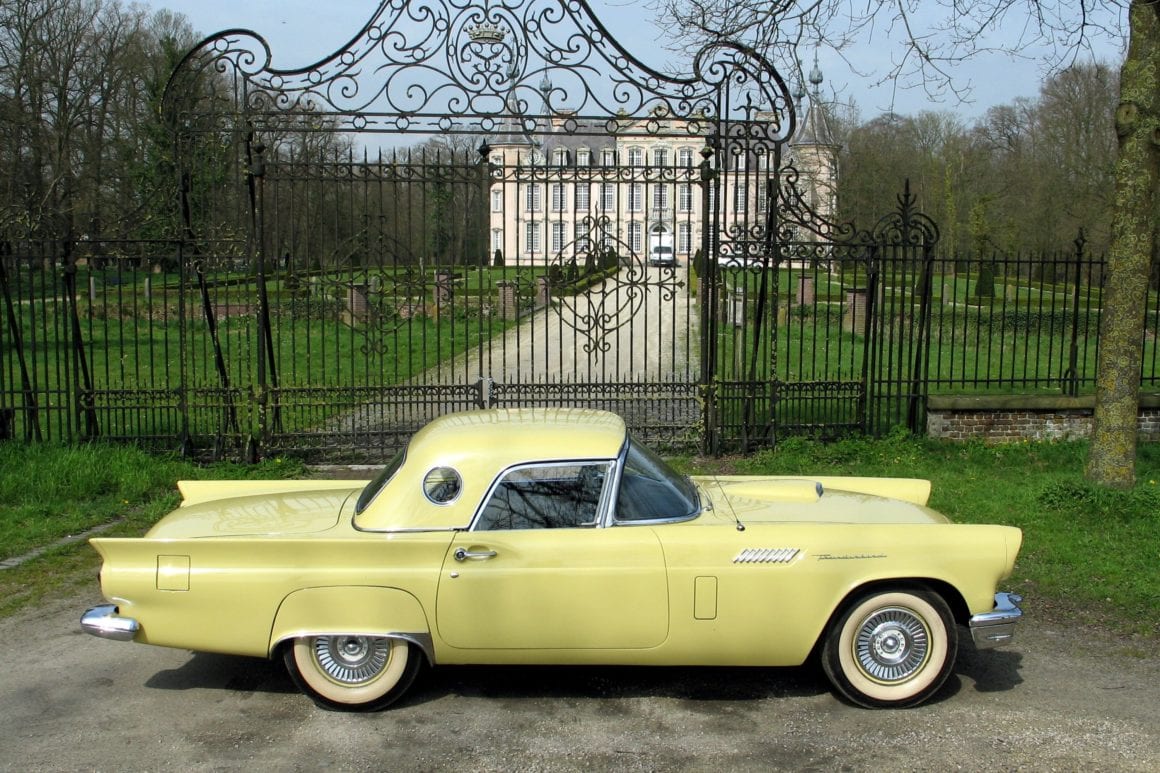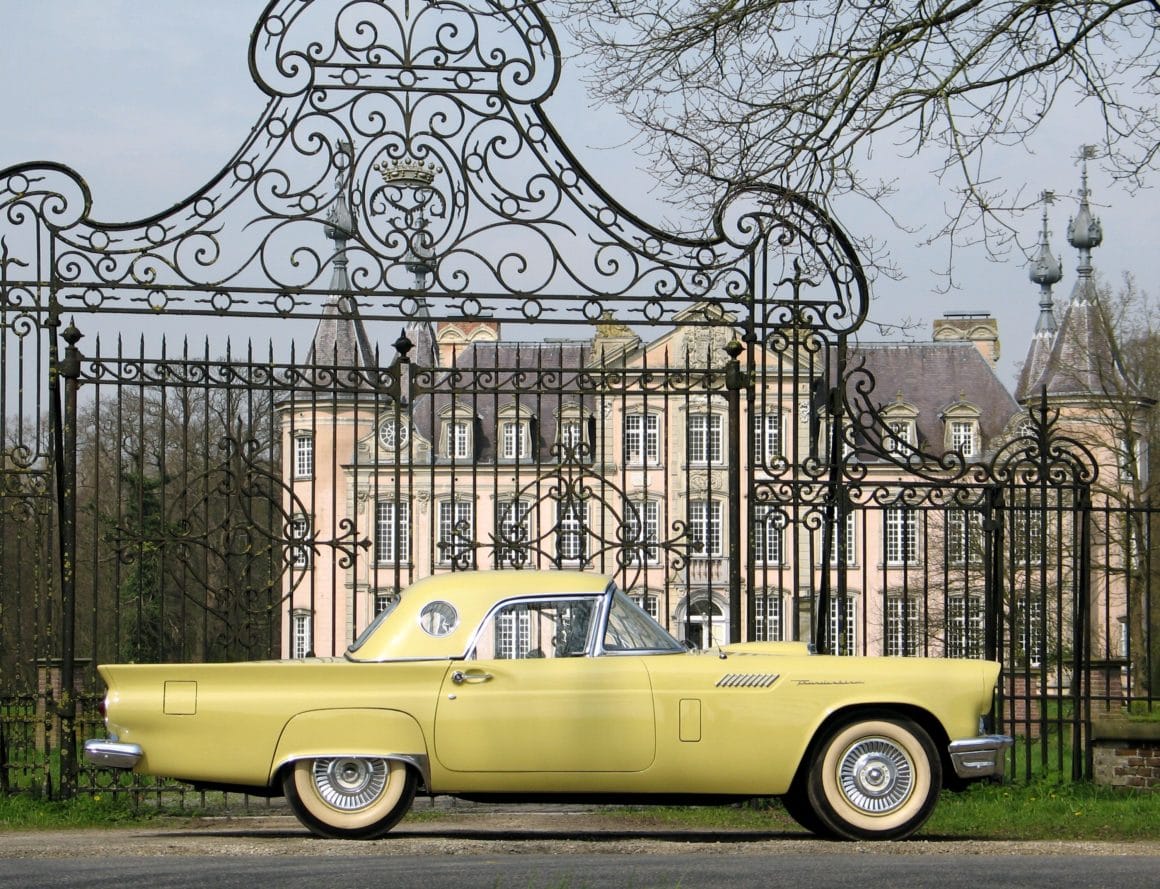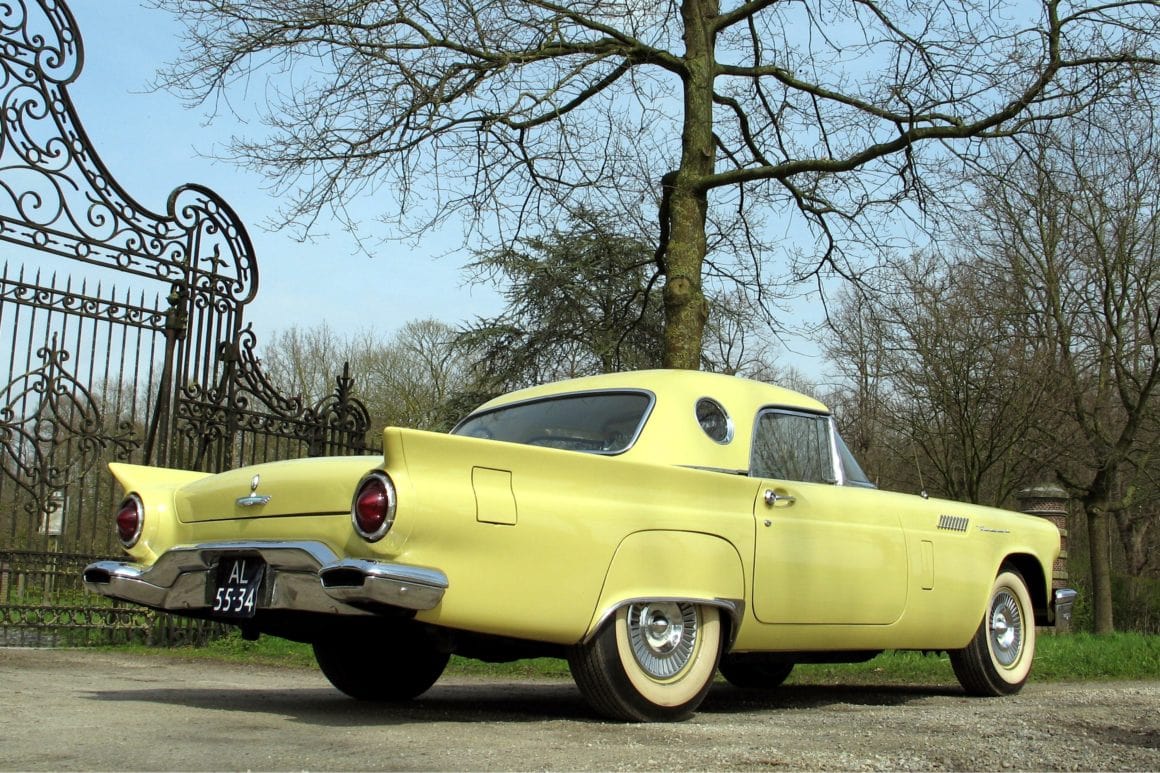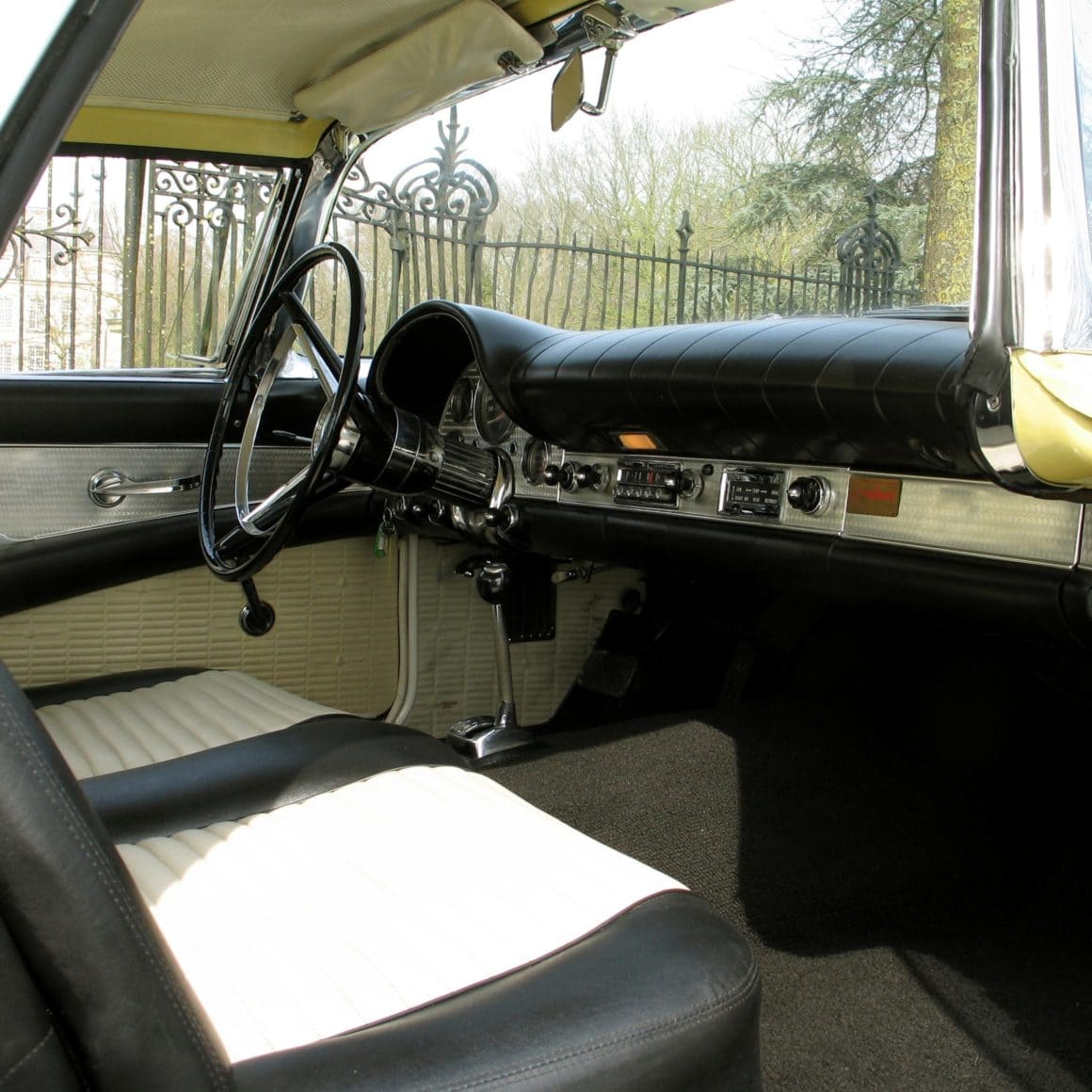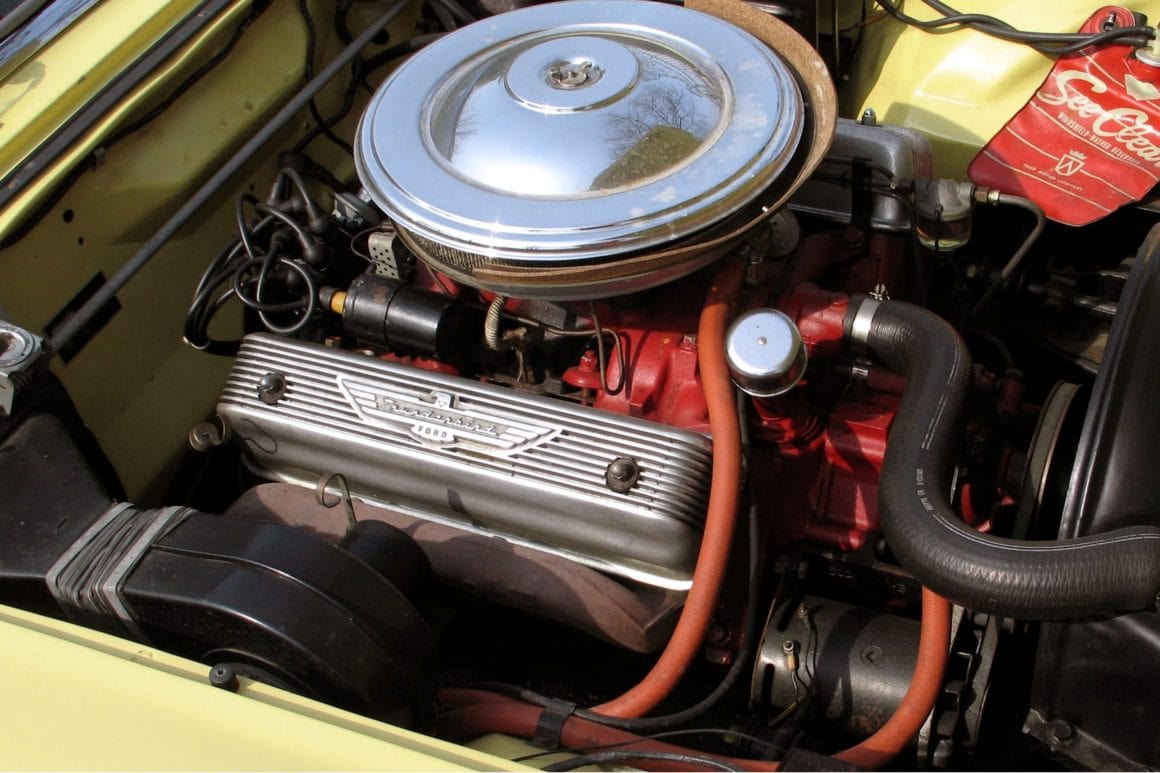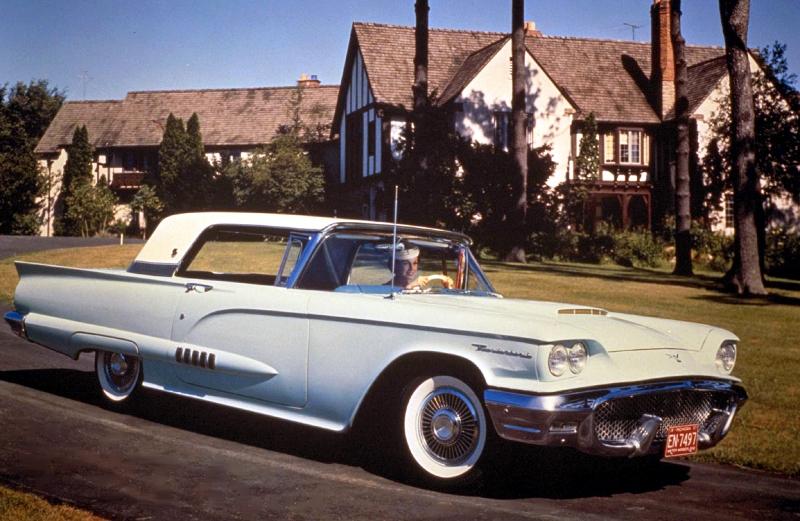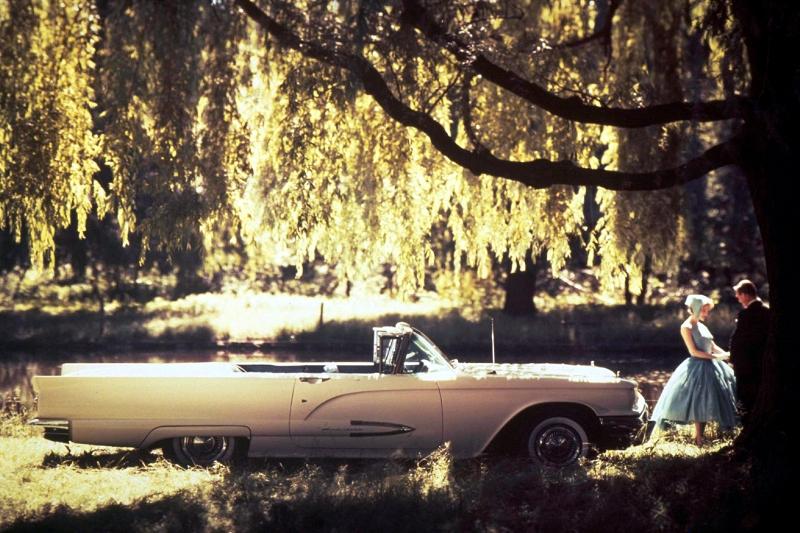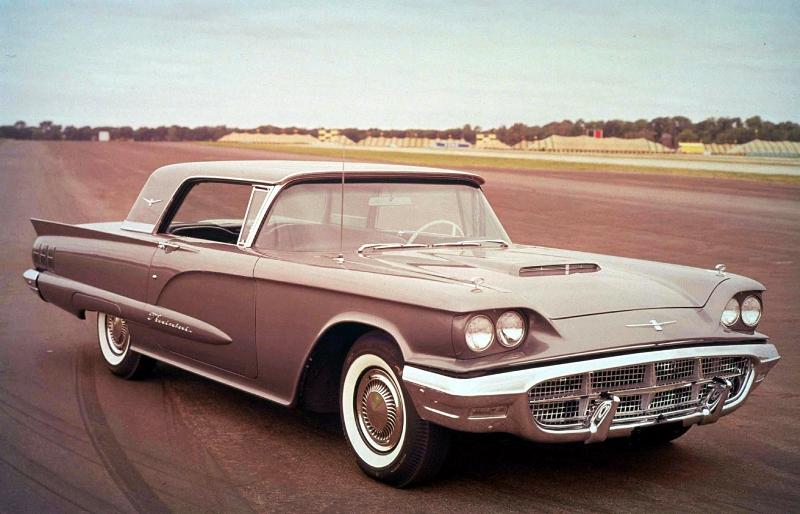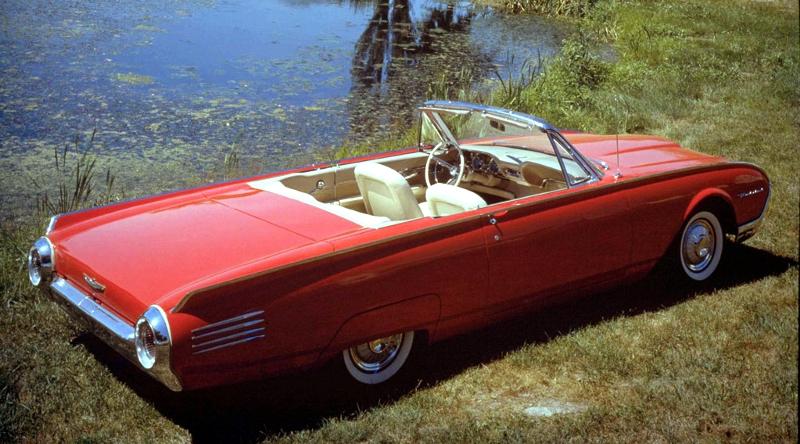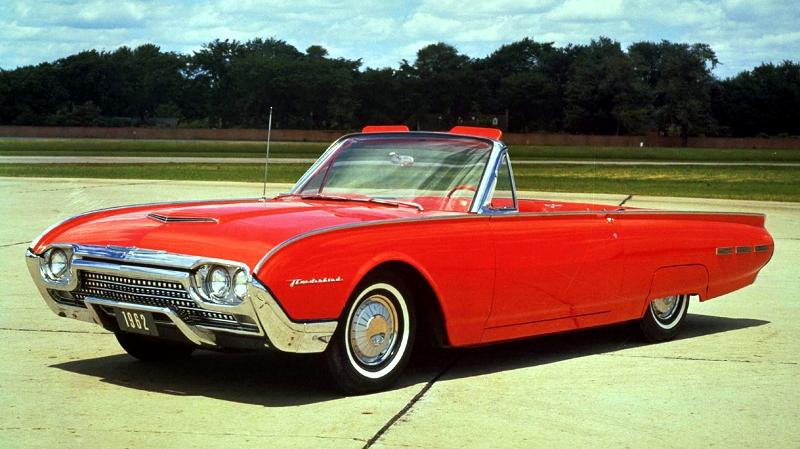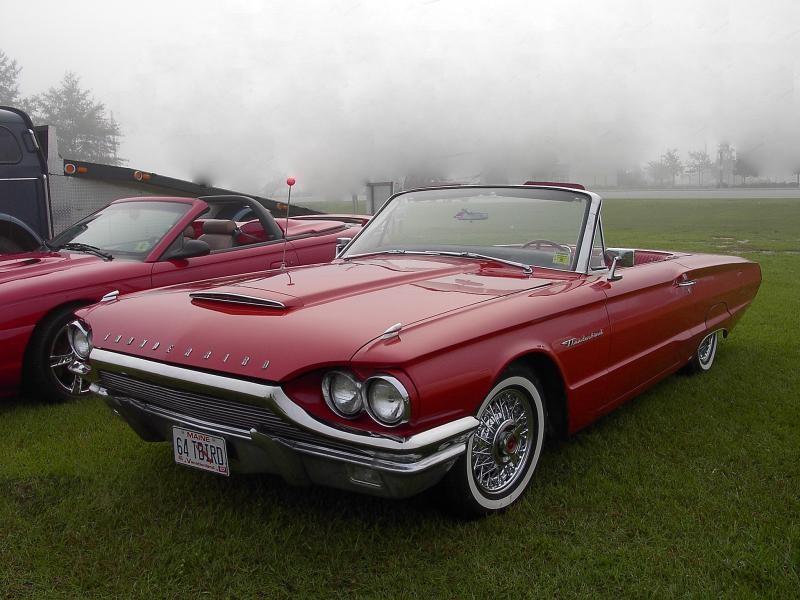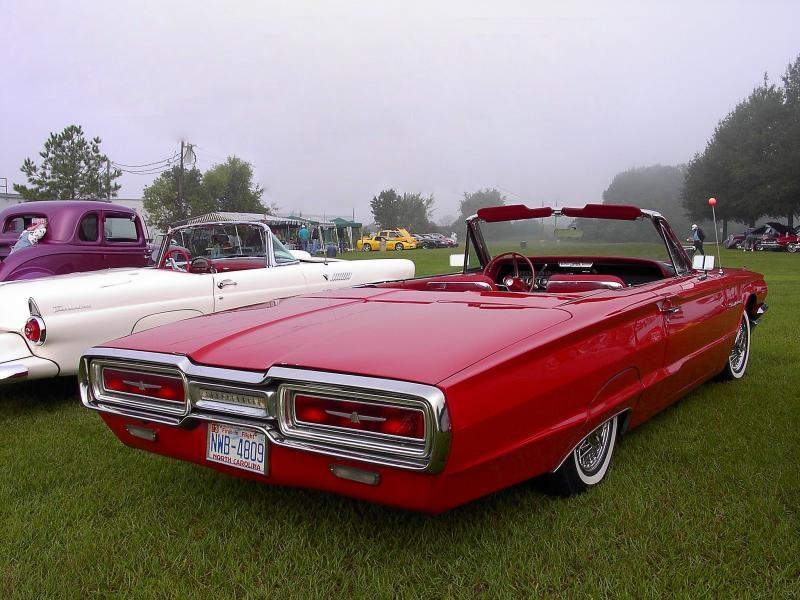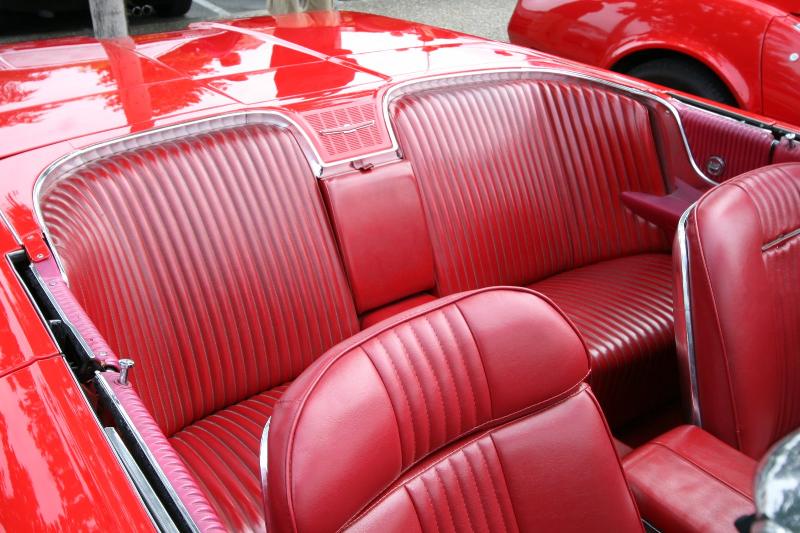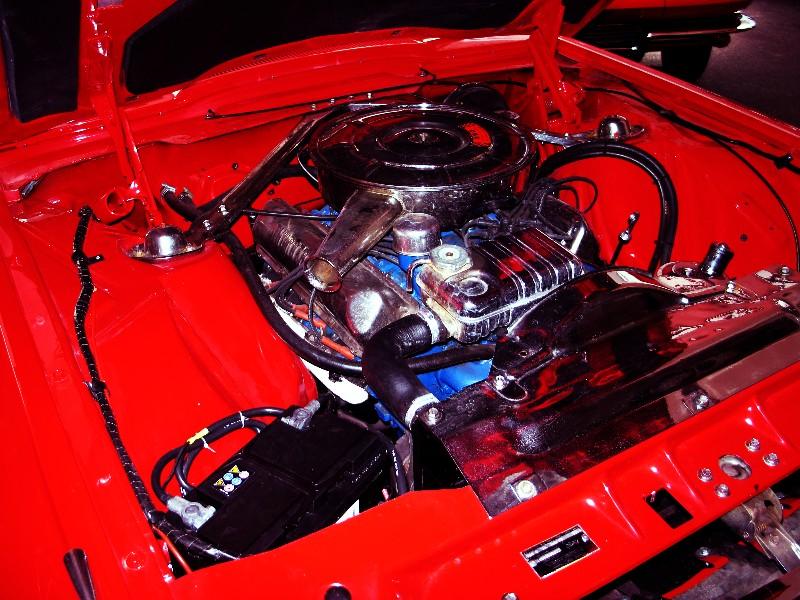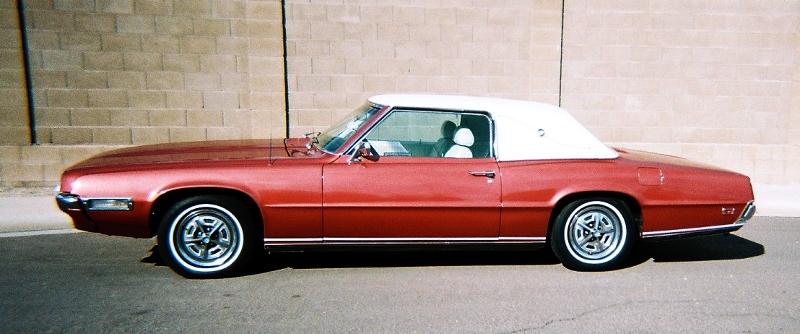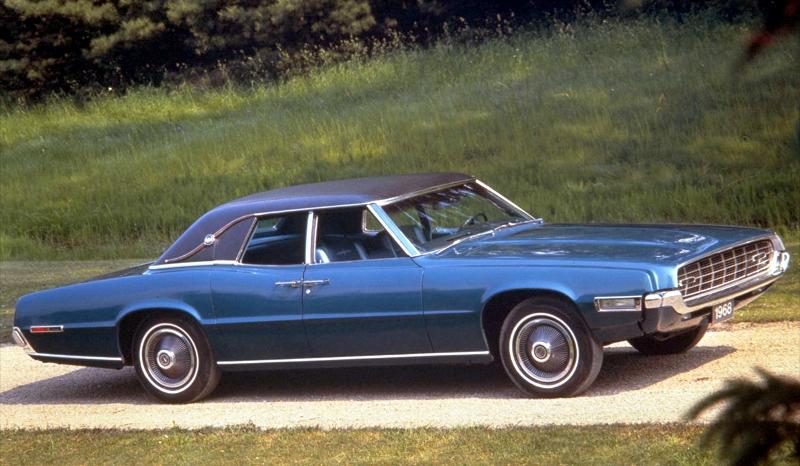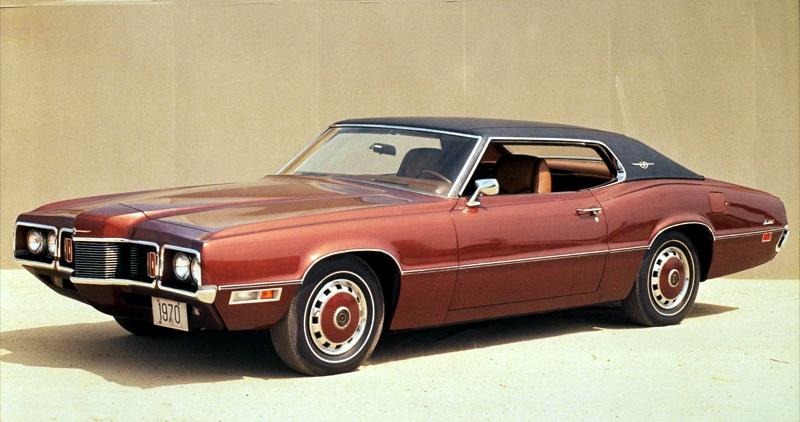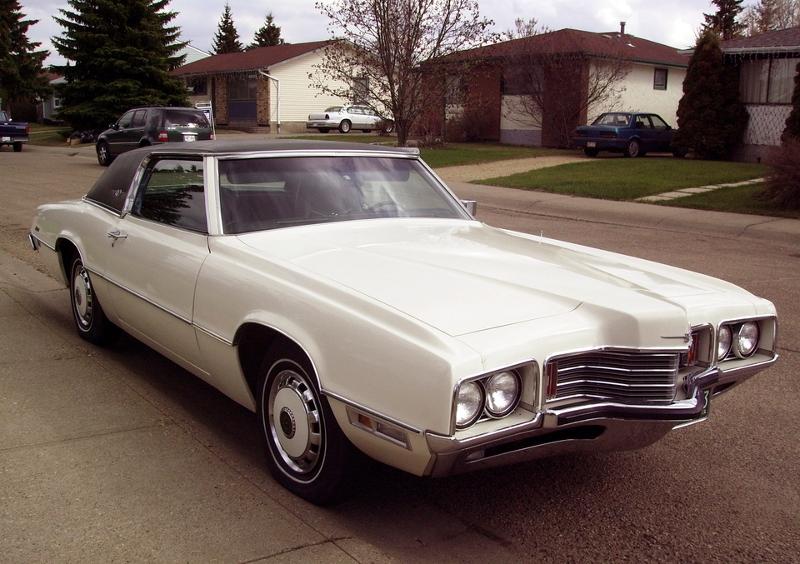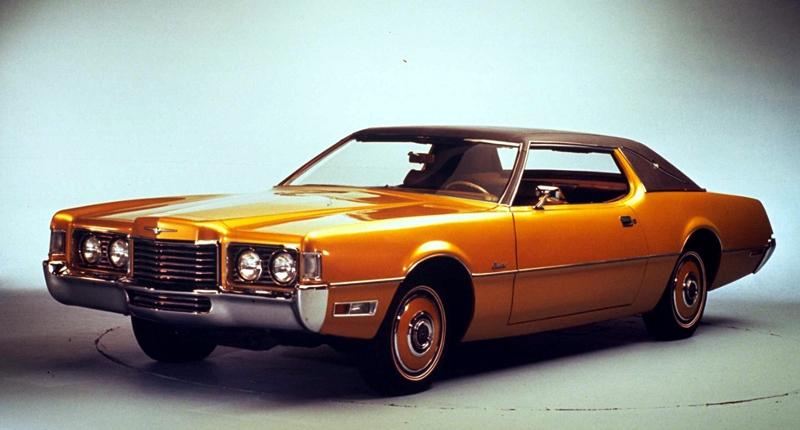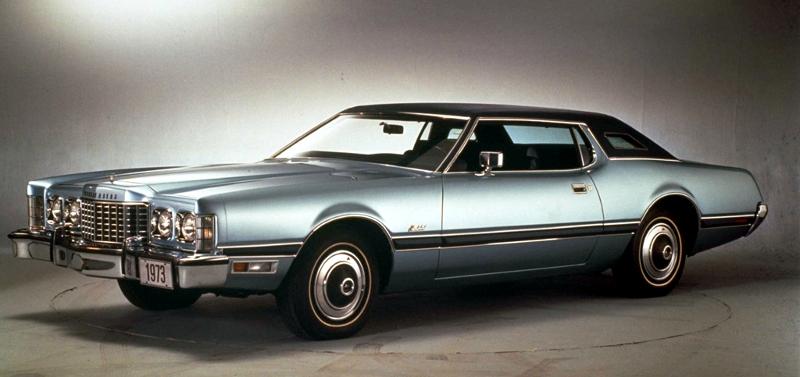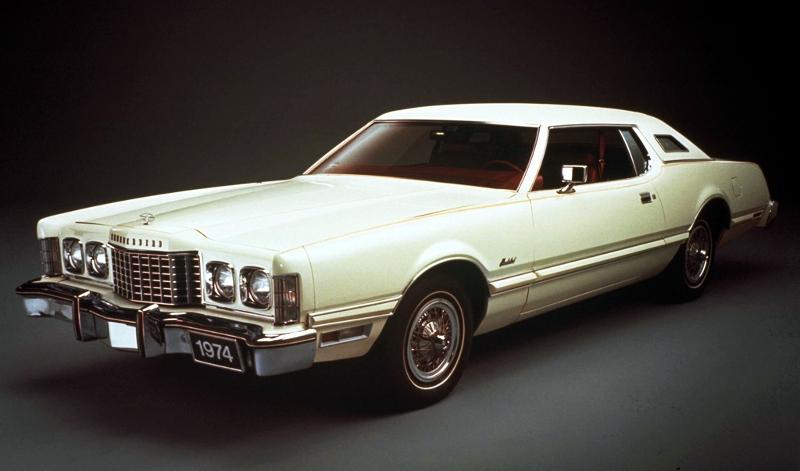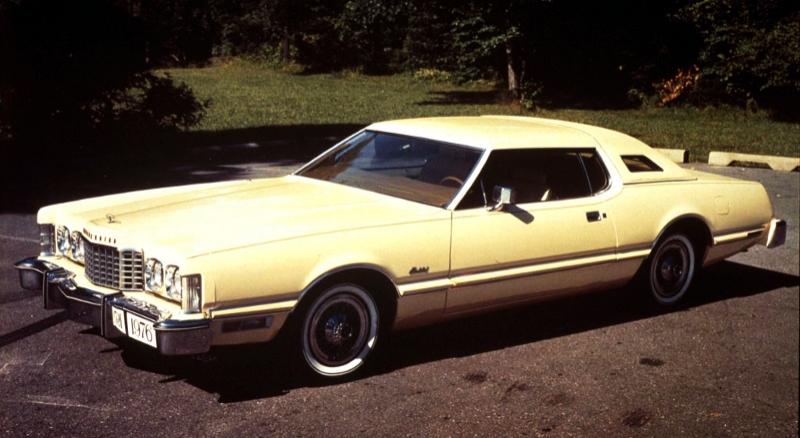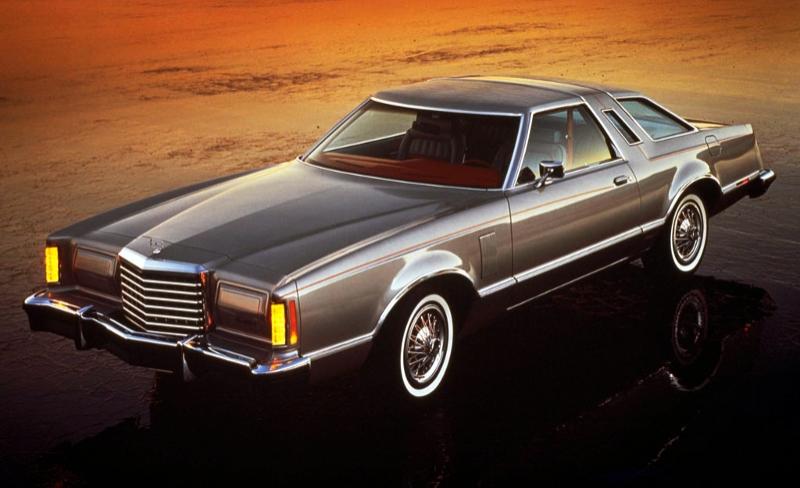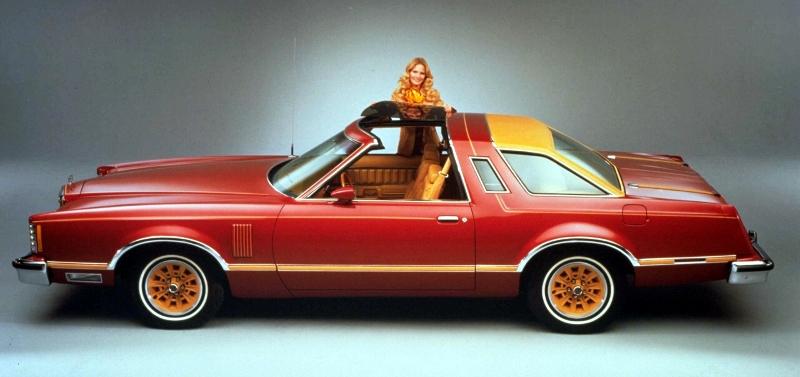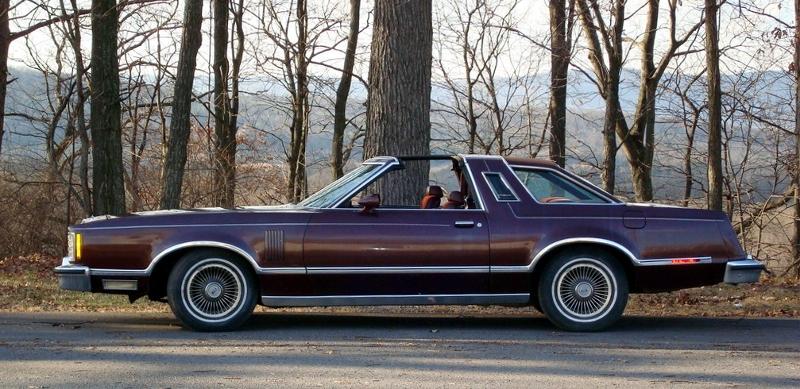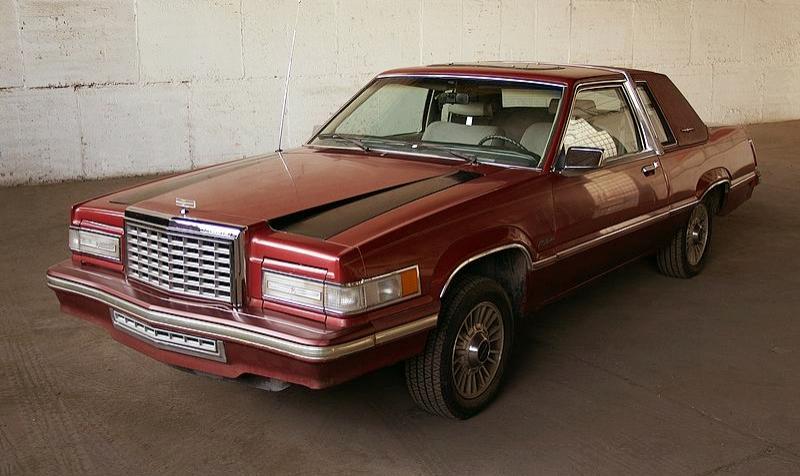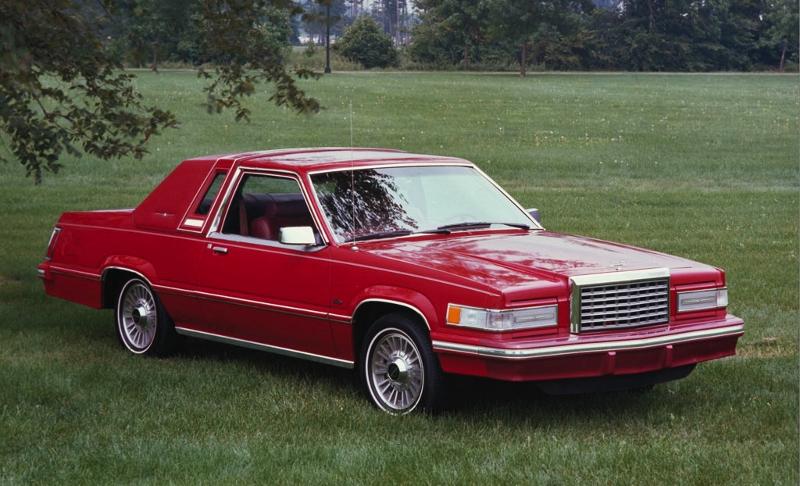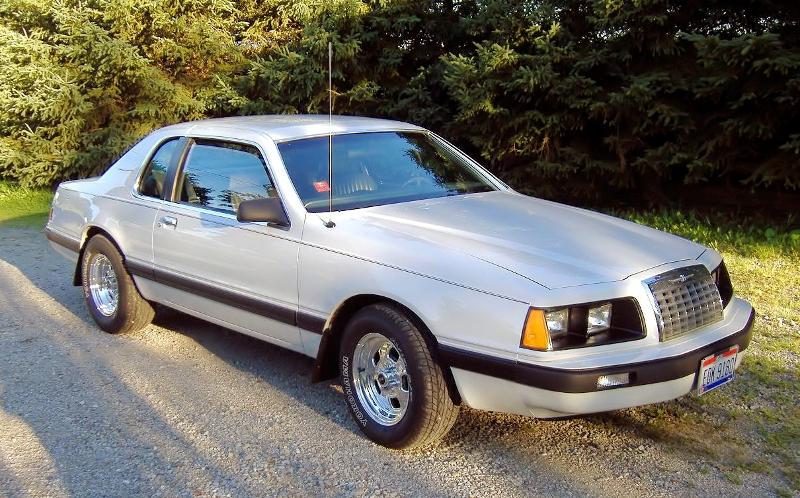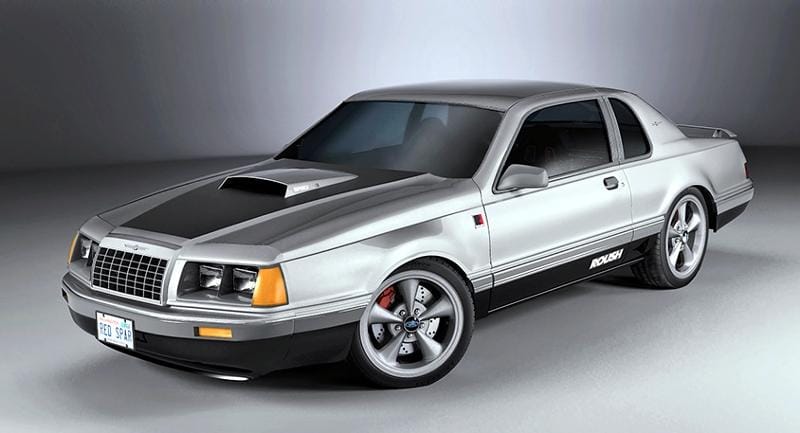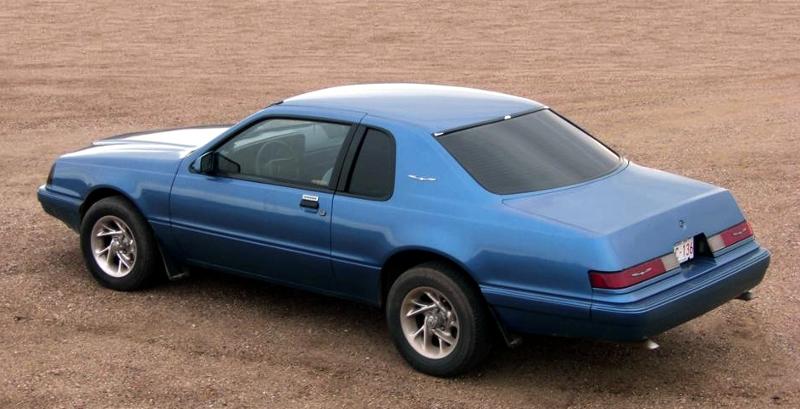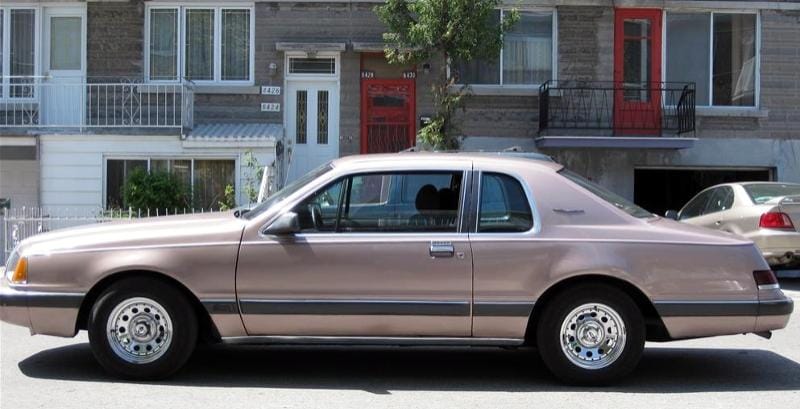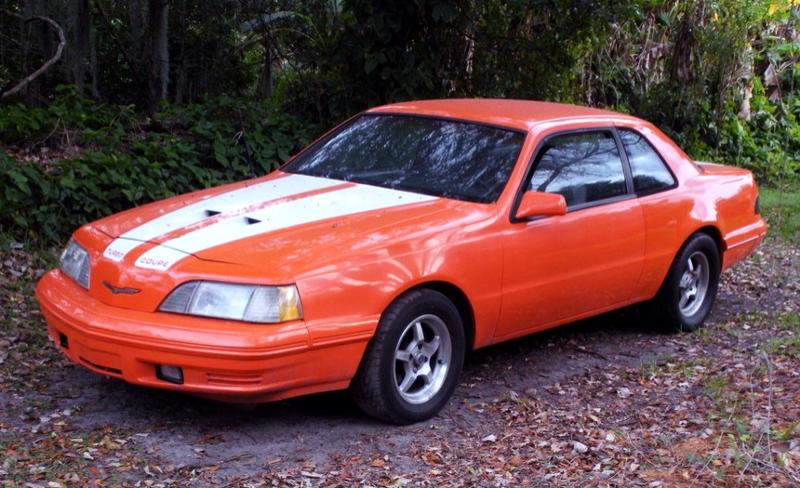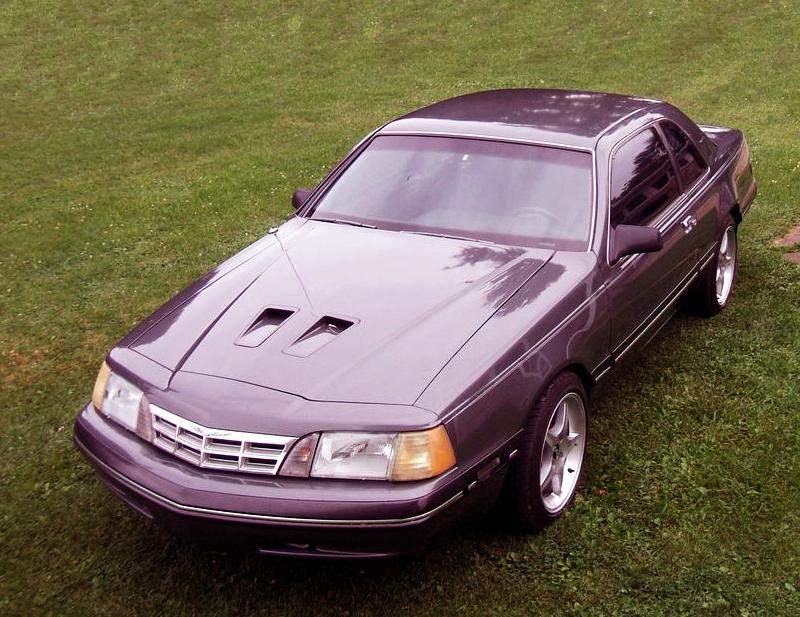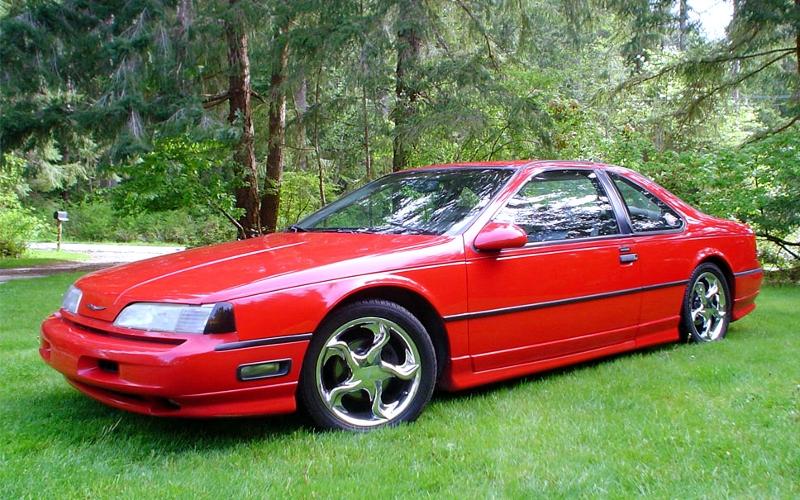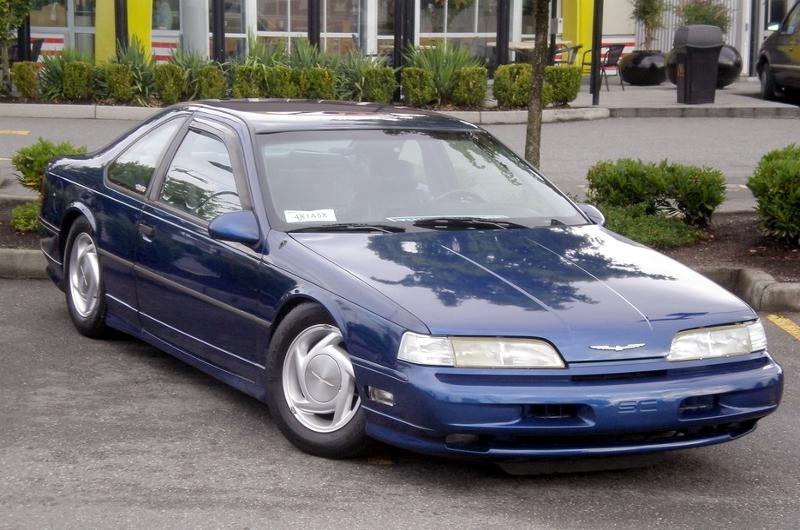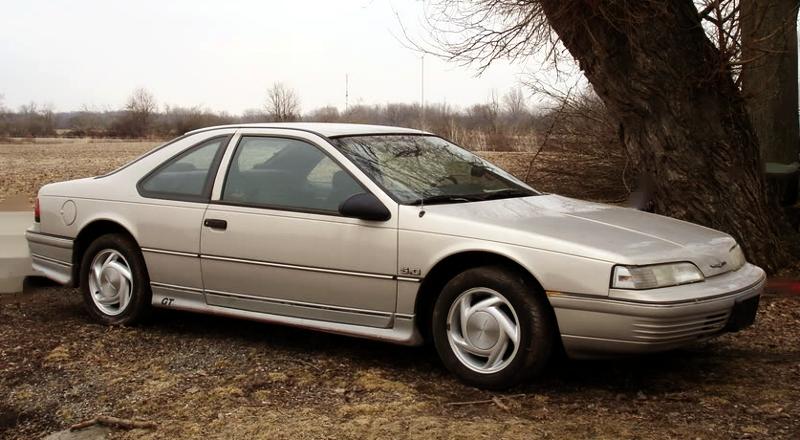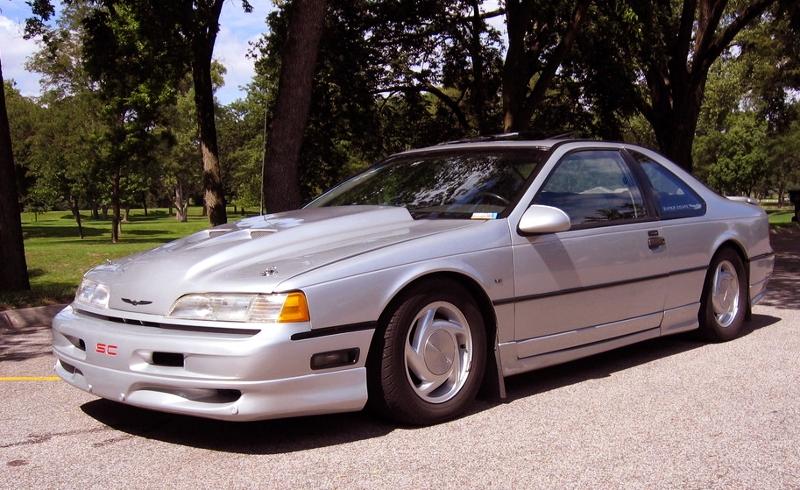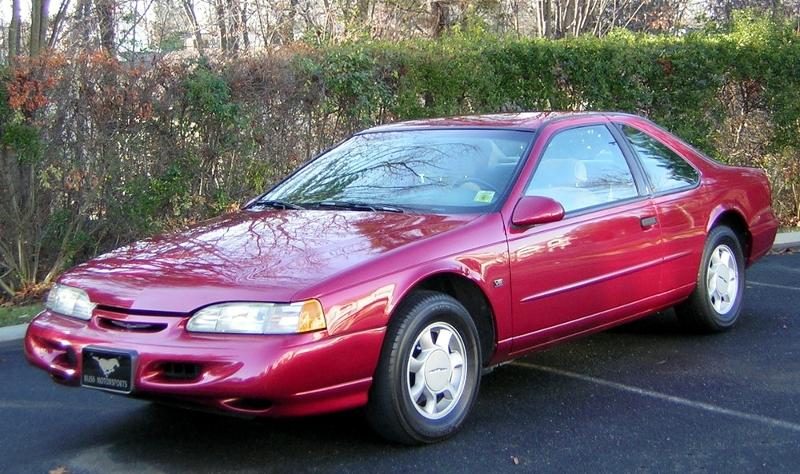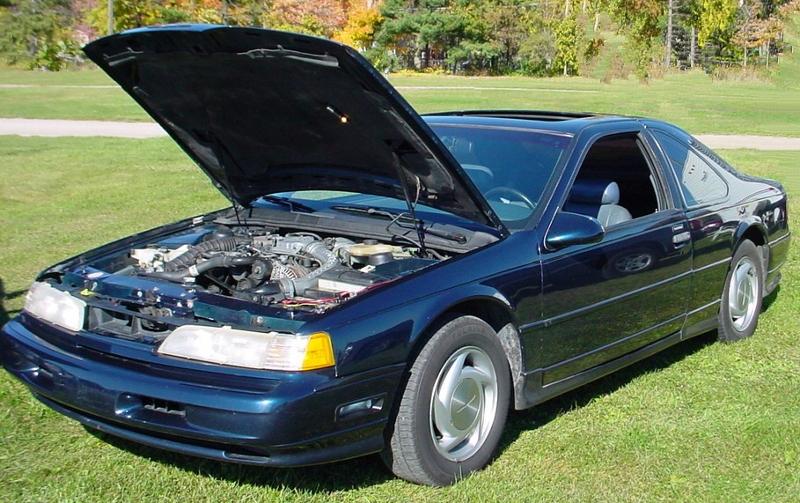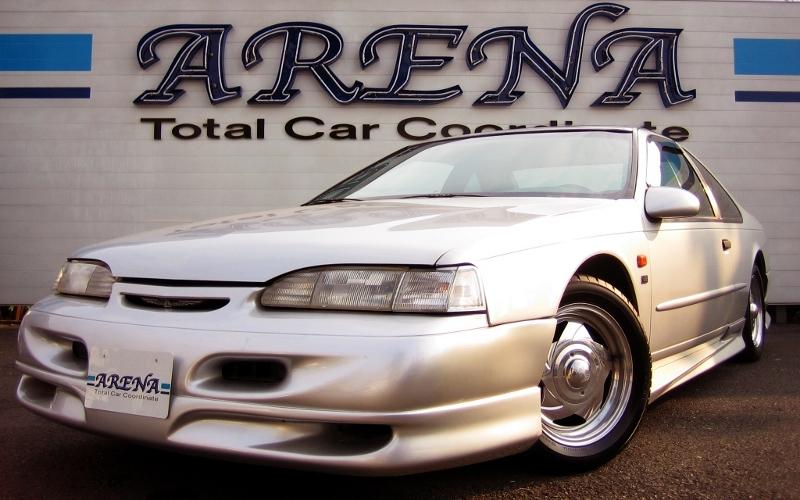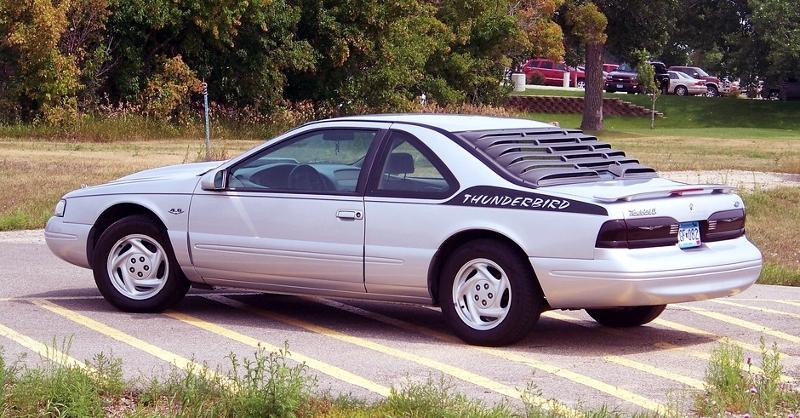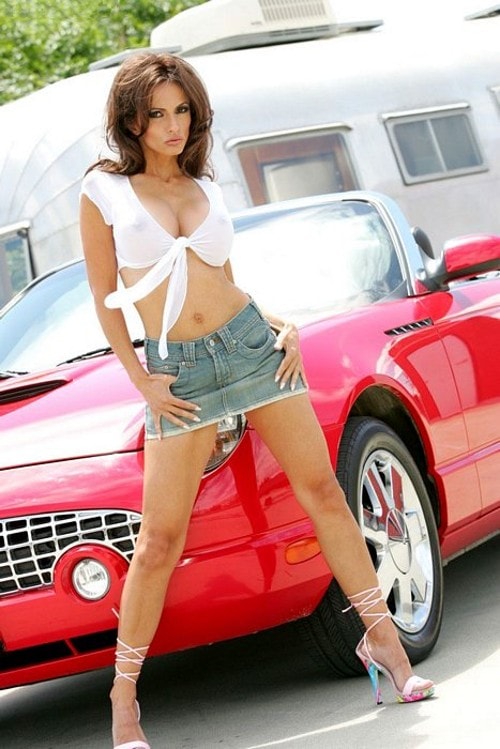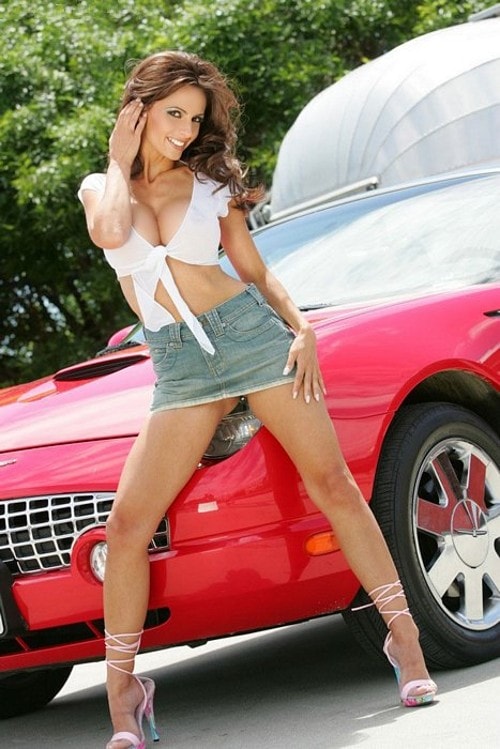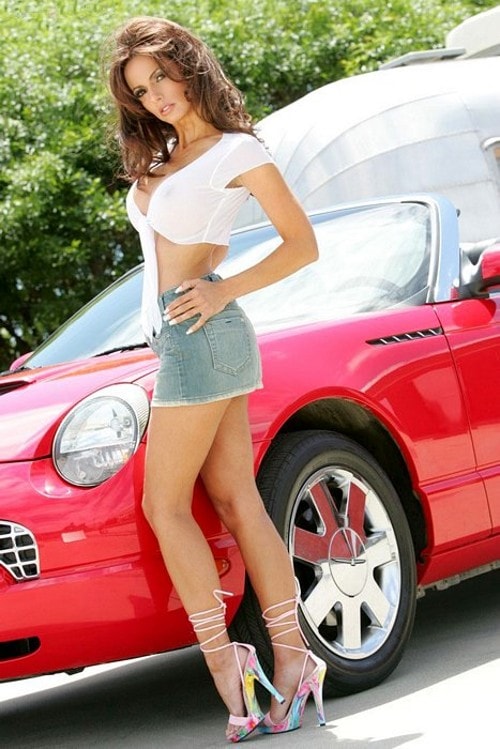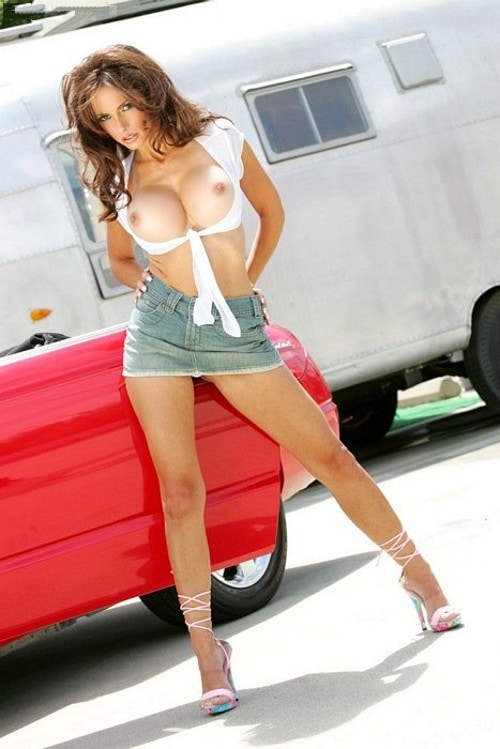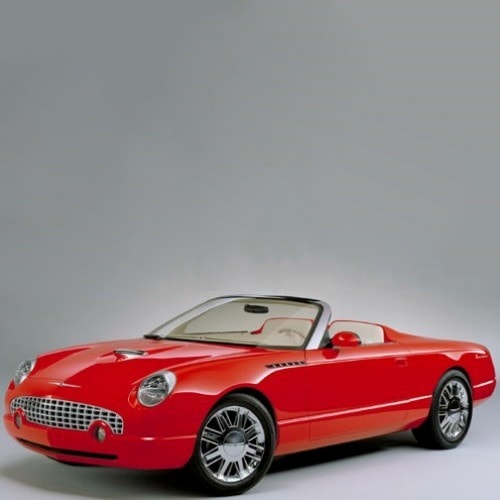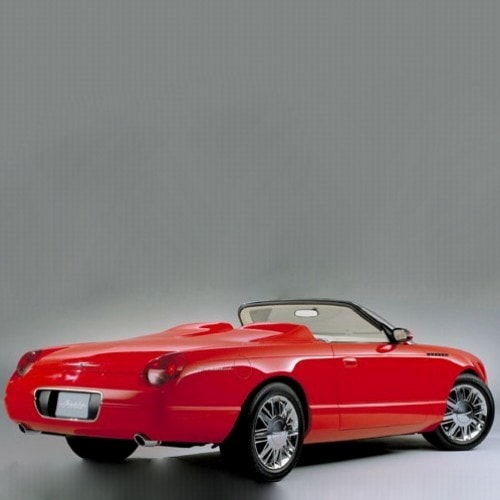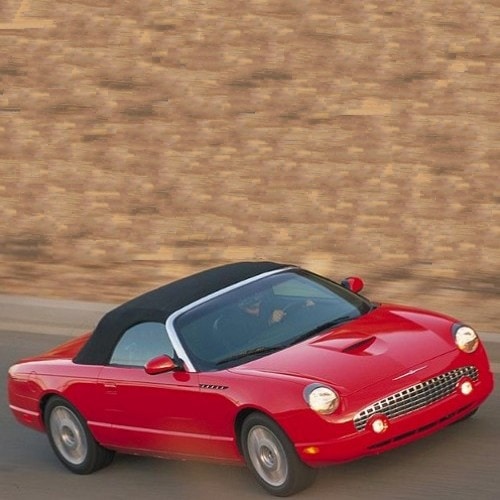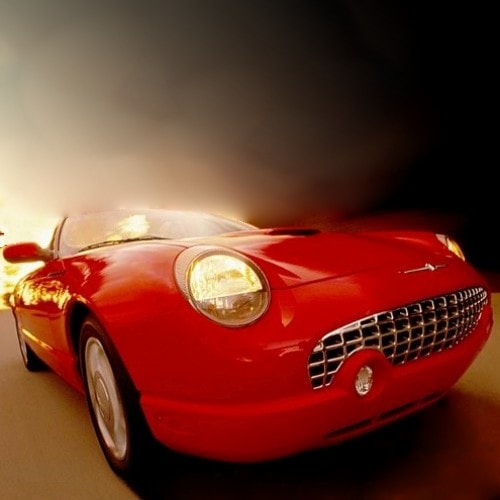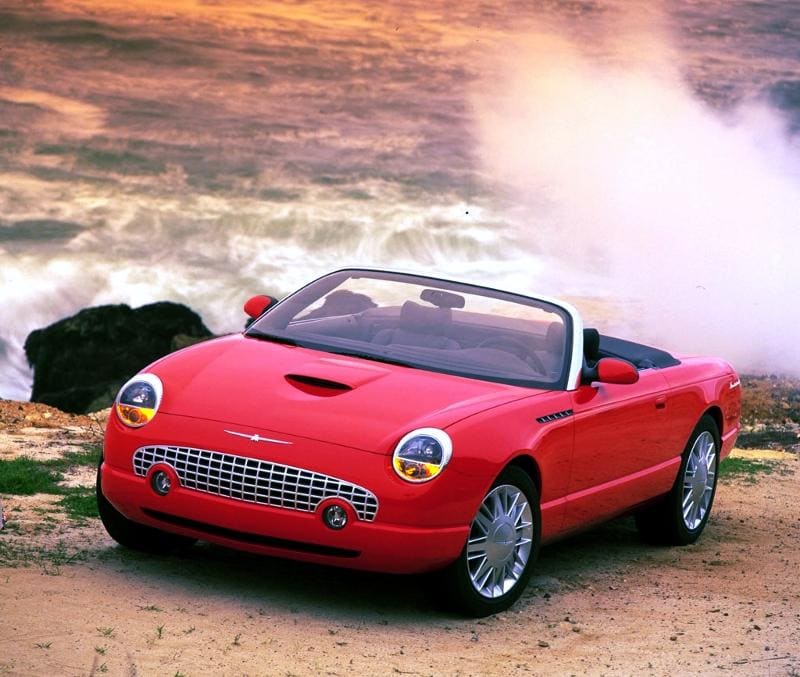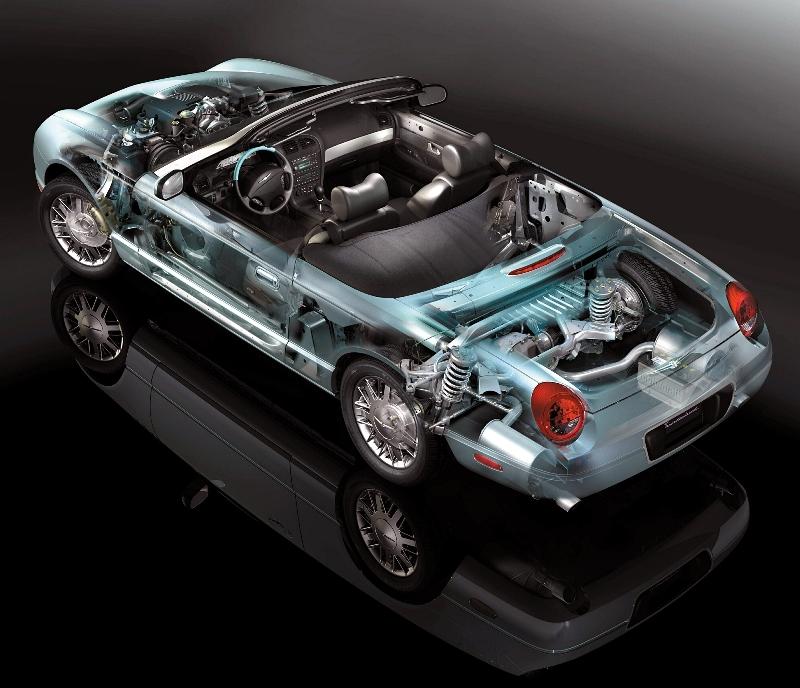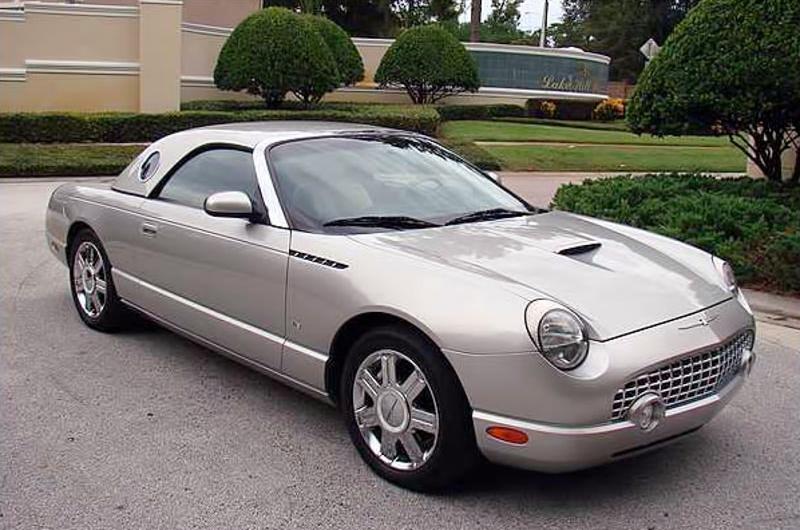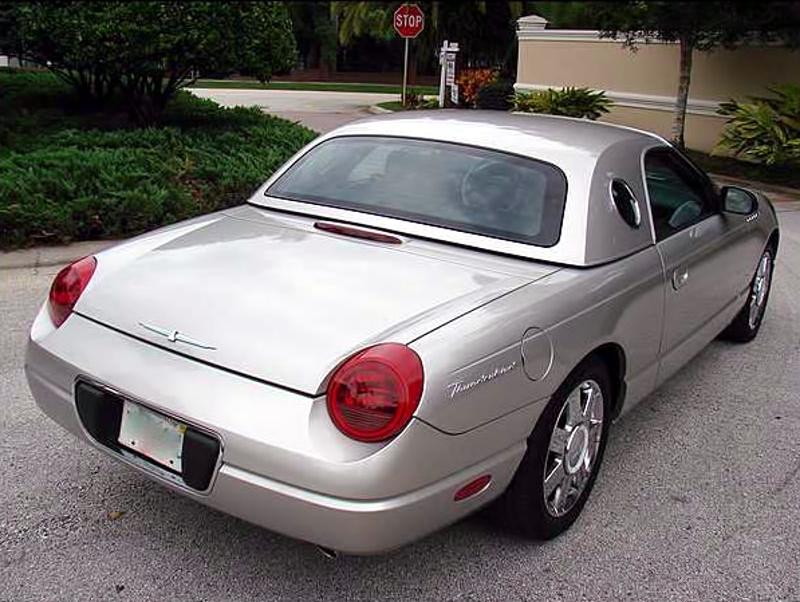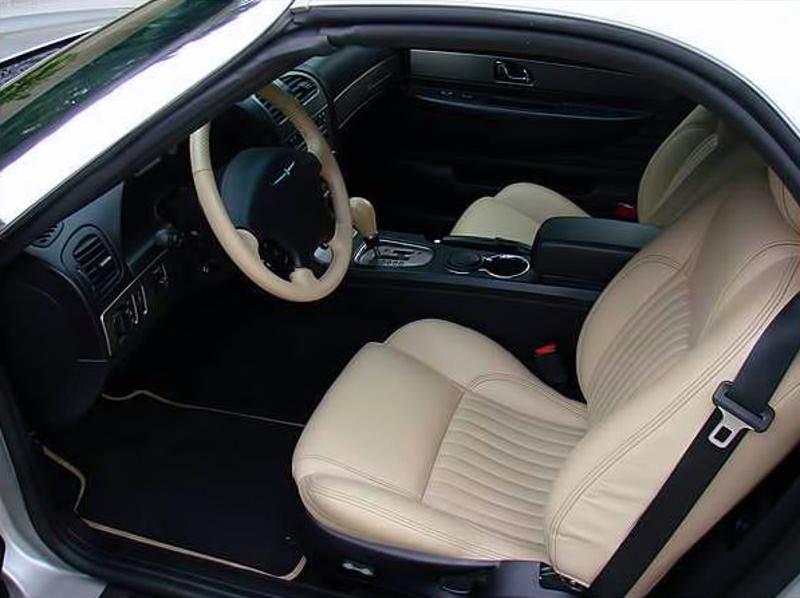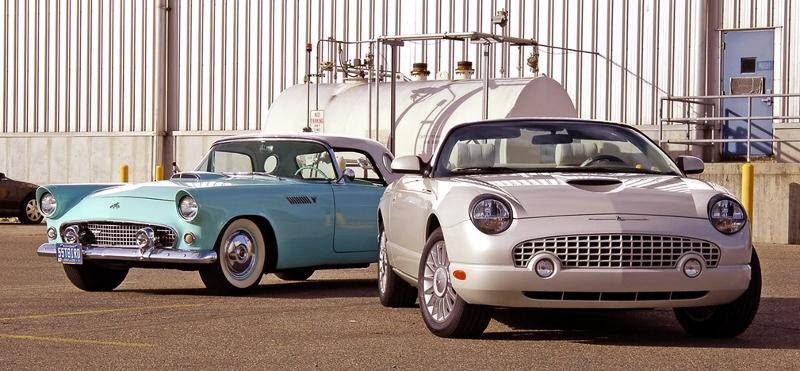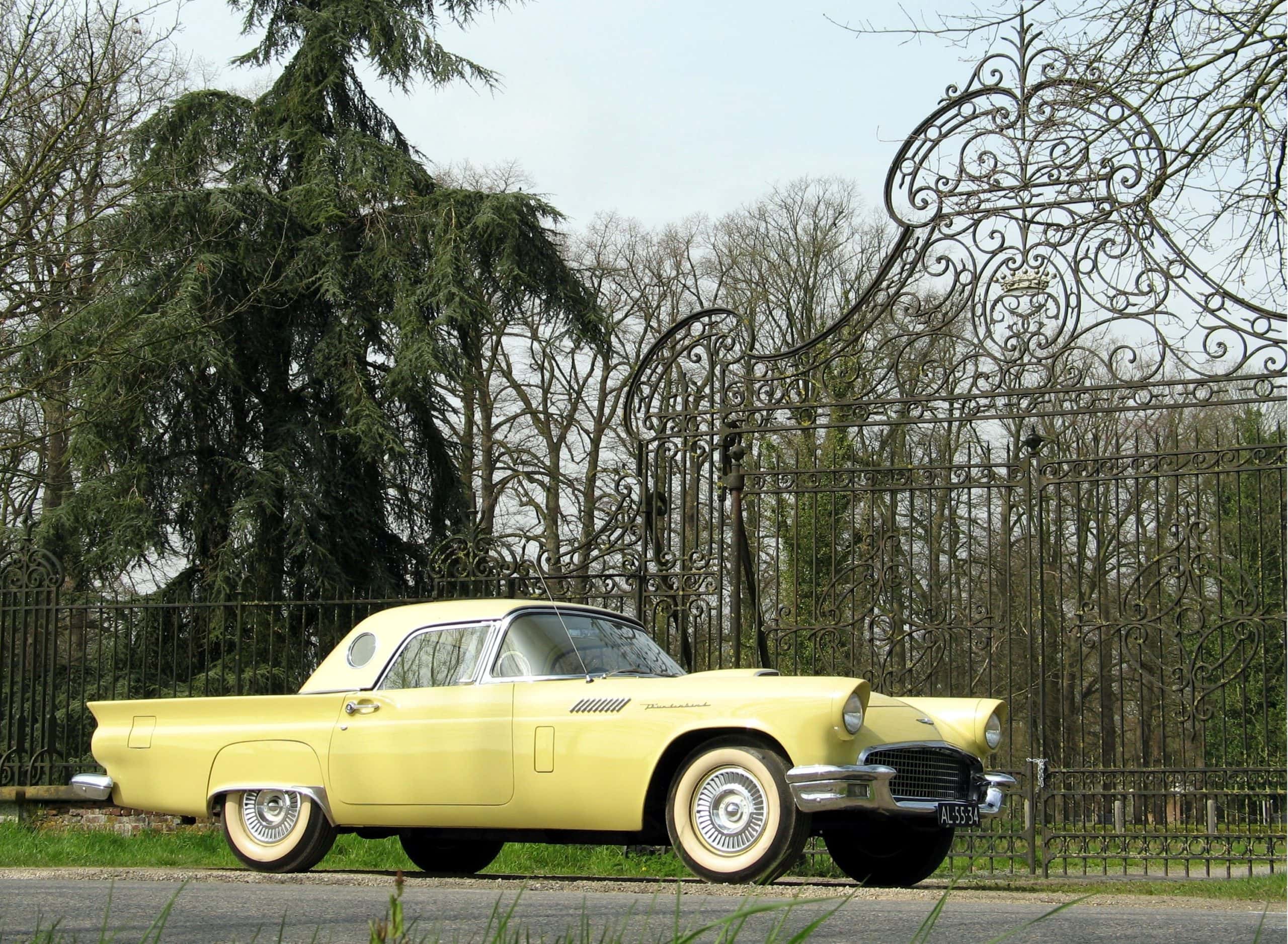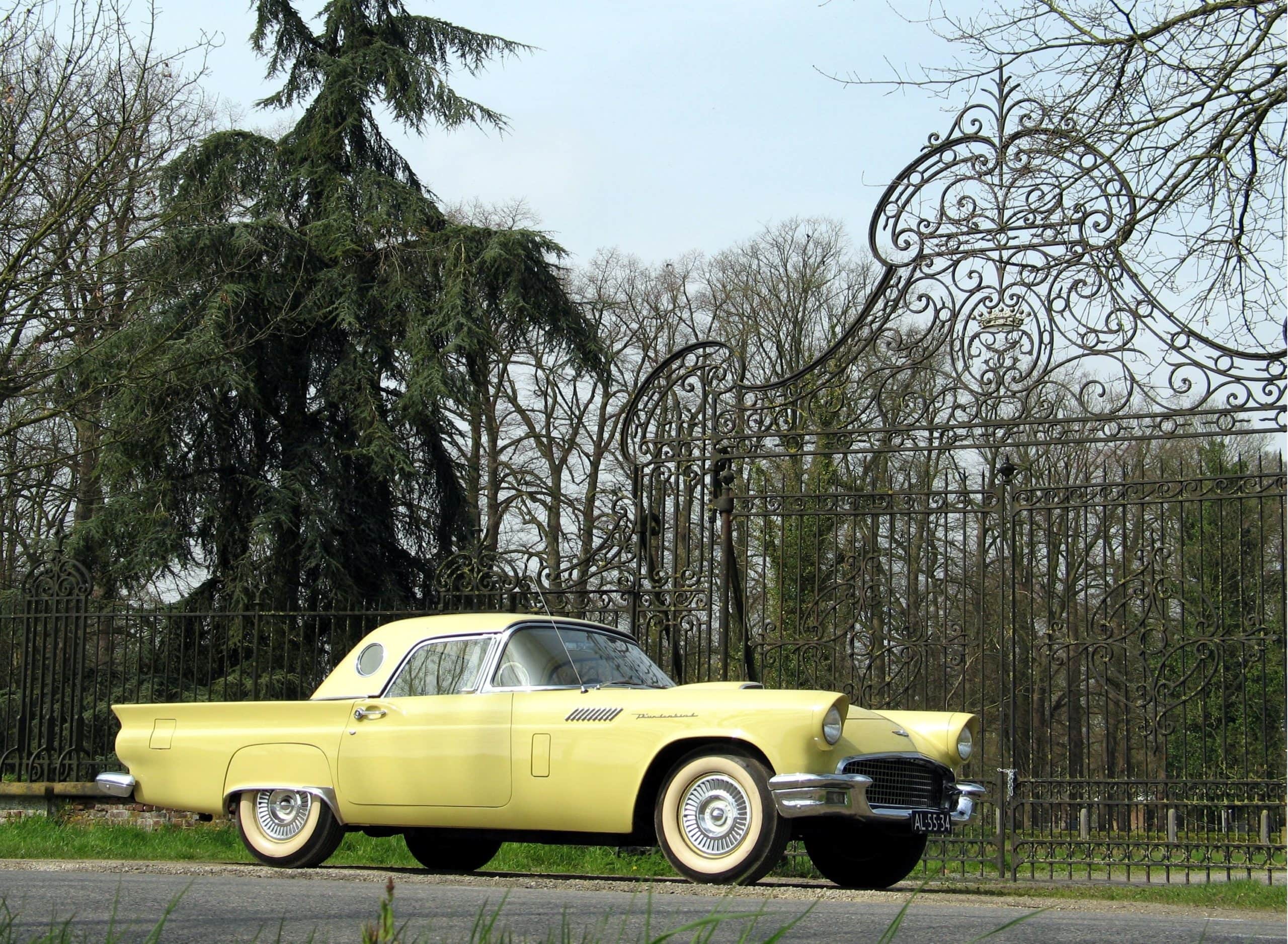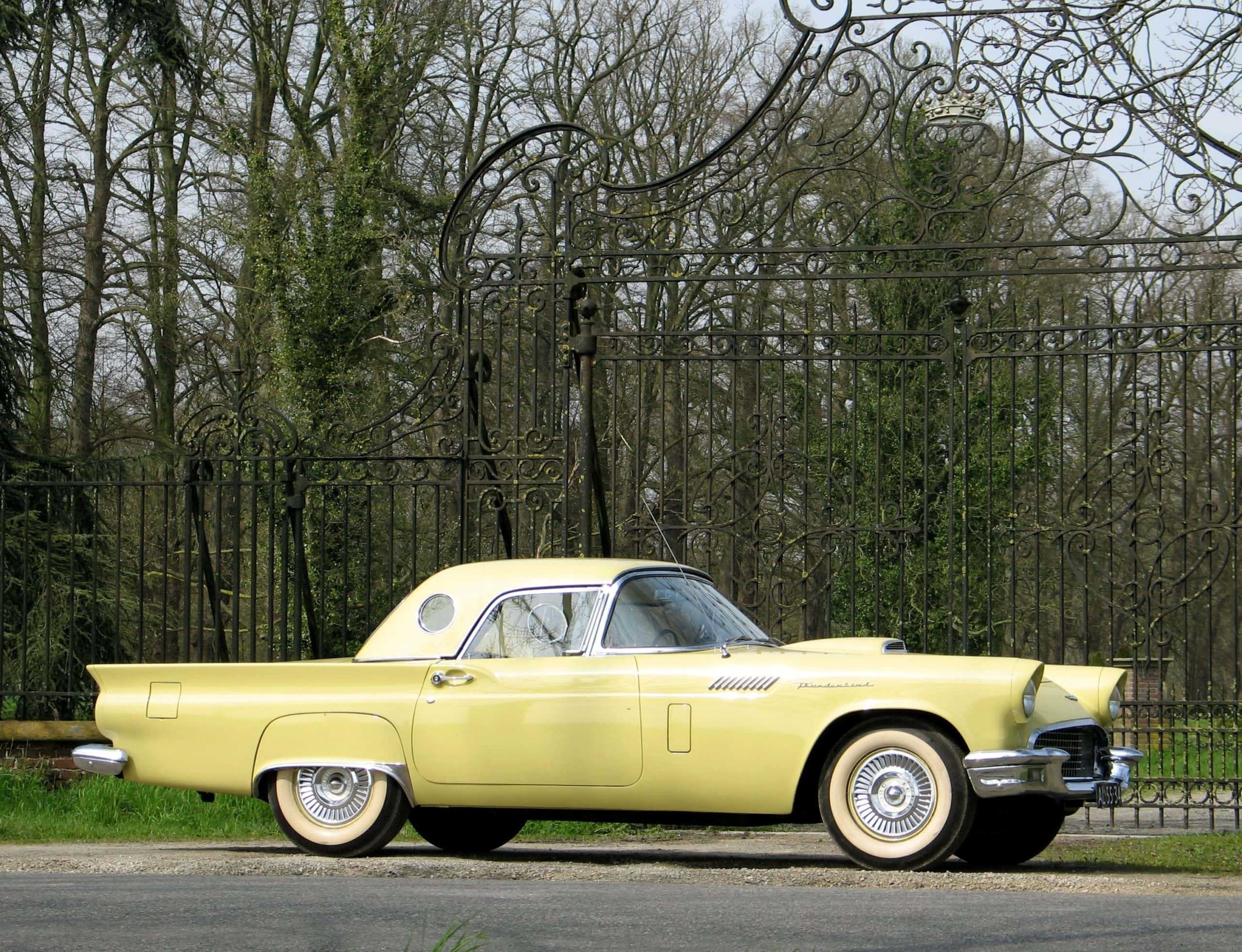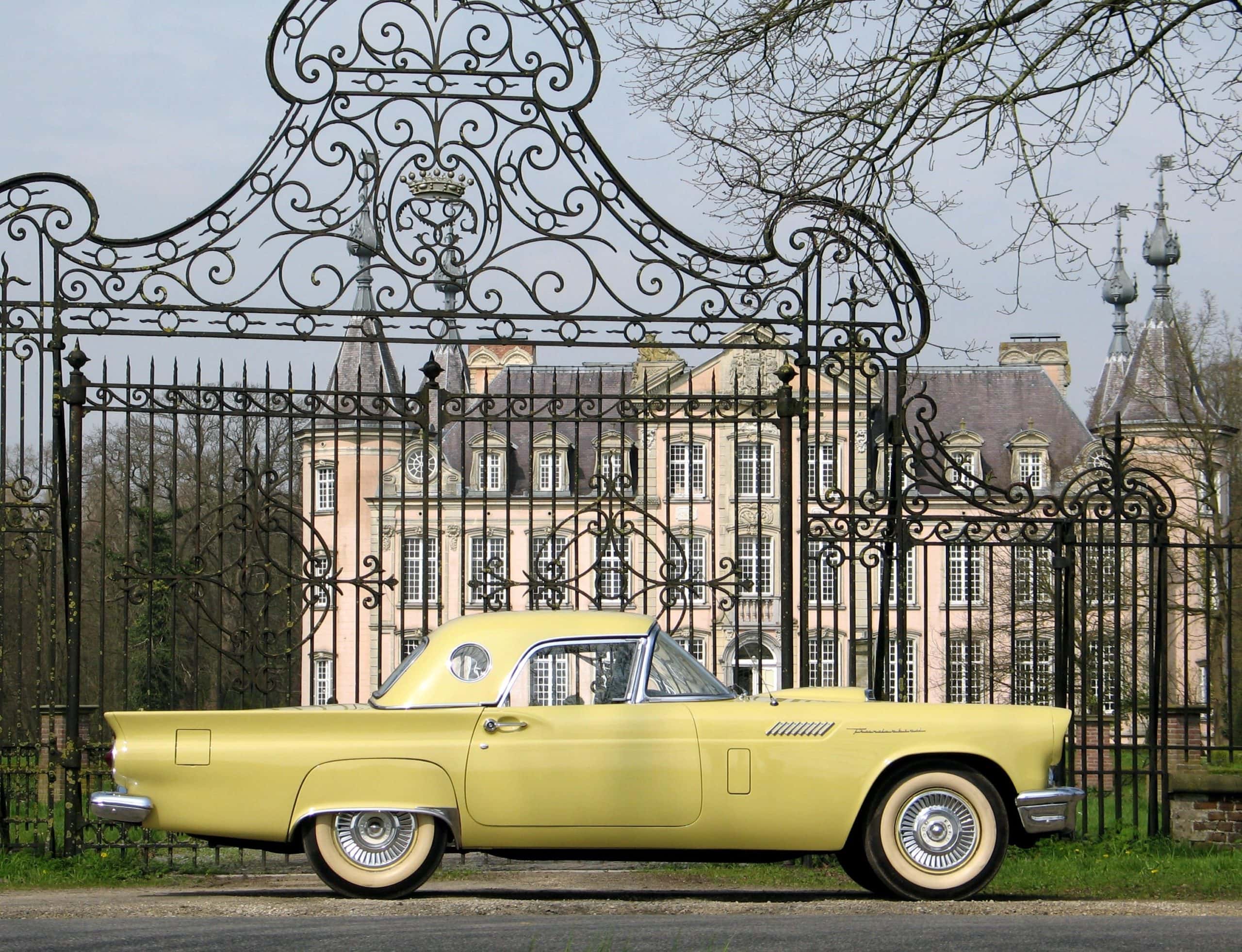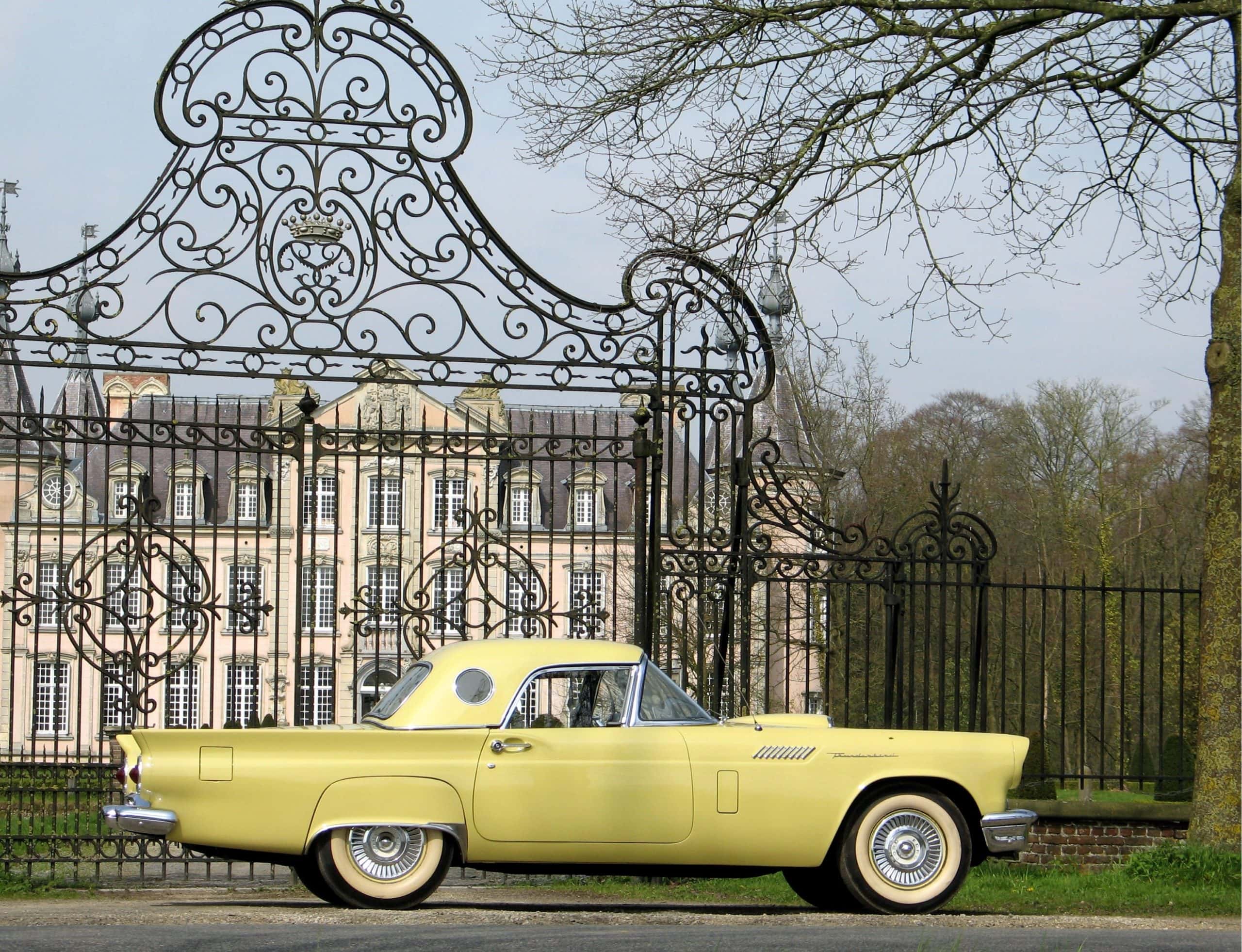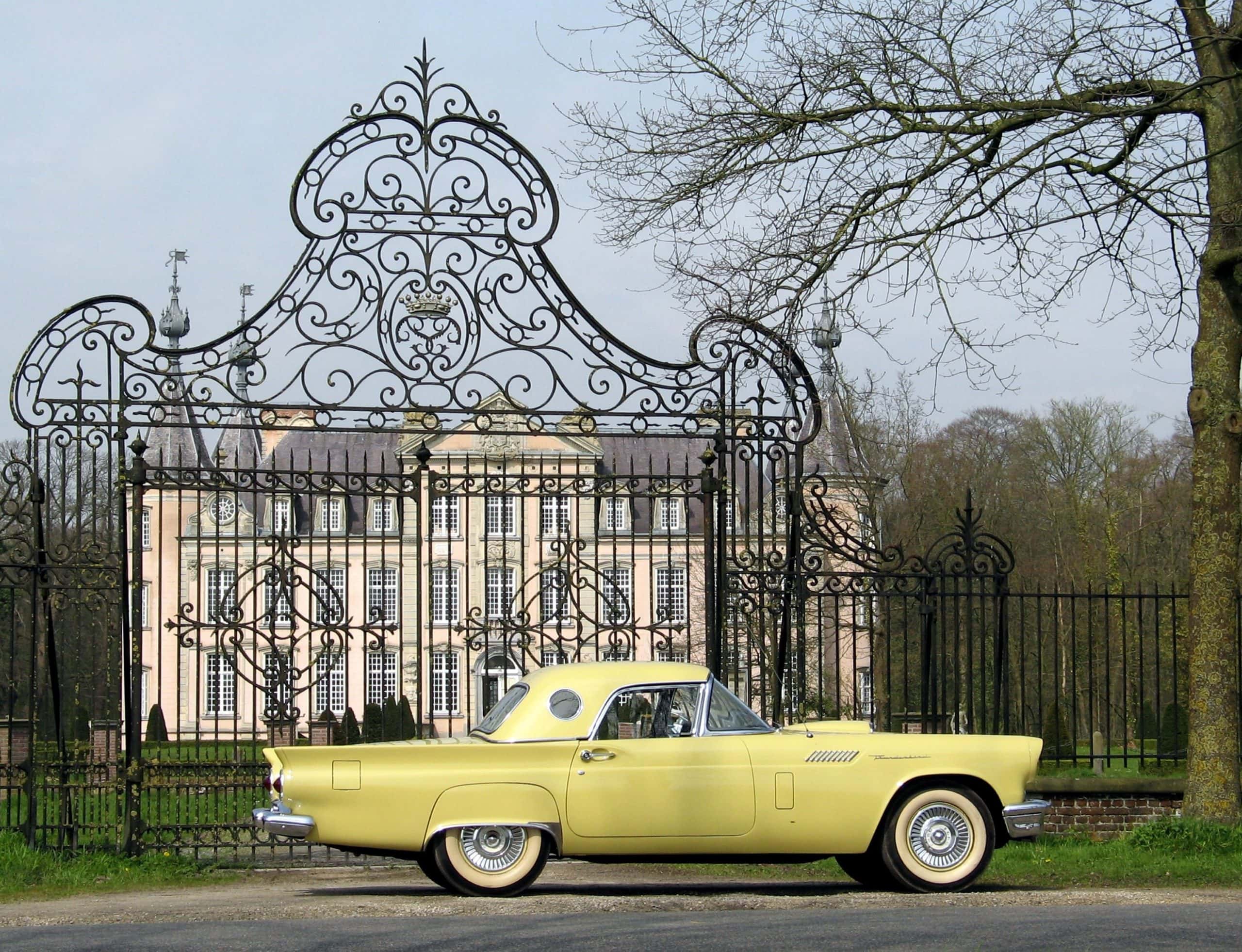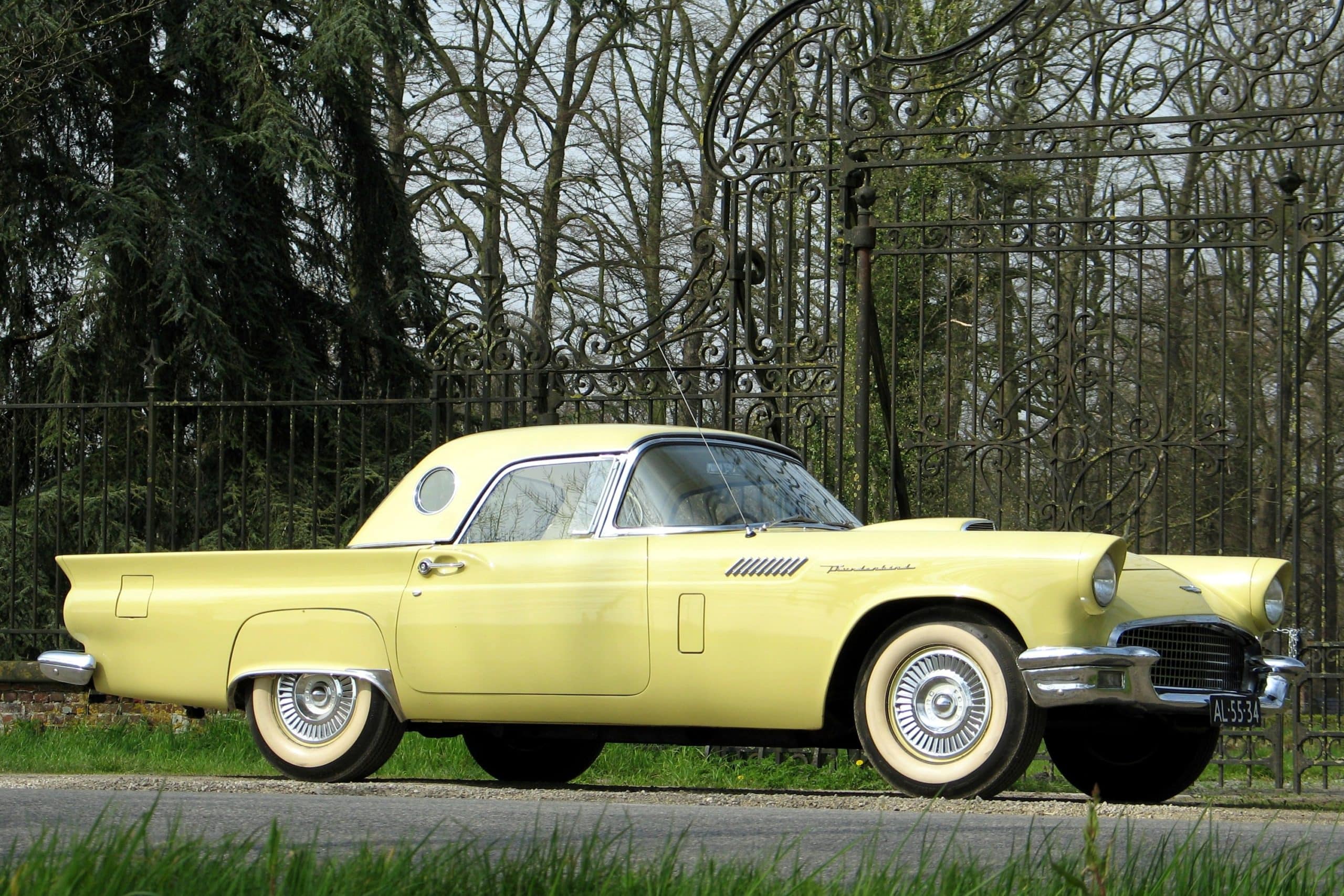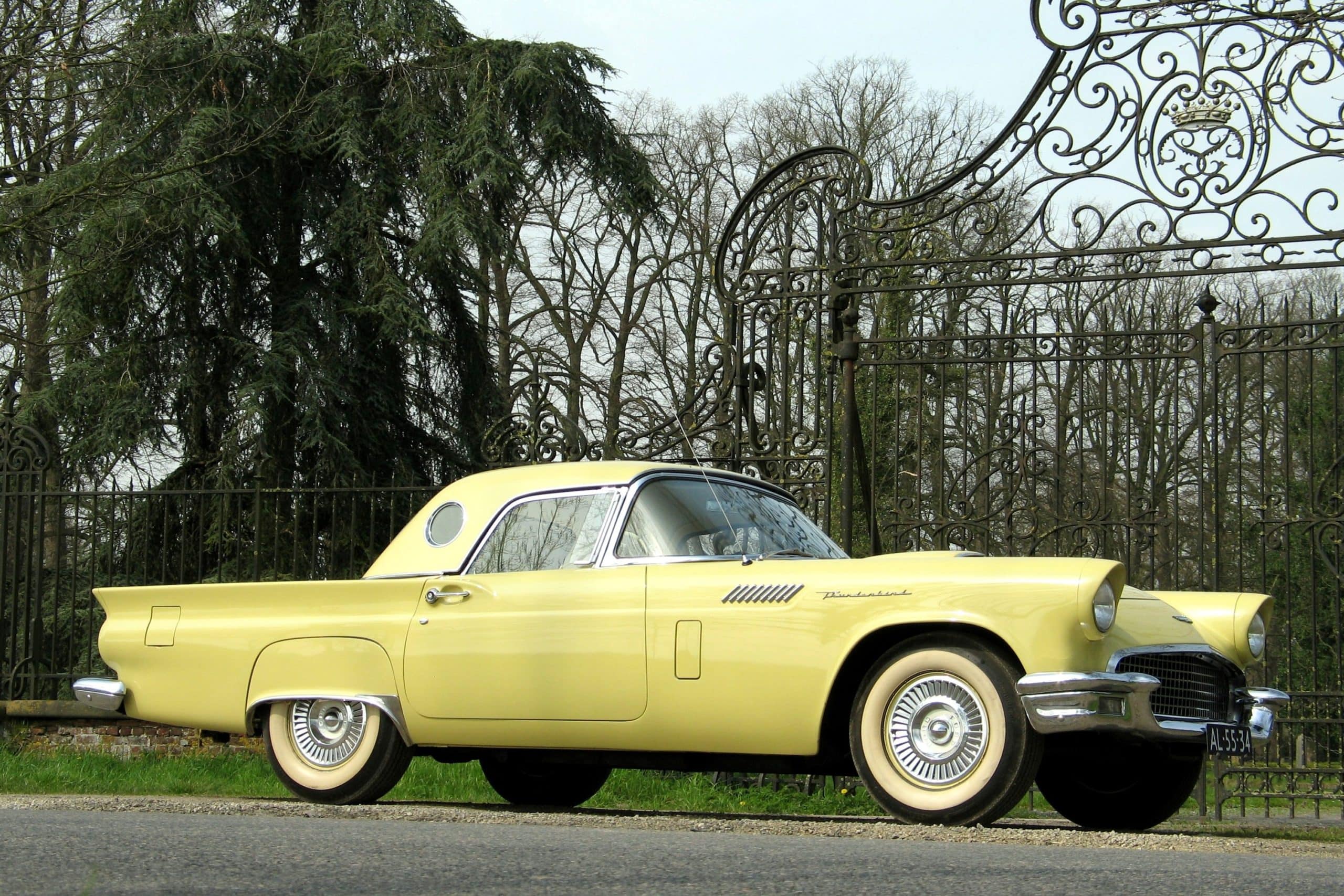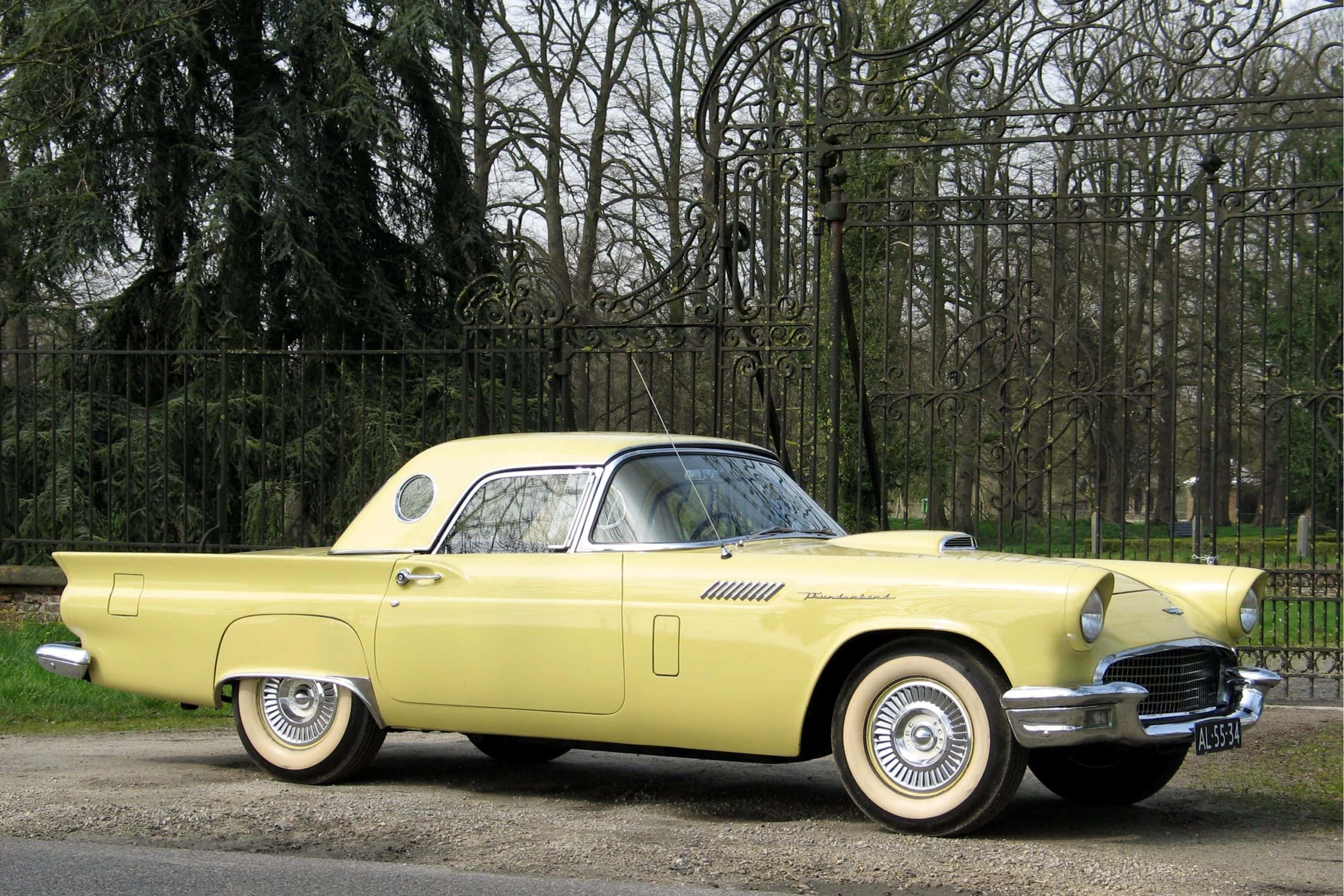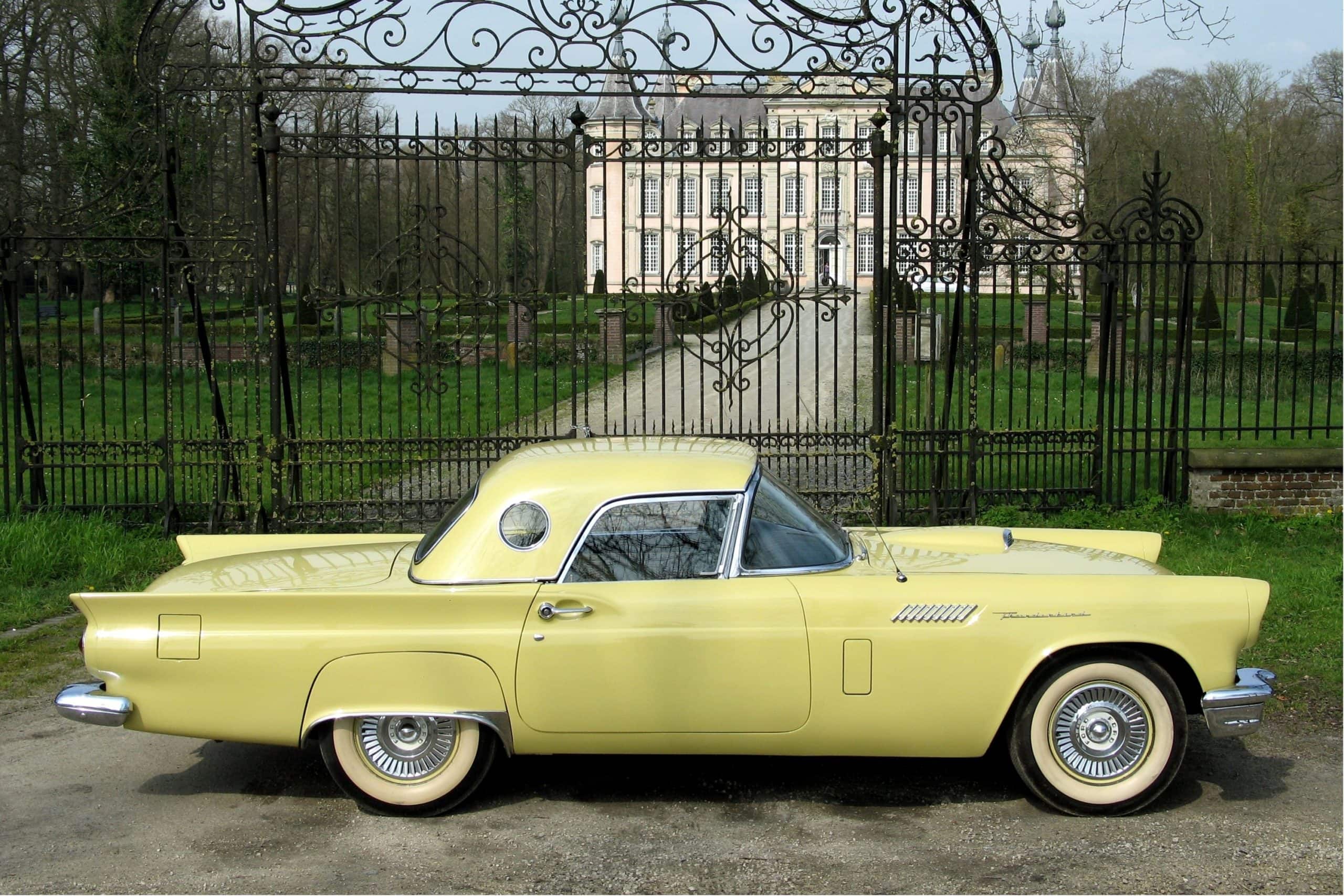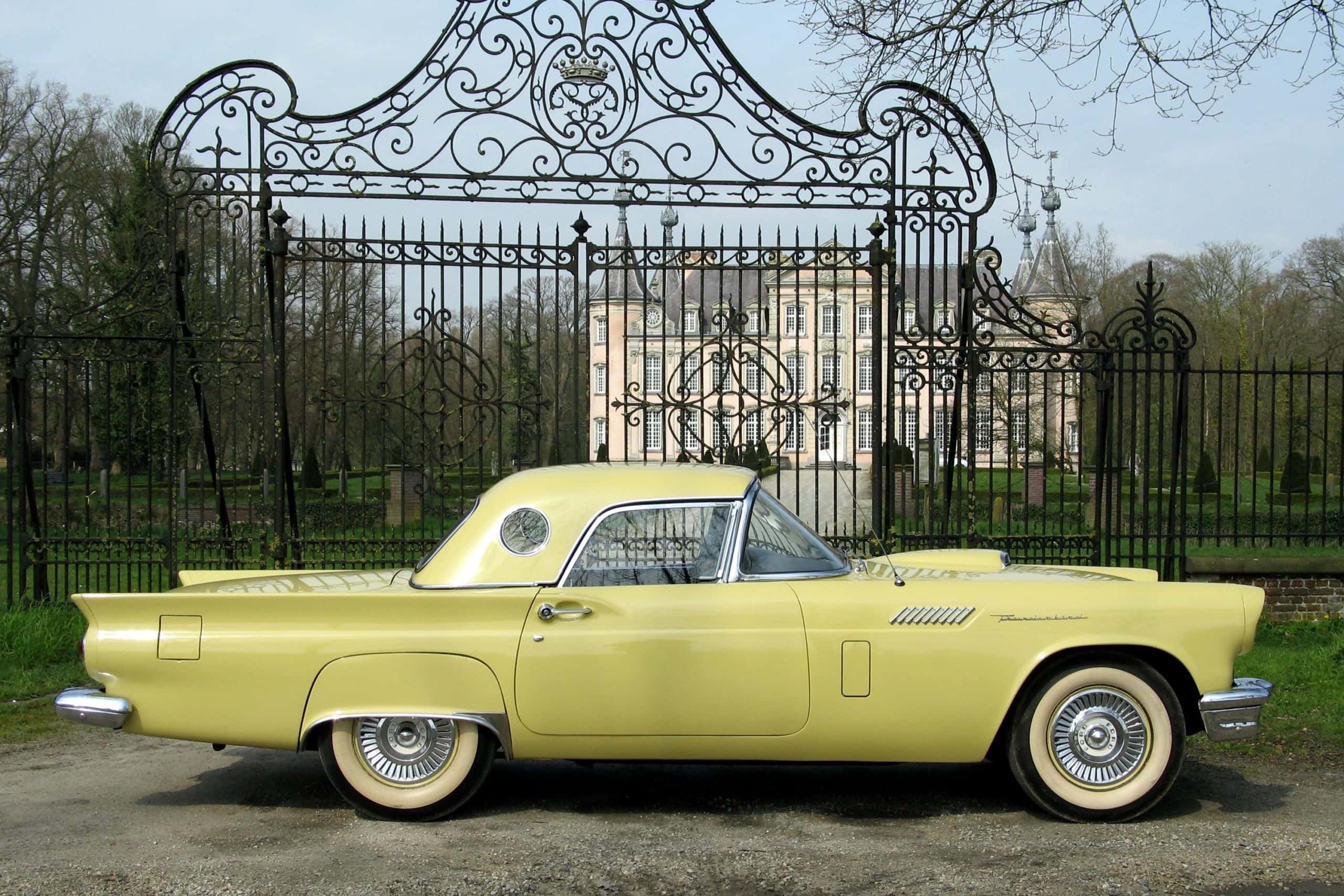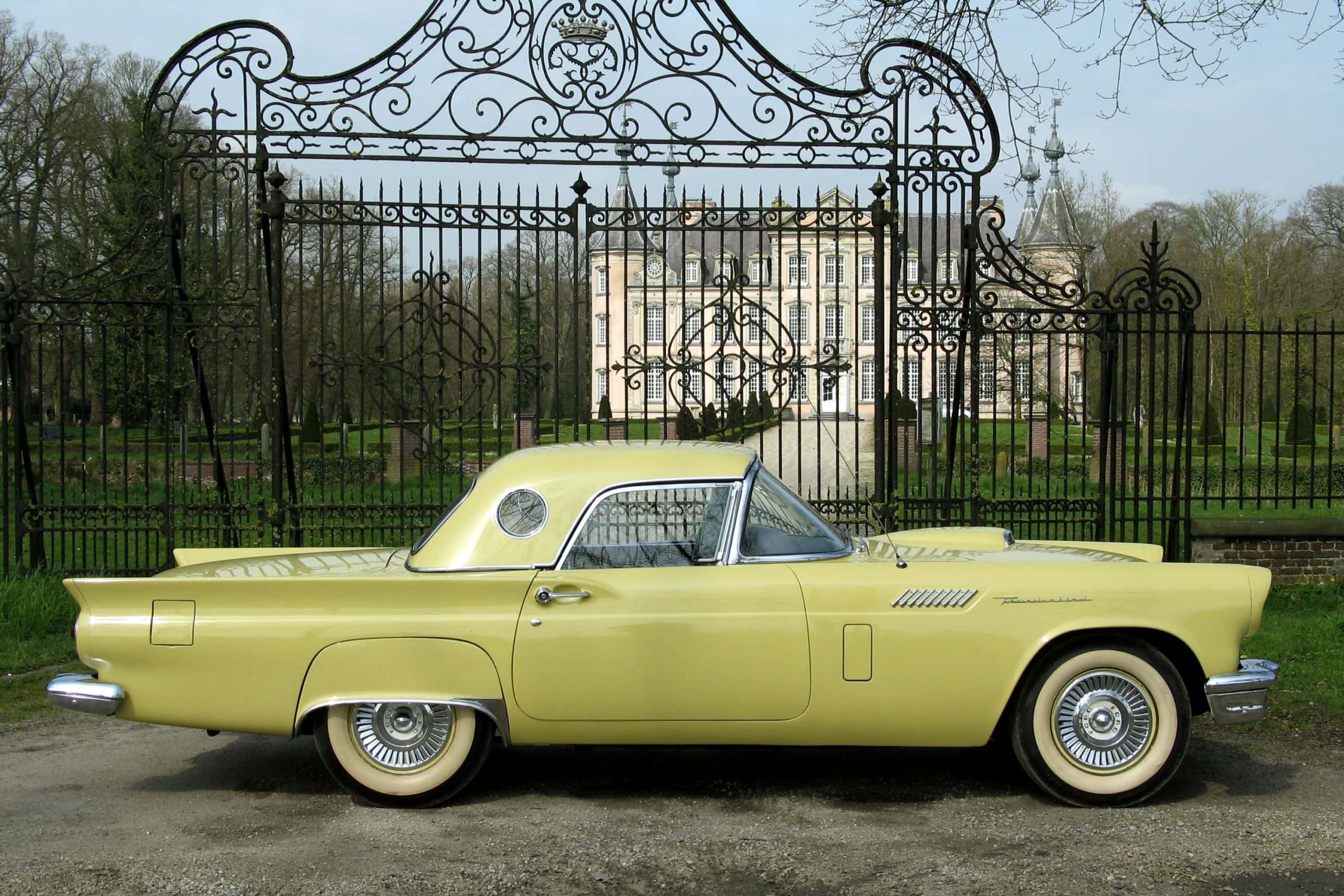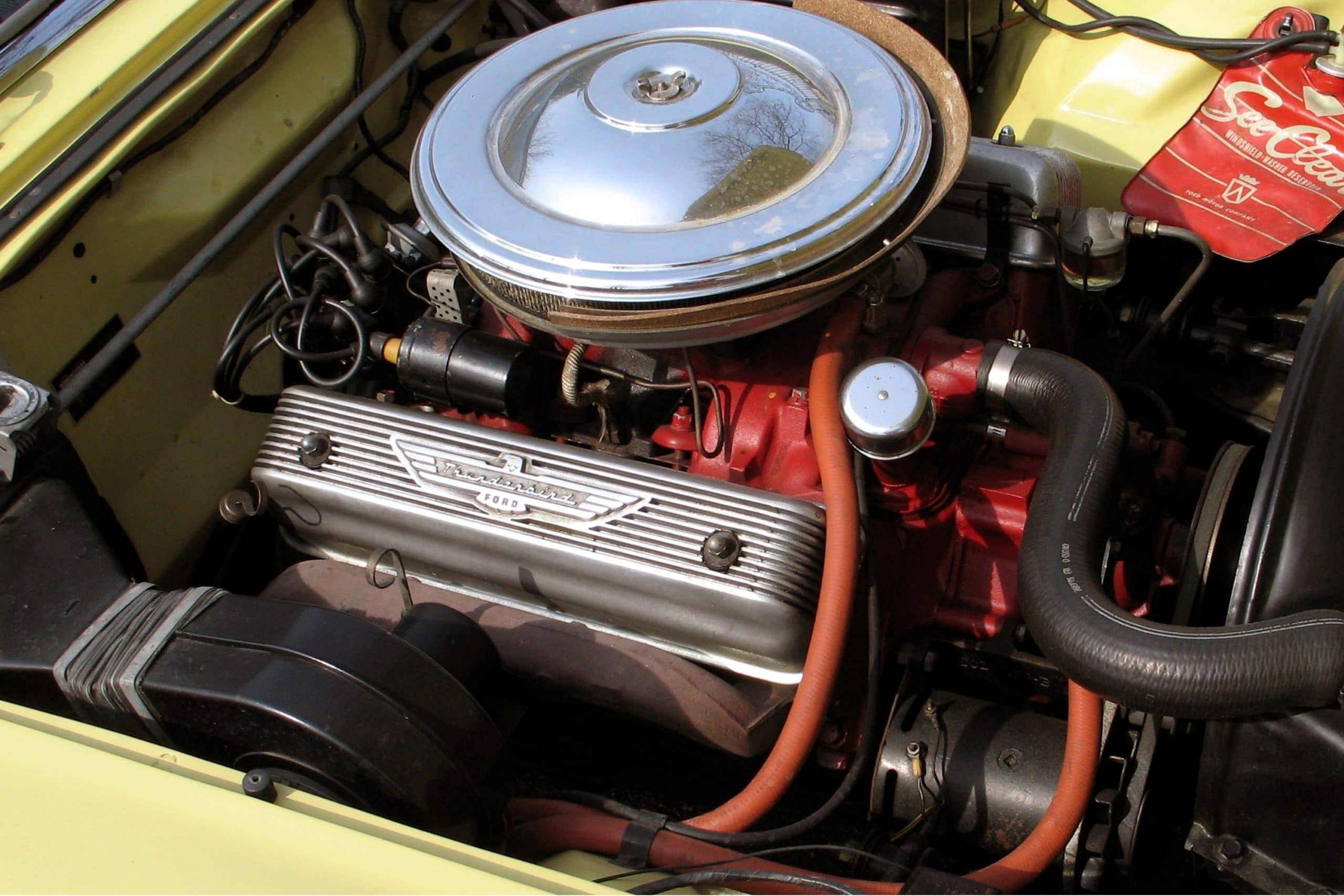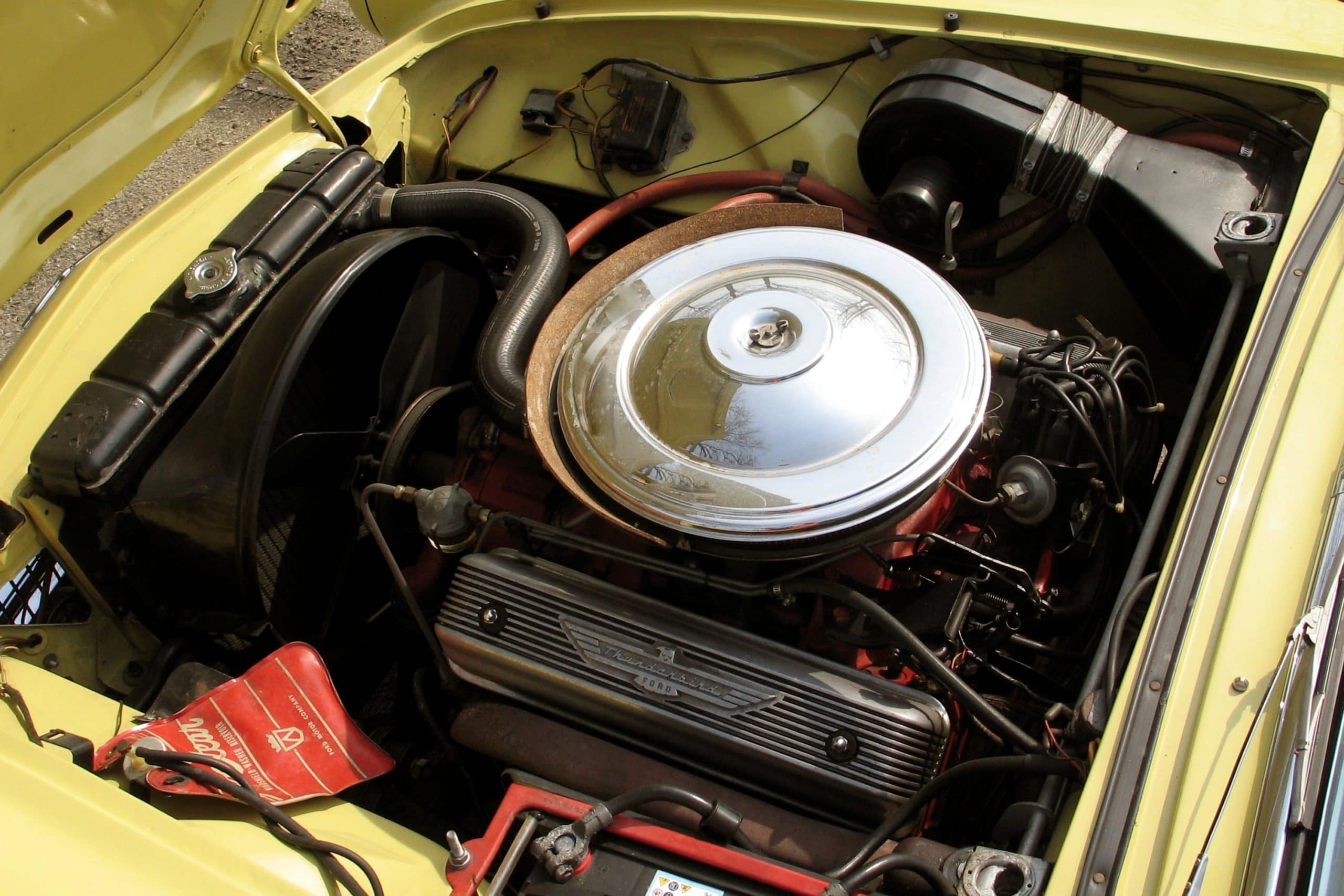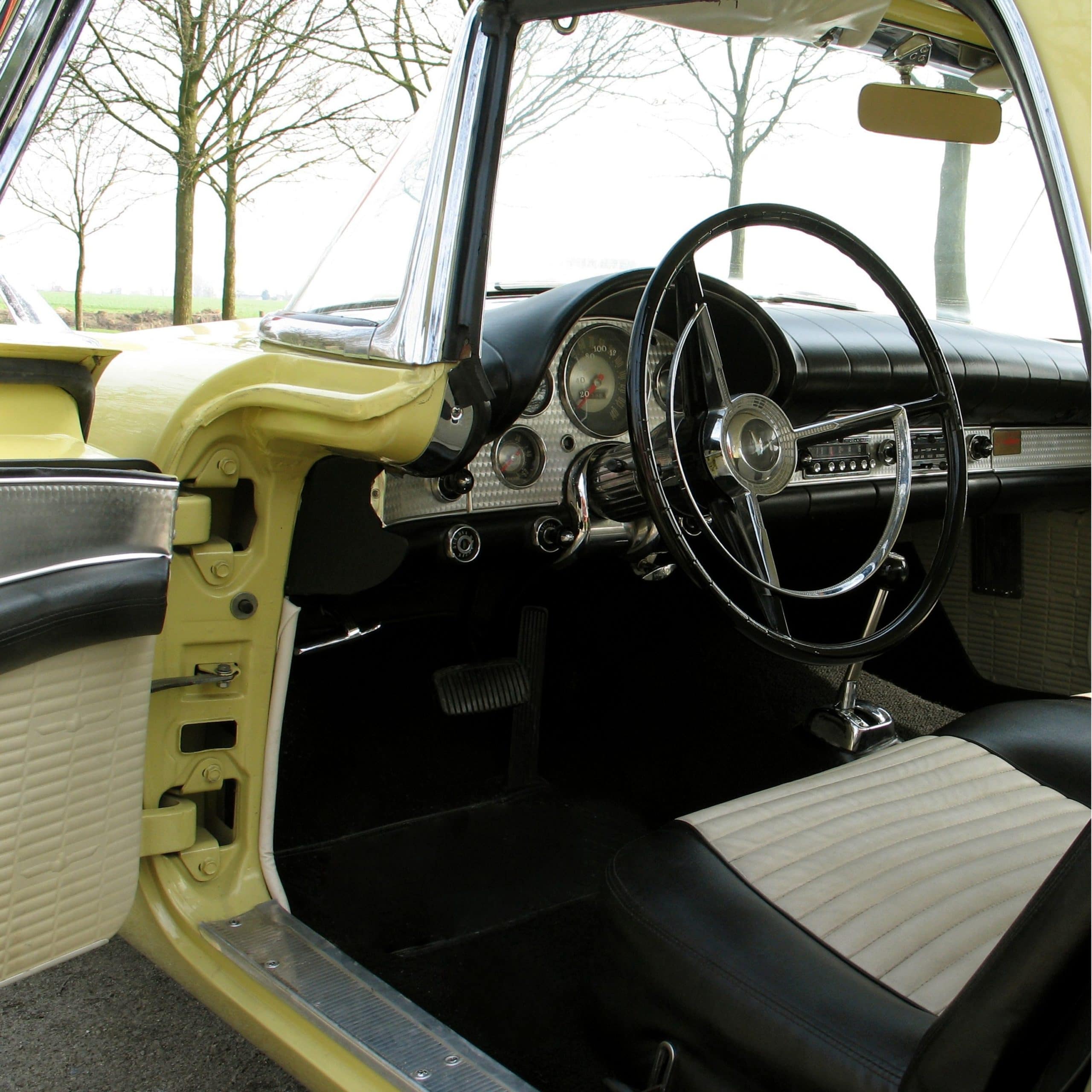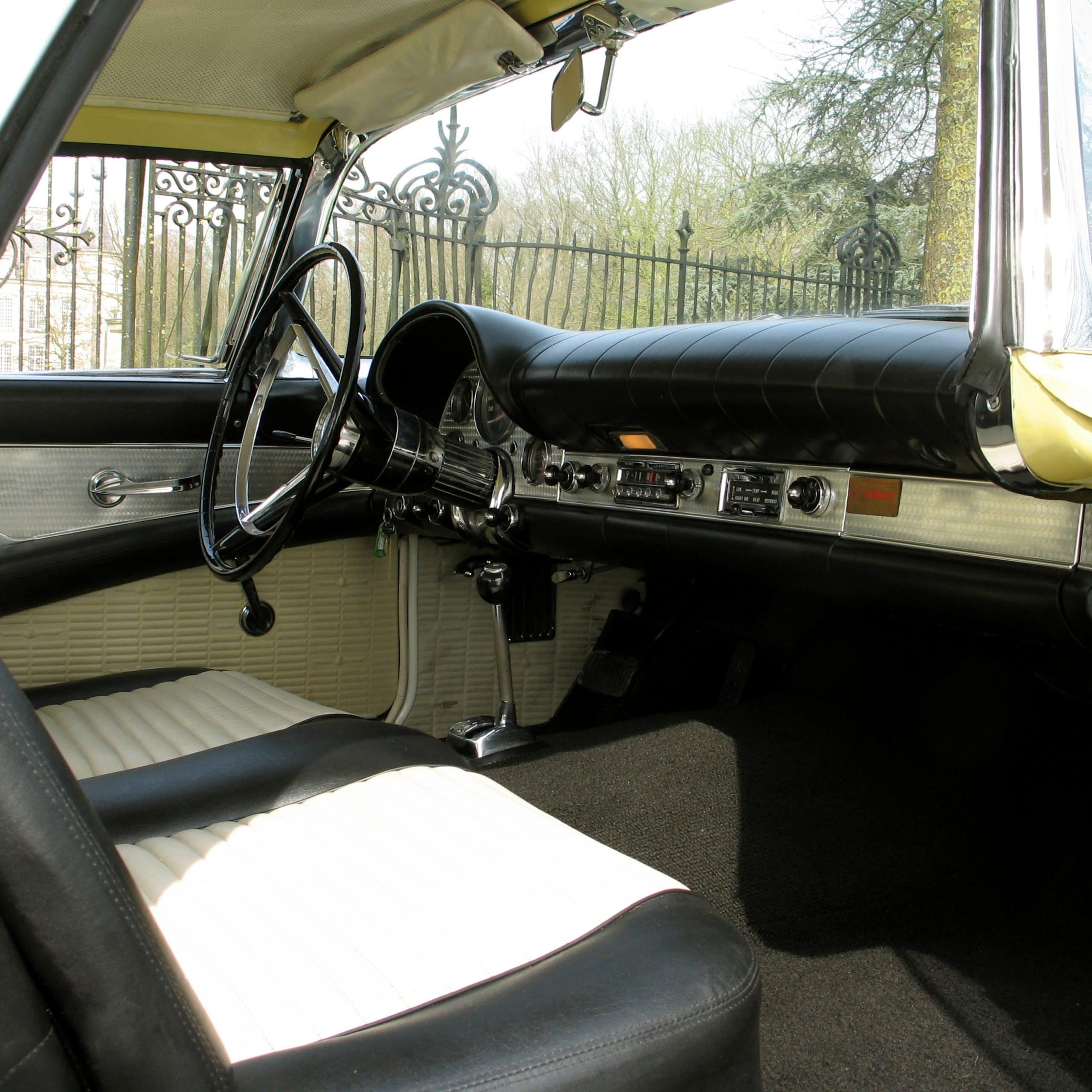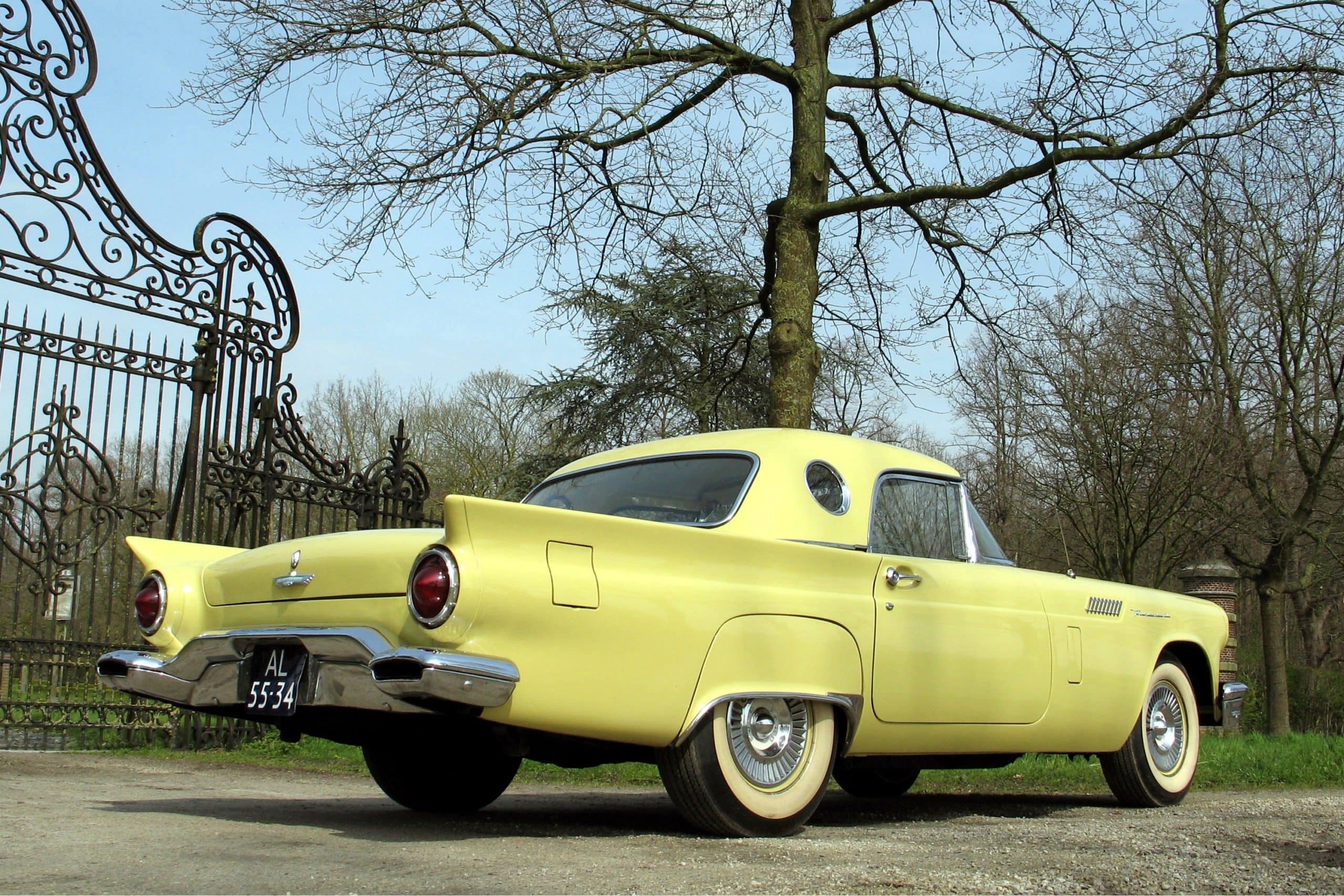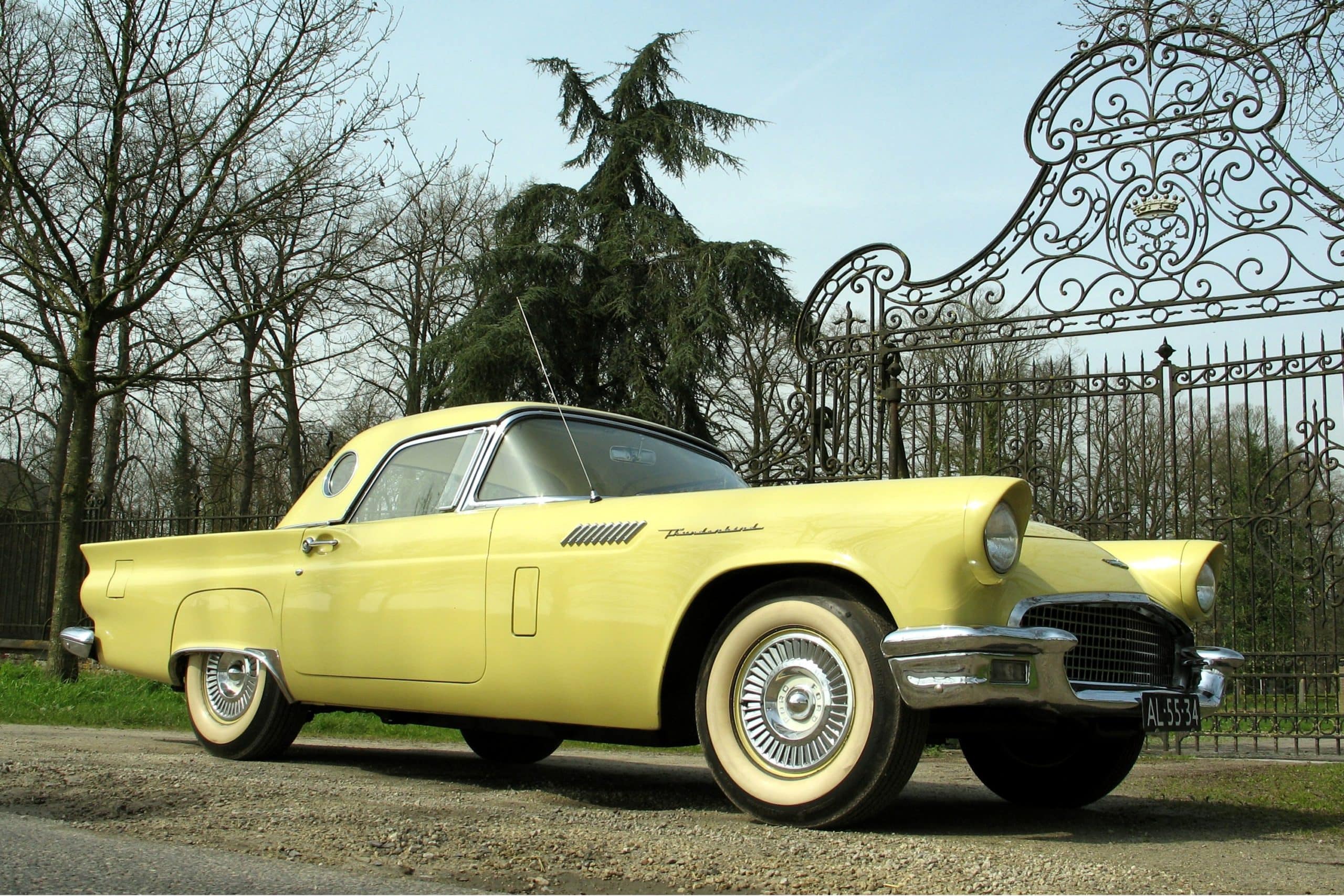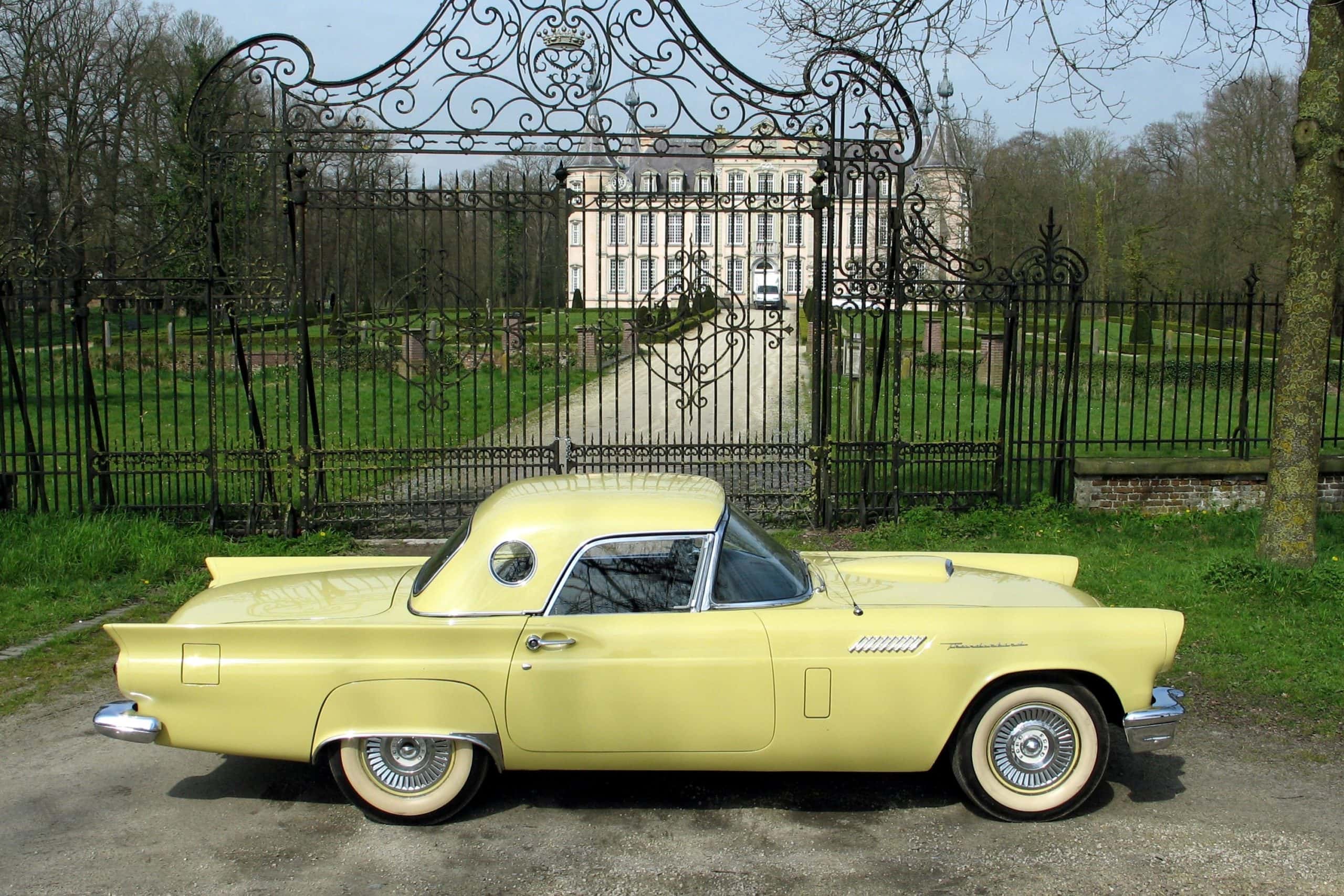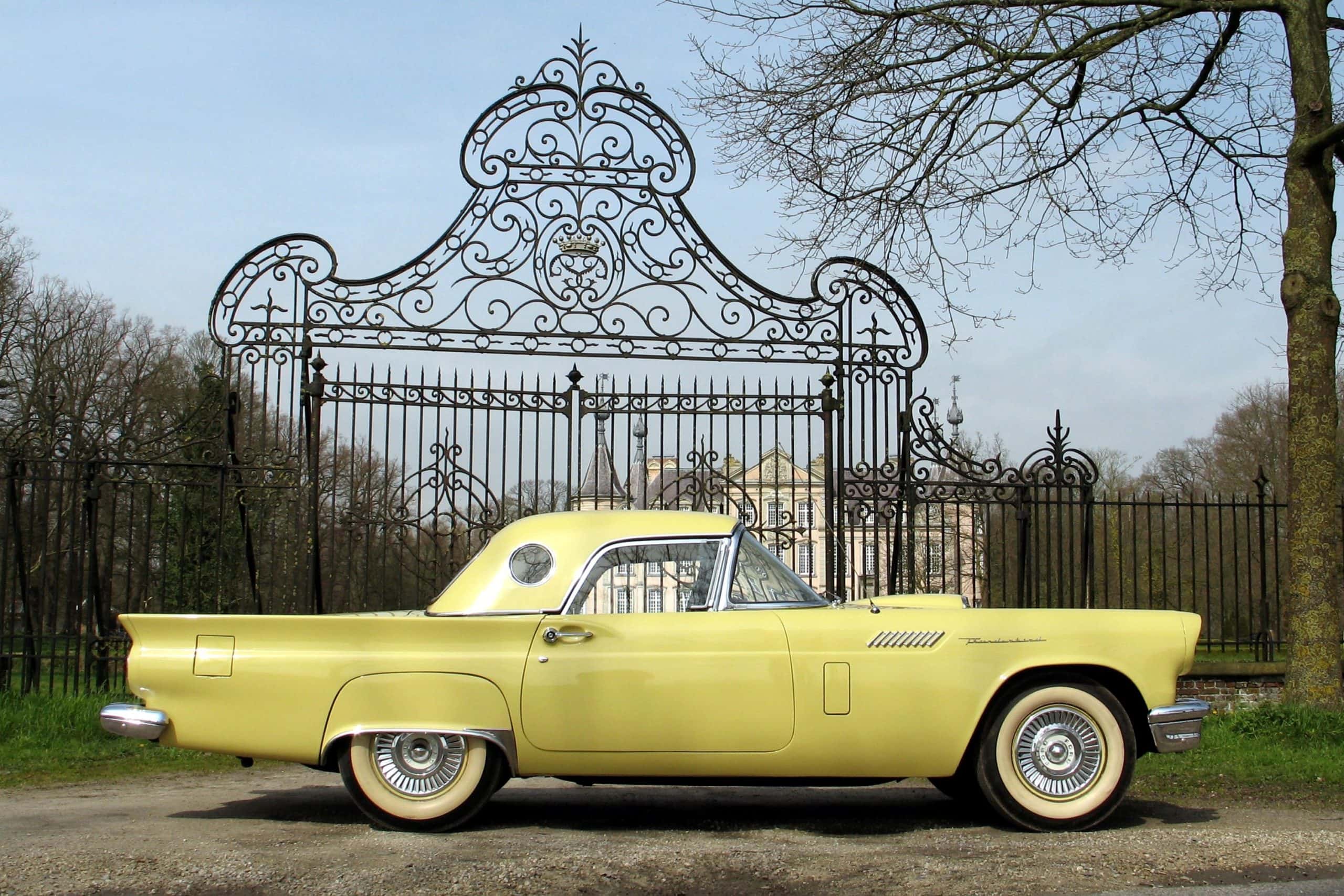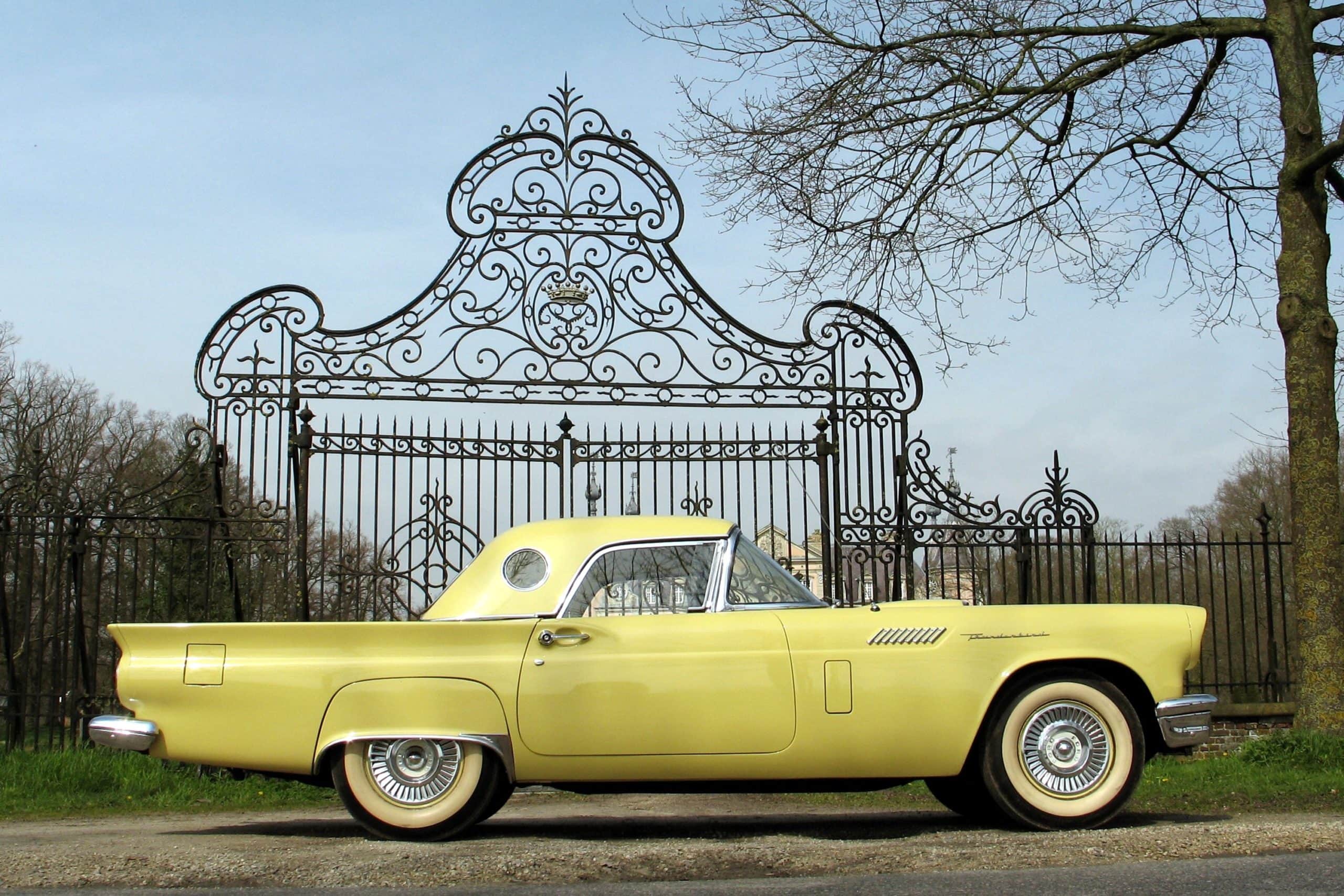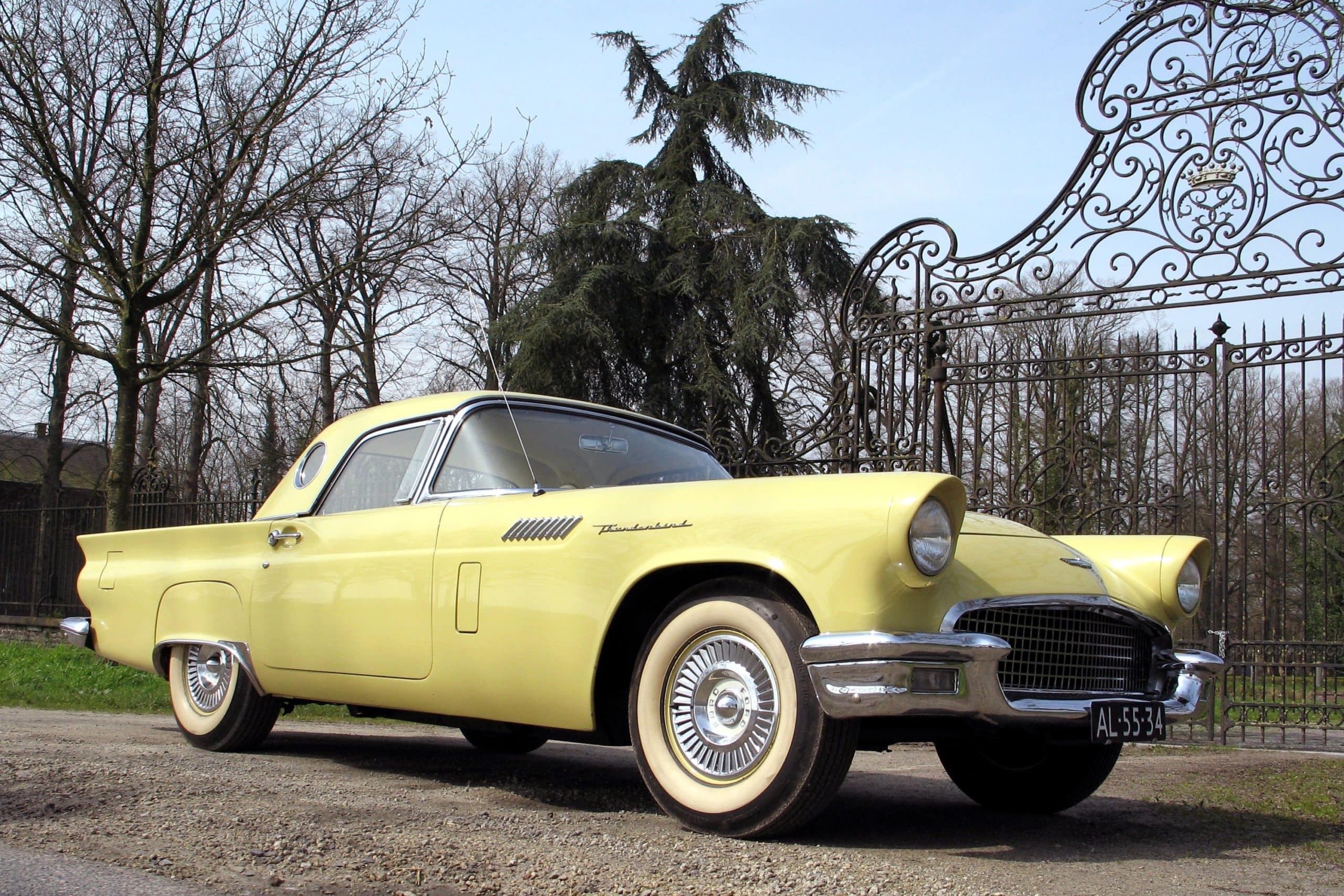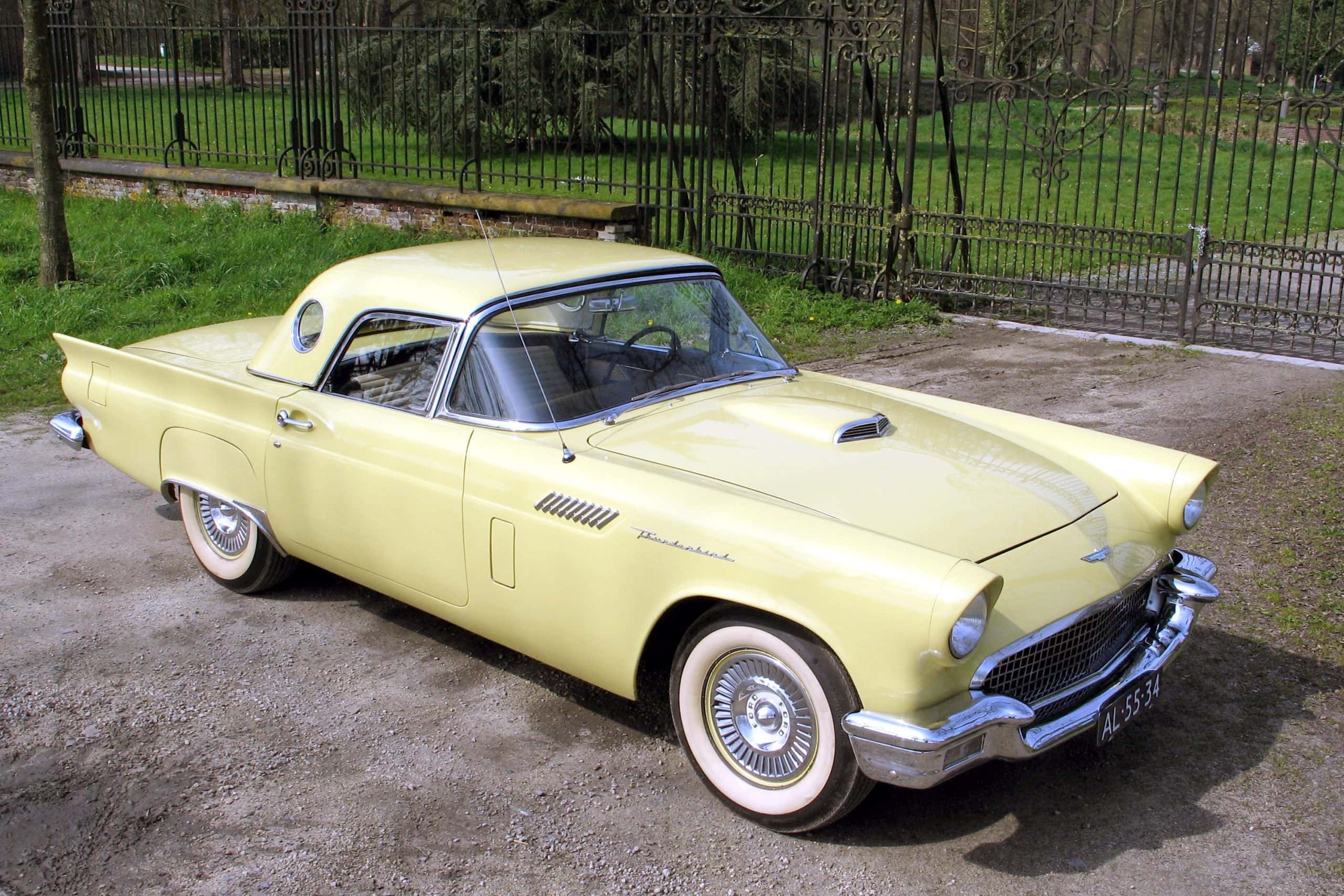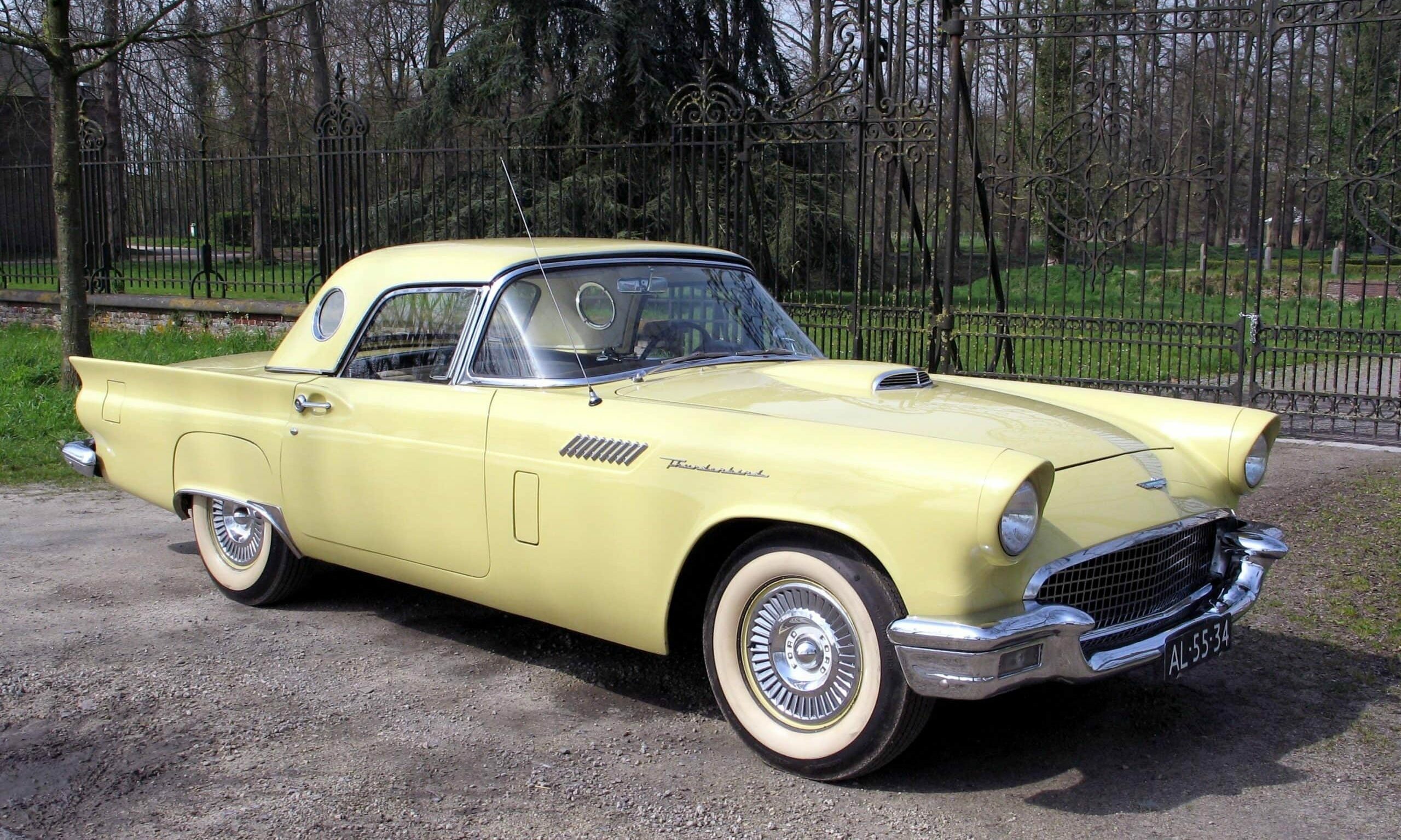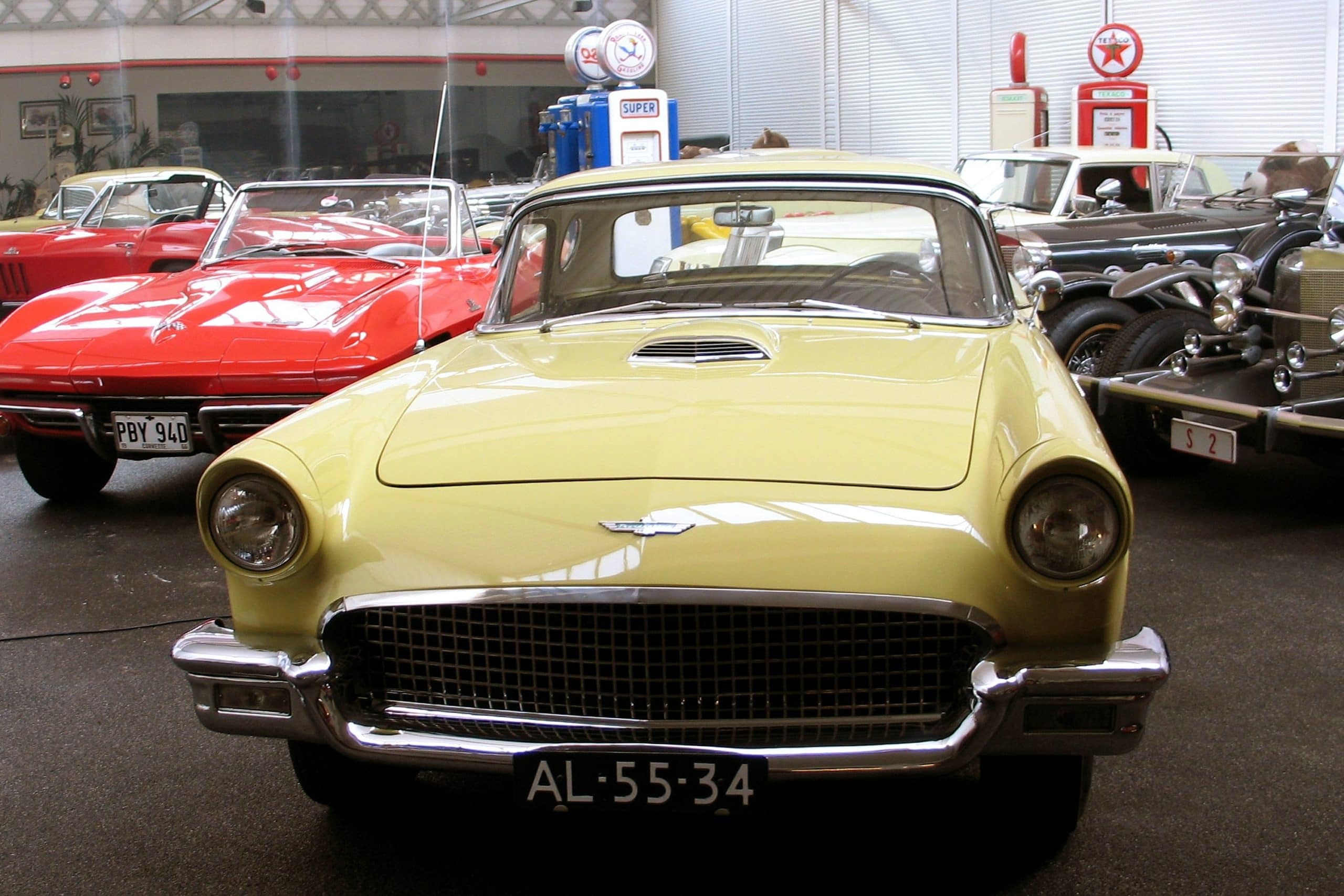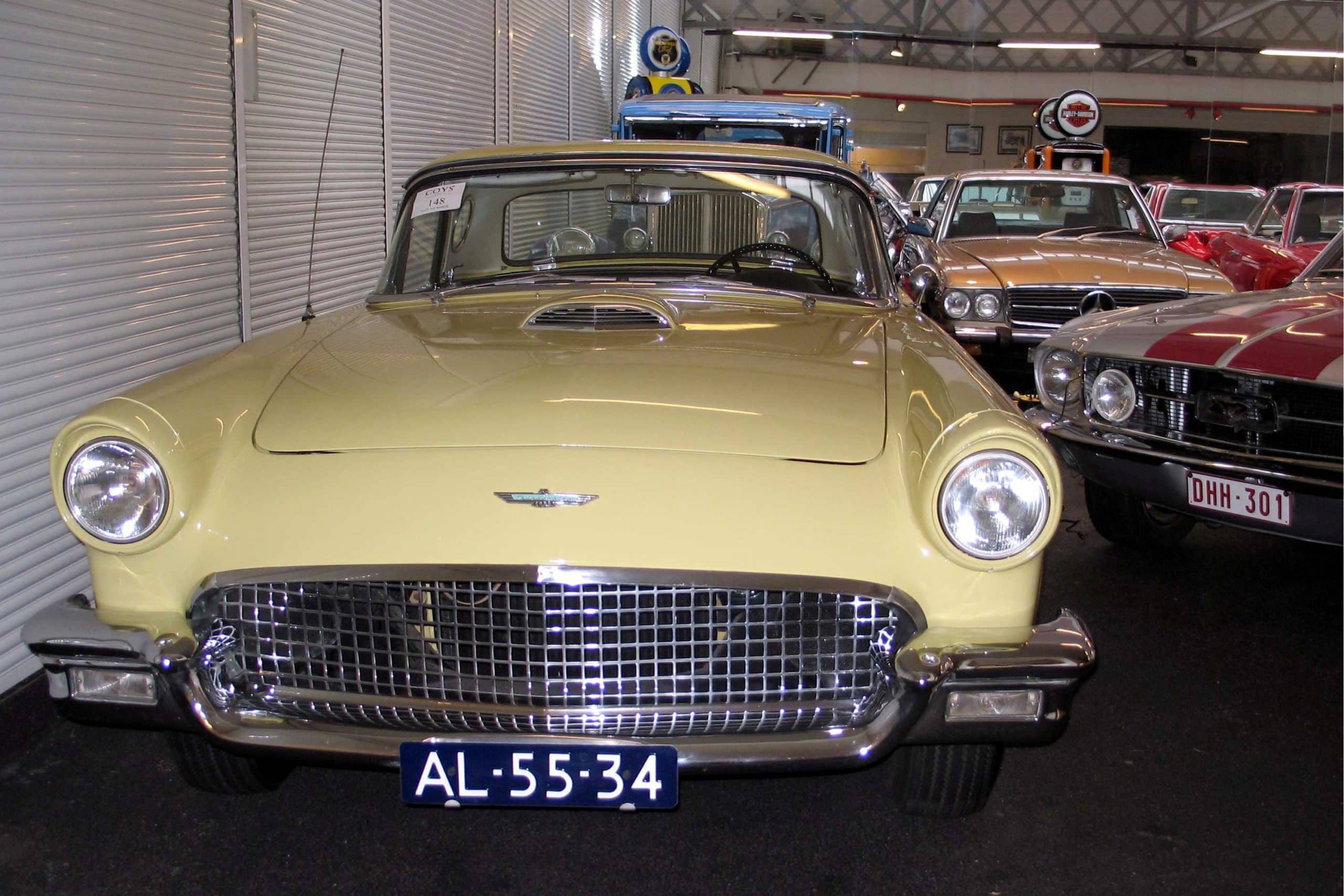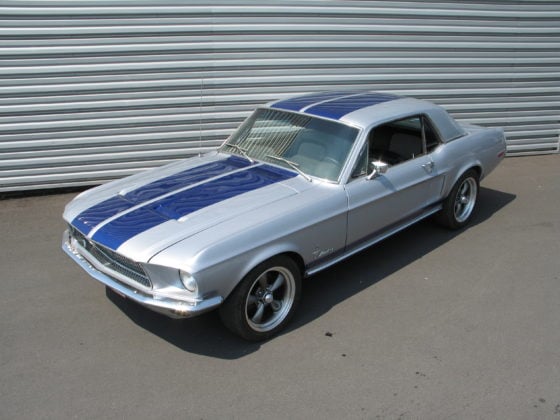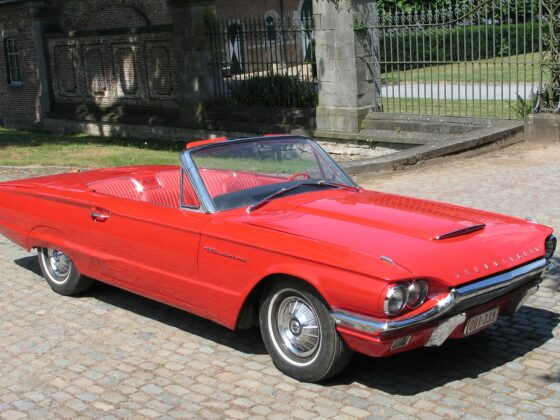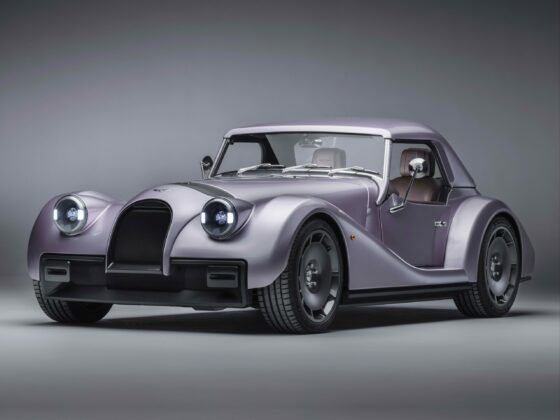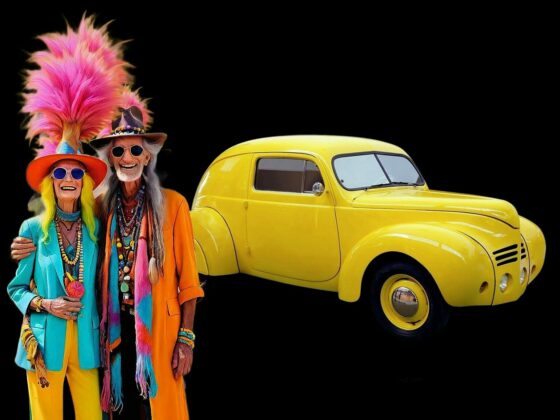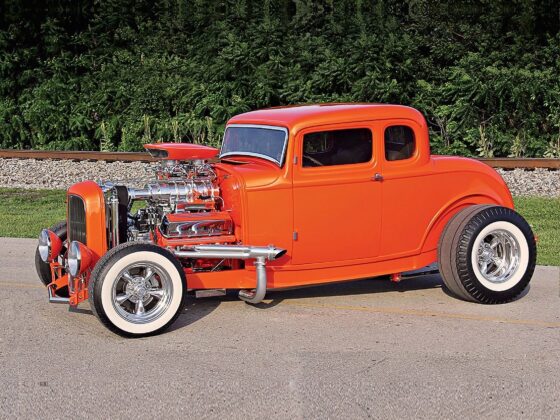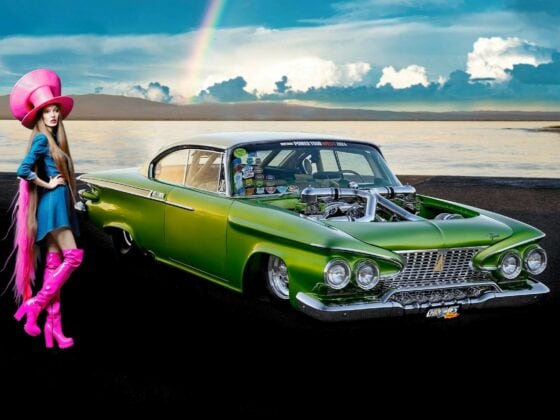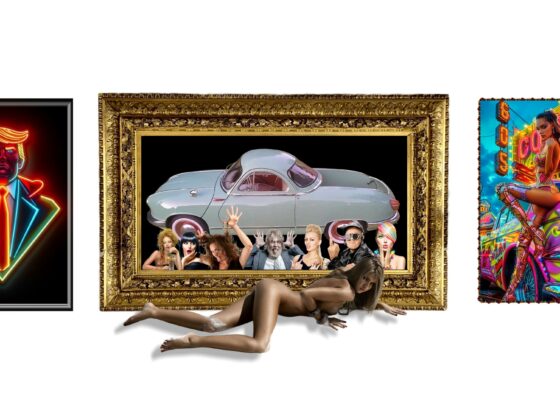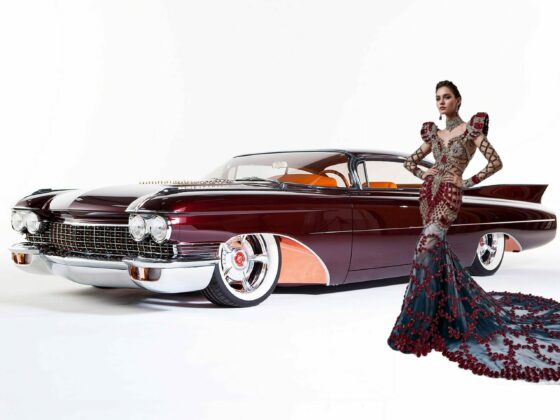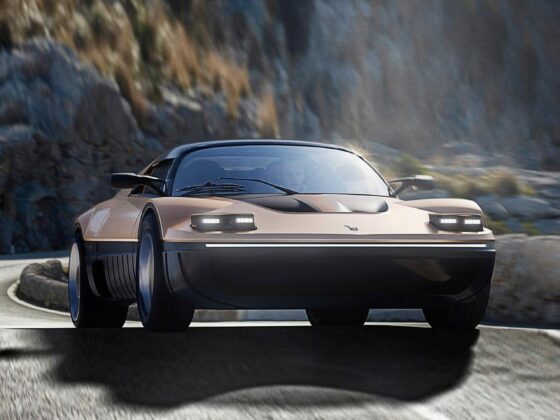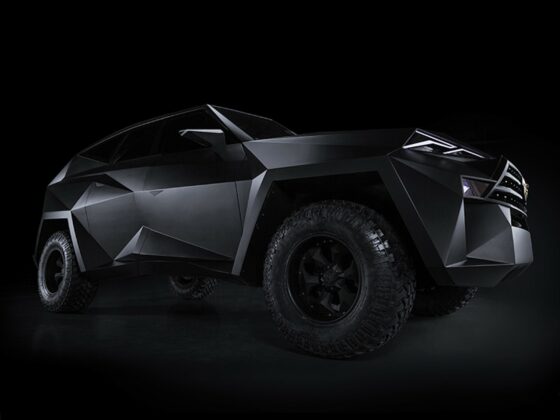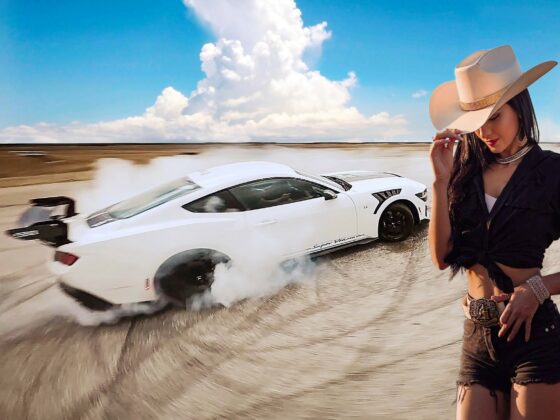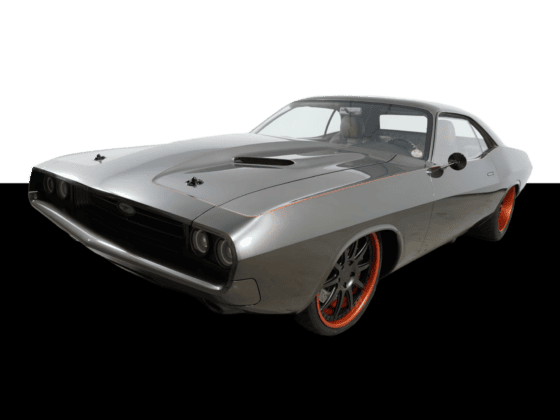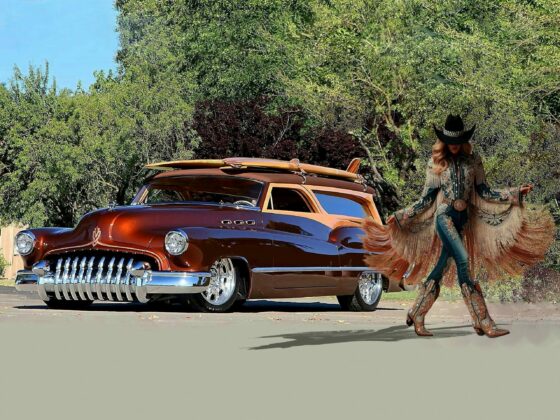1955/2005 Ford Thunderbirds…
Legend says the Thunderbird was born in October 1951, when Ford Division general manager Louis Crusoe visited the Paris Auto Show with styling consultant George Walker. America had a love affair with European sports cars in the early postwar years, and both men were taken by what they saw in Paris, especially the curvy Jaguar XK-120 and GM’s experimental two-seat LeSabre.
“Why don’t we have something like that?” Crusoe asked.
“Oh, but we do!” replied Walker…, who then hurried to phone Dearborn to get his troops cracking. But like many apocryphal stories, this one isn’t true.
1955, 1956, 1957, Ford Thunderbirds…
Frank Hershey, who headed the team that styled the original ’55 T-Bird, said Ford had been conjuring two-seaters well before this, but never felt rushed to build one because sports-car sales only amounted to a minuscule 0.27 percent of the total U.S. market.
But in January 1953, GM threw down a gauntlet Ford couldn’t ignore: the Chevrolet Corvette.
Barely a month later, Ford was hard at work on the car that would ultimately be named for the god worshiped by America’s Southwest Native Americans as the bringer of rain and prosperity.
First displayed as a wood mock-up at the Detroit show in early 1954, the Thunderbird was a “personal” car, not a pure sports car.
It rode the same wheelbase as the first-generation Corvette (102 inches) but was far more luxurious and practical. In place of creaking fiberglass and clumsy side curtains was a sturdy steel body with convenient roll-up windows.
Instead of an ill-fitting soft top was a snug convertible top, a detachable hardtop, or both.
And there was no plodding six-cylinder engine but a burly 292-cubic-inch Mercury V-8 delivering 193 bhp with stickshift or 198 bhp with optional self-shift Ford-O-Matic.
Bill Burnett supervised the engineering, which relied heavily on passenger-Ford components. Styling, conceived by Walker lieutenant Hershey and executed by a young Bill Boyer, couldn’t have been better: simple and smooth yet clearly Ford, with rakish long-hood/short-deck proportions recalling the classic early-’40s Lincoln Continental.
With European style and American comfort, convenience, and go, the Thunderbird proved well-nigh irresistible at just under $3000 without options.
It whipped the rival Chevy in 1955 production by nearly 24-to-1…, 16,155 for the model year.
You don’t mess with success in Detroit, and Ford didn’t with the ’56 T-Bird.
Changes were limited to a larger 312 V-8 option with 215/225 bhp (nonoverdrive stickshift cars retained the 292, now up to 202 bhp), plus exterior-mounted spare (answering cries for more trunk space), softer suspension (for a smoother ride), and no-cost portholes for the hardtop (a Boyer idea inspired by vintage coachwork).
Porthole hardtops heavily outsold the nonporthole kind in 1956, and virtually all ’57 Thunderbirds had them.
Production eased to 15,631, but was still five times Corvette’s.
Trouble was, Robert S. McNamara, who’d replaced Crusoe as head of Ford Division, wanted much higher volume.
Also, market surveys indicated much greater demand for a four-seater.
So for 1958 and beyond, that’s what the T-Bird would be.
The ’57 was thus the last two-seat T-Bird, and arguably the best.
A handsome facelift brought a prominent bumper/grille and a longer deck (again enclosing the spare) wearing modest bladelike tailfins.
There was more power than ever.
Stickshift models still had a 292, but uprated to 212 bhp, and there was now a trio of 312s offering 245, 270, or 285 bhp, the last being a twin-four-barrel version with 10.0:1 compression.
Ford also built 208 supercharged “F-Birds” with 300/340 bhp courtesy of Paxton-McCulloch blowers, mainly for racing.
And race the early T-Birds did, though with limited success.
A ’55 sponsored by Mechanix Illustrated magazine’s Tom McCahill swept the production sports-car class at that year’s Daytona Speed Weeks, Joe Ferguson clocking a two-way average of 124.633 mph to best every Austin-Healey, Porsche, and all but one Jaguar XK-120.
Chuck Daigh did even better in ’56 with a T-Bird prepped by Pete DePaolo; he did 88.779 mph in the standing mile, though a ‘Vette modified by Zora Arkus-Duntov proved faster (at 89.735 mph).
Daigh returned in ’57 to score 93.312 mph, and a privately entered T-Bird ran the flying-mile at 146.282 mph one way, 138.775 mph both ways.
Then the Automobile Manufacturers Association issued its infamous racing “ban” and development stopped.
With a base price still under $3500 for 1957, the T-Bird remained an attractive buy.
Production ran through the end of the calendar year, so production was the highest for the three two-seater years at 21,380.
1958, 1959, 1960, 1961, 1962, 1963 Ford Thunderbirds…
As expected, the all-new Ford Thunderbird four-seater arrived for 1958 (though Ford briefly considered retaining a two-seater with updated styling).
A dramatic design with unibody construction; all-coil suspension; and a low, rakish stance, the second-generation Thunderbird rode a compact 113-inch wheelbase, yet had ample interior room.
Only one engine was available, a new 300-bhp, 352-cid big-block V-8, linked to Ford Division’s three-speed Cruise-O-Matic self-shift transmission, also new that year.
Joining the familiar convertible was a fixed-roof hardtop that popularized the square “formal-look” wide-quarter roofline that would soon spread throughout the Ford line — and to other automakers. (A rumored retractable hardtop like the 1957-59 Ford Skyliner was canceled in the design stage.
The ’59 convertible used a similar top-stowing arrangement in that the power top folded beneath a rear-hinged decklid.) A new interior feature, a central control console atop the transmission tunnel, would also be widely imitated.
With all this, the 1958 Thunderbird was a solid hit despite higher base prices of $3600-$3900.
Nearly 38,000 were built for the model year, about twice as many as any of the previous two-seaters.
The ’59s changed only in detail: a honeycomb, instead of horizontal-bar, motif for grille; nonfunctional hood air-scoop and taillight appliqué; “bullet” moldings on the sculptured lower-body “bombs”; reworked Thunderbird script; a bird emblem instead of a round emblem on hardtop C-pillars.
Lincoln’s huge 350-bhp, 430-cid V-8, listed the previous year but likely never installed, became a full-fledged Thunderbird option.
Owing to production over a full model year, the ’59 bested the ’58 at some 67,500 units.
The 1960 edition marked the end of the planned three-year “squarebird” styling cycle.
Though substantially the same as its predecessor, it wore a new grille with a main horizontal bar bisecting three vertical bars ahead of a fine grid, plus triple taillights (replacing dual-lamp clusters), and detail-trim changes.
Engines were untouched.
Returning to U.S. production for the first time before World War II was a slide-back metal sunroof as a new hardtop option.
Volume continued climbing, reaching nearly 91,000 units.
Included were 2536 limited-edition hardtops with gold-color roofs and other special touches.
Hardtops as a whole, outsold convertibles nearly 8-to-1, suggesting that T-Bird buyers wanted luxury first and sportiness second.
A new third-generation Thunderbird bowed for 1961 on an unchanged wheelbase and would see mostly minor alterations through 1963.
Distinctive styling was highlighted by severely pointed front profiles, modest “blade” tailfins, big circular taillamps (a sometimes Ford hallmark), and outward-curving bodysides bereft of sheetmetal sculpturing.
There was again just one engine: Ford Division’s new 390 V-8, a stroked 352 but delivering the same 300 horsepower.
An optional power package offered 40 more bhp for 1962-63.
With minor alterations, the 390 would be the basic Thunderbird powerplant through 1968, joined by big-block options beginning with ’66.
Base prices for ’61 stood at $4172 for the hardtop and $4639 for the ragtop.
Third-generation engineering was conservative but sound.
Ford had contemplated front-wheel drive, but felt it too unorthodox for this market. Instead, engineers stressed quality control, solid construction, ride comfort, and minimum noise at speed.
Extensive use of rubber bushings for the coil-spring independent front and leaf-spring rear suspensions made the 1961-63 Thunderbirds among the best-riding cars of the day.
1964, 1965, 1966, 1967, 1968, 1969 Ford Thunderbirds Sports Roadster and Landau…
Two derivative Ford Thunderbird models were added for ’62: the Ford Thunderbird Sports Roadster and the Ford Thunderbird Landau.
The former was the only production four-seat car to become a two-seater. (Of course, there are many examples of the opposite — including the ’58 T-Bird.)
The Ford Thunderbird Sports Roadster was approved by new Ford Division chief Lee A. Iacocca largely because dealers had been besieged with requests for a car like the 1955-57 T-Bird.
While Iacocca knew there was no significant market for anything like that, he felt a semisports model couldn’t hurt.
The designer most responsible for the Sports Roadster was Bud Kaufman, who developed a fiberglass tonneau to cover the normal convertible’s rear seat, thus creating a “two-seater.”
When installed, the cover formed twin headrests for the front seats and blended neatly with the rear deck.
Kaufman overcame fitting problems so that the soft top could be raised and lowered with the tonneau in place.
Completing the package were Kelsey-Hayes chrome wire wheels with knock-off hubs that dictated omitting the stock rear fender skirts (due to inadequate clearance).
But stunning though it was, the Sports Roadster didn’t sell.
The problem was price: initially $5439, a hefty $650 above the standard convertible.
Ford built only 1427 of the ’62s and just 455 of the ’63s before canceling the model.
Ford dealers offered a similar tonneau and wire wheels as accessories for 1964 convertibles, but these are even scarcer today.
The Landau was far more popular.
At $4398 it cost only $77 more than the standard hardtop, yet delivered a vinyl-covered roof with a fake landau or “S” bar on each rear pillar, plus a spiffier interior.
Despite these minor touches, buyers flocked to the Landau.
By 1966, it was outselling the plain hardtop; three years after that it was generating the bulk of T-Bird sales.
There were also 2000 examples of a Limited Edition 1963 Landau.
Introduced in the spring of that year, it came with a special numbered plaque on the console, plus all-white interior, special paint, and spinner wheel covers.
Though Thunderbird production was down in these years, it remained far higher than it had been in the two-seater days.
The respective totals for model years 1961-63 were 73,000, 78,000, and about 63,300.
Following the now customary three-year cycle, and with wheelbase again unchanged, the 1964 Thunderbird arrived with completely new sheetmetal marked by busy bodyside sculpturing.
This fourth design generation would carry on without major change through 1966.
Quiet, refined luxury was again increasingly emphasized as convertible sales declined markedly.
The open T-Bird, which accounted for only 7.5 percent of production in ’66, didn’t return for ’67.
The ’64s set a T-Bird production record with close to 92,500 units.
Volume eased to around 75,000 for ’65, then to just over 69,000.
Among features introduced with this generation were a cockpit-style passenger compartment and “Silent-Flo” ventilation (1964); standard front-disc brakes (1965); full-width taillight housings, including backup lights and sequential turn signals, and a “Town” (formal) roofline for the Landau and hardtop (all for ’66).
A popular accessory offered since 1961 was the “Swing-Away” steering wheel.
With the transmission in Park, it could be shifted about 10 inches inboard to facilitate driver entry/exit.
The 300-bhp 390 remained the only engine through 1965, after which it gained 15 horsepower, plus an alternative 428-cid big-block option rated at 345 bhp.
The pros and cons of offering a Thunderbird sedan were debated by Ford officials throughout the ’60s.
By middecade, Iacocca was satisfied that sporty-car buyers were being catered to by other Fords, namely the new Mustang and an attractive array of Falcons and Fairlanes.
Market studies indicated that the T-Bird, now firmly entrenched as a personal-luxury car, no longer needed even a semisporting image.
Reflecting this conclusion was a completely restyled group of 1967 Thunderbirds headlined by a new $4825 four-door Landau on a 117.2-inch wheelbase.
The hardtop and two-door Landau continued on a 114.7-inch span, priced at $4600/$4700.
Front ends featured a handsome recessed loop grille with honeycomb insert, plus headlamps covered by matching flip-up sections; a hefty bumper wrapped underneath.
Rear-quarter windows on two-doors now retracted horizontally into the roof pillars.
Engines were unchanged.
This fifth-generation series would continue through 1971 despite sales that trended mostly downward as prices went upward (reaching $5500 for the ’71 four-door).
The Landau sedan wasn’t very practical, especially its rear-hinged back doors, a throwback to the ’30s, and it declined from almost 25,000 sales for ’67 to just over 8400 by 1970.
Volume as a whole sank from 78,000 to just above 49,000 for ’69, then recovered to just over 50,000.
Styling changes were minor through decade’s end.
The ’68s bore narrowed rocker moldings and an eggcrate grille pattern.
For ’69, the grille was composed of horizontal louvers and three vertical dividers, the full-width taillamp ensemble gave way to divided units, and rear-quarter windows were eliminated on the Landau coupe.
Returning for the first time since 1960 was a sliding sunroof, albeit electrically operated, as an option for any vinyl-top model.
1970, 1971, 1972, 1973, 1974, 1975, 1976 Ford Thunderbirds…
In its first departure from a three-year design cycle, the Ford Thunderbird received a heavy facelift of its ’67 shell for 1970, marked by a more-prominent thrust-forward snout.
Radio antenna and windshield wipers were newly concealed (the latter via an extended hood) and two-door models had a “faster” roofline.
The customary three-model lineup returned for ’71 with wheel covers, grille insert, and minor trim the only revisions.
However, two-door Landaus were newly available sans the dummy S-bars (a T-Bird emblem substituted).
Big-block V-8s were the order of the day but very mildly tuned, the T-Bird no longer having a performance image to uphold.
For 1968, the optional 428 gave way to Ford’s new 429. Rated at 360 bhp, it was more easily adaptable to the new emissions standards that took effect that year.
It would be standard T-Bird power from 1969 through 1973.
Following a ’71 sales slide to some 36,000, Thunderbird was completely redesigned for 1972.
Riding a new 120.4-inch wheelbase, it was larger and heavier than any T-Bird before, or since.
The plain coupe and slow-selling sedans were dropped, leaving a single Landau hardtop to share basic structure with that year’s new Continental Mark IV.
Besides list prices starting around $5300, some $2500 below Lincoln, a big selling point for this bigger T-Bird was a plusher-riding, new all-coil suspension with four-bar-link location for the live rear axle.
Not surprisingly, greater size and weight conspired with more-restrictive emissions tuning to hurt both performance and economy.
This explains why a second engine option returned: the big Lincoln 460-cid V-8, though it was scarcely more powerful than the still-standard 429: 224 bhp versus 212, both in newly proscribed SAE net measure.
Either way, the ’72 T-Bird needed 12 seconds for the 0-60 mph sprint and returned a dismal 11-12 mpg of increasingly more-expensive gas.
Yet buyers apparently didn’t care.
Perhaps because of its closer similarity with the prestigious Mark, the ’72 posted a healthy 60-percent sales gain, followed by over 87,000 for ’73, the T-Bird’s third-best yearly total yet.
Then came the Middle East oil embargo, which put a big dent in big-car sales.
Thunderbird was no exception, dropping below 59,000 for ’74, then to just under 43,000 for ’75.
The last of this generation, the ’76, managed a slight recovery — to near 53,000 — mainly because the economy had mostly recovered from the 1973-74 gas crisis.
Yet if these figures were disheartening to Ford, the Thunderbird at least maintained a solid lead over its Buick Riviera and Oldsmobile Toronado rivals.
Relatively few changes attended the heavyweight sixth-generation T-Bird.
Federal bumper standards took effect for 1973, which meant withstanding a five-mph frontal impact (and a five-mph rear shunt for ’74s) without damage to safety-related components.
The Thunderbird met this requirement with bigger bumpers that only aggravated its weight problem.
Styling changes involved headlights set in square chrome bezels, a gaudy eggcrate instead of horizontal bars for the grille, a stand-up hood ornament, and, instead of dummy landau irons, optional “opera” windows, contrived little oblong panes in the still ultrawide rear-roof pillars.
The ’74 had to be the least pleasant of all Thunderbirds to live with. The infamous, short-lived seatbelt interlock system, mandated by the feds, forced strapping in anything on the right front seat, even a bag of groceries, before the car could be started.
Heftier rear bumpers added to overall length with no gain in interior space.
With weight up and emissions standards stricter, the whopping Lincoln 460-cid V-8 with 220 bhp became standard that year, along with vinyl roof, opera windows, solid-state ignition, AM radio, air conditioning, power windows, and tinted glass.
There were eight variations of metalflake paint available, and a glass moonroof appeared as an optional alternative to the steel sunroof.
Aside from details, such as segmented taillights for 1974, this series saw few appearance changes after ’73.
Emissions tuning continued to strangle the big 460-cid V-8.
Rated horsepower was 218/202 for 1975-76, ridiculously low for such a large engine, and this despite the adoption of the catalytic converter.
Ford went all-out to promote the ’75 as “the best luxury car buy,” trumpeting “new softness, new ease, with ample room for six…rich, lavish fabrics…24-oz. cut-pile carpeting…woodtone appliqués.”
More-practical options included four-wheel disc brakes (available since ’72), “Sure-Track” antilock braking system (ditto), and a fuel-monitor warning light.
The last was really needed, because these T-Birds were among the thirstiest cars ever seen from Dearborn. Ford had long since become a master at keeping interest alive in an aging model via special editions, and the mid-’70s Thunderbird offered its share.
An optional gold-tint moonroof was announced at mid-1974, along with Burgundy and White-and-Gold Luxury Groups color-keyed to a fare-thee-well inside and out.
Copper and Silver Luxury Groups replaced them for ’75, each offering velour or leather upholstery; a Jade LG was added in April.
All of these wore a padded vinyl rear half-roof with opera windows, the latter being deleted when a moonroof was specified.
The ’76 LGs were Creme-and-Gold, Bordeaux, and “Lipstick.”
The last was far less gaudy than its name implied.
1977, 1978, 1979, 1980, 1981, 1982 Ford Thunderbirds…
For 1977, the Ford Thunderbird marked a first in its history by being smaller than it was the year before.
This “downsized” model was nothing more than a new derivative of Ford’s existing mid-size platform as suggested by the 1974-76 Gran Torino Elite, which tested whether the public would accept a Thunderbird sized like Chevy’s Monte Carlo.
Though the Elite had sold quite well, this “new” T-Bird would put it in the shade.
Compared to the 1972-76 models, the ’77 was lighter and more-economical, reflecting big reductions in almost every dimension: nearly 10 inches in overall length, 6.4 inches in wheelbase (to 114), three inches in width, and up to 900 pounds of “road-hugging weight.”
There were big reductions in price, too: some $2700 for the base model, which now started at just over $5000.
Of course, the old big-blocks were gone.
Standard power was now a 130-bhp version of the trusty 302-cid V-8, except for California, where only a 135-bhp 351 was sold.
Optional was a 400-cid V-8, rated at 173 bhp for ’77 and 166 bhp the following year, after which it was canceled.
Downsizing the T-Bird this way was expedient given that Washington’s new corporate average fuel economy standards (CAFE) would be in force for 1978.
But it was that much lower price and the Thunderbird name that sent sales soaring; better fuel efficiency was merely incidental.
T-Bird thus enjoyed 300,000-unit years for 1977 and ’78, better than three times the previous model-year record set in distant 1960.
And it easily outsold sibling LTD II despite fewer model choices.
Though the 1977 model was smaller and less-singular than previous T-Birds, it had many of the same style overtones and brash trim touches.
Prices soon started climbing to where they had been. January 1977 brought a new top-line Town Landau with a near $8000 base price and numerous standard luxuries, plus a dubious brushed-aluminum “tiara” roof band echoing the old mid-’50s Crown Victoria.
There was little change for 1978, but a Diamond Jubilee edition was issued to commemorate Ford Motor Company’s 75th anniversary.
Tagged at close to $10,000, it was painted in Diamond Blue or Ember metallics and came with the owner’s initials near the outside door handles and on a 22-carat-gold dashboard nameplate.
This package proved so popular that Ford retained it for 1979 as the Heritage, finished in either special maroon or light blue.
There were few other changes that year except for volume, which was down again but hardly bad at about 284,000 units.
Thunderbird was further downsized, and in much the same manner, for 1980.
Instead of an intermediate, its foundation this time was a compact, the practical “Fox” platform developed for the 1978 Ford Fairmont/Mercury Zephyr.
But the size reductions for this eighth generation were just as dramatic as they’d been for the seventh: 16 inches in overall length, 4.5 inches in width, 5.6 inches in wheelbase (now 108.4).
Next to the ’76, the 1980 looked positively tiny: two feet shorter, eight inches narrower, a foot less between wheel centers, and nearly a ton lighter. Yet it was no less comfortable or luxurious than its immediate predecessors.
The adoption of the Fox platform returned Thunderbird from body-on-frame to unitized construction for the first time since 1966, which contributed to both weight efficiency and interior-space utilization.
The interior blended opulence and convenience, and a split front-bench seat, buckets, and purpose-designed Recaro bucket seats were all available.
The 302 V-8, now rated at 131 bhp, shifted to the options column and its debored 255-cid relative moved in as standard with 115 bhp.
At mid-model year, Ford made its 200-cid six available as a credit option, the first six in Thunderbird history.
Other 1980 developments included a new four-speed over-drive automatic transmission, providing the traditional economy benefit of OD without the hassle of shifting; rack-and-pinion steering, for precision unknown in previous T-Birds; and the all-coil suspension system so well-proven in the Fairmont/Zephyr.
A midyear offering expected in that 25th Thunderbird year was a Silver Anniversary special, again featuring a tiara roof appliqué plus a standard 302, the overdrive automatic, and gray-and-silver upholstery with complementing paintwork.
This more-efficient T-Bird should have sold well, but the market turned sour as another energy crisis began in late ’79; then too, the boxy, overdecorated 1980 styling did not appeal to potential buyers.
As a result, production slid below 157,000, then dropped by 50 percent a year for the 1981s and ’82s.
1983, 1984, 1985, 1986 Ford Thunderbirds…
Help was on the way for the Ford Thunderbird for ’83 in the form of a stunning new ninth-generation T-Bird that announced a new direction for Dearborn styling: the clean, no-frills “aero look.”
Though still built on the faithful Fox platform, the ’83 employed a new 104-inch-wheelbase “S-shell” whose rounded “organic” shape cheated the wind with a rakish 60-degree windshield angle and a three-inch reduction in overall width, reducing the drag coefficient to a slick 0.35.
The only vestige of recent Thunderbirds was a modest eggcrate grille curved snugly on the nose.
The startlingly different and handsome 1983 T-Bird arrived in base and upmarket Heritage models with a choice of Ford’s aluminum-head 232-cid “Essex” V-6 or an equally new 140-bhp, 302-cid V-8 with single-point fuel injection.
But the real surprise came at mid-model year with the Turbo Coupe, the sportiest Thunderbird in 20 years.
As the name implied, it carried a reengineered 142-bhp version of Mustang’s 2.3-liter turbo-four from recent Mustangs, now with port fuel injection among numerous improvements.
Initially, it linked exclusively to a five-speed overdrive manual gearbox.
A standard handling package, optional for other ’83s, brought high-rate springs and shocks; a second pair of rear shocks, horizontally mounted to resist axle patter (Ford termed this “Quadra-Trac”); “Traction-Lok” limited-slip differential; and beefy performance radials on handsome aluminum wheels.
Completing this enthusiasts’ Thunderbird were black exterior moldings, fog lamps, and a well-furnished interior with shapely multiadjustable front bucket seats featuring variable thigh and lumbar supports.
Roundly applauded by “buff books” and even Consumer Guide®, the Turbo Coupe was a bit crude mechanically, but the most-roadable T-Bird anyone could remember.
It was quick, too: 0-60 mph took 9.6 seconds.
Yet it could return an honest 23 mpg in city/suburban driving, impressive for a 3000-pound luxury midsize.
Workmanship was also better than anyone could recall (or dared to).
All the ’83s were tight and solid, thoroughly detailed, and beautifully finished.
Buyers were quick to recognize the excellence of what Ford had wrought, snapping up nearly 122,000 of the 1983 T-Birds, a sensational 250 percent gain over depressed 1982-model sales.
The Turbo Coupe made up only about 10 percent of Thunderbird sales but, as T-Birds always have, lured many people into showrooms who left in one of the tamer versions or another Ford model.
Indeed, the market was fast pulling out of its early decade slump, and T-Bird shared in the renewed prosperity with some 170,500 sales for 1984.
Changes that year were modest but useful.
The V-6 discarded its carburetor for throttle-body injection that gave a slight power increase, and both it and the 302 V-8 took on Ford’s EEC-IV electronic control system, as already used on the Turbo Coupe engine.
The Turbo Coupe itself was unchanged save newly available three-speed automatic transmission.
Heritage was renamed Elan, and a new Fila “designer” model was added with special colors and trim inspired by the Italian sportswear maker.
More refinements followed for ’85: altered grille texture, full-width wraparound taillamps, counterbalanced hood (thus banishing a cheap, awkward prop-rod), restyled dash with new fully electronic instrumentation (one of the more-informative and legible such setups) and wider standard tires (meaty 225/60VR-15s on Turbo Coupe, 205/70-14s elsewhere).
Model-year volume remained healthy at close to 152,000.
The ’86 figure was even better, reflecting the fact that it was one of Detroit’s strongest sales years of the decade.
The Fila model was dropped, but sequential-port injection and friction-reducing internal changes lifted the 302 V-8 to 150 bhp.
A power moonroof was newly optional.
Gas was again cheap, so the V-8 was ordered in the bulk of that year’s nearly 164,000 Thunderbirds in spite of its so-so 20-mpg thirst.
Judicious use of the options sheet made it possible to order the V-8 with most Turbo Coupe features.
Many buyers did just that, enjoying more-relaxed performance and far greater refinement.
Even in the late ’80s, there was still no substitute for cubic inches.
Recognizing this trend, Ford issued a rearranged group of ’87 Thunderbirds with all-new sheetmetal.
The reskin didn’t much change silhouette, but did make a slick car look even slicker.
Glass areas were larger (though not the actual window openings) and both headlamps and side glass were fully flush-mounted to further reduce air drag.
The Turbo Coupe wore twin functional hood scoops behind a unique grilleless nose.
Other models displayed a rather gaudy chrome eggcrate between the headlamps.
Replacing Elan were two new offerings: luxury LX and the Sport.
The latter combined the V-8 with a Turbo Coupe-style chassis, interior and exterior, but was otherwise equipped like the base T-Bird.
At just over $15,000, it cost some $1800 less than a Turbo Coupe, which made it a terrific performance buy, second only perhaps to the Mustang GT.
1987, 1988, 1989, 1990, 1991 Ford Thunderbirds…
The ’87 Ford Thunderbirds had mechanical and equipment improvements aplenty.
The Turbo Coupe acquired the intercooled four of the recently departed Mustang SVO, here rated at 190 bhp.
Even more laudable were its newly standard four-wheel disc brakes with electronic antilock control (developed with the German Alfred Teves company), plus a new variable-rate shock-absorber system (called Automatic Ride Control) and standard 225/60VR16 unidirectional performance tires.
Air conditioning and tinted glass were standard across the board, and the overdrive automatic took over entirely for the less-efficient three-speeder. Yet for all this, volume dipped, sinking to near 128,000.
The same lineup, V-6 base and LX, V-8 Sport and four-cylinder Turbo Coupe, sold somewhat better for ’88: over 147,000. The V-6 was heavily revised, gaining 20 horsepower via multi-point injection, plus a “balancer” shaft mounted in the vee between cylinder banks to help quell secondary vibrations.
Turbo Coupe appointments were slightly upgraded, and the Sport changed from digital/graphic to analog gauges as standard.
A striking new 10th-generation T-Bird was Ford’s big attraction for 1989.
And new it was: smoother, slightly wider and lower, and nearly 3.5 inches shorter on a wheelbase stretched to 113 inches, longer than that of even the overblown early-’70s cars.
Overall appearance reminded some of BMW’s classic 6-Series coupe, but it nevertheless managed to be distinctively Ford, proving, perhaps, that the ’83 T-Bird and the equally striking ’86 Taurus sedan weren’t flukes after all.
Surprisingly, both the V-8 and turbo-four were gone, replaced by a brace of reworked 232 V-6s.
The familiar 140-bhp unit with sequential-port injection continued in the base Thunderbird and luxury LX, offered only with automatic.
But all eyes were on the hot new Super Coupe with a supercharged and intercooled 210-bhp V-6, teamed with standard five-speed manual (automatic was optional).
The engine-driven supercharger was a ’30s idea which enjoyed a revival at several European and Japanese automakers.
With the Super Coupe, Ford joined them in offering its well-known advantages over the exhaust-driven turbocharger, mainly smoother, more-progressive power delivery at a slight sacrifice in noise and efficiency.
Chassis engineering was equally new.
Though the front suspension retained MacPherson-style coil-over-shock units, geometry now involved an A-arm atop each strut and a transverse arm at the base connected by a long, sickle-shaped member integrated with the hub carrier.
Rear suspension was fully independent, a first for Thunderbird, and quite compact with variable-rate coil springs sandwiched between an upper lateral link and a wide H-shaped lower member.
Vertical shocks rode ahead of the hub carriers.
Steering remained power rack-and-pinion, but with new speed-sensitive variable assist as standard.
Though base and LX carried front-disc/rear-drum power brakes, they offered the Super Coupe’s all-disc ABS system as a first-time option.
The Super Coupe itself came with a more-sophisticated version of the Turbo Coupe’s electronic variable-damping system.
Inside the ’89s was a logically ordered, very “Euro-looking” instrument panel with digital/graphic or analog instruments (the latter standard on Super Coupe).
Maintaining tradition was a functional center console on all models.
But no car is perfect, and the ’89 T-Birds ended up much too heavy in the opinion of many critics: a minimum of 3500 pounds.
As a result, an unblown LX took a sluggish 10.4 seconds in Consumer Guide®’s 0-60 test.
The magazine’s five-speed Super Coupe was far livelier at just 7.8, but would have been faster still without so many extra pounds.
The ’89 also ended up way over budget, prompting Ford to fire some development engineers.
More disturbing for an all-new model, production dropped again.
The ’89 total was below 115,000, and the little-changed 1990 models were 1000 units under that.
Higher prices undoubtedly played a part: some $15,000 for the base 1990 model, over $20,000 for the Super Coupe.
The deep new national recession that began in 1990 didn’t help. Still, those production numbers were respectable given a worsening economy and a far more crowded luxury-performance field.
T-Bird volume became even less respectable for ’91, then sank to just under 78,000 for model-year ’92 before turning up again along with the economy.
Only one notable change occurred: the return of V-8 power as a 1991 option for base and LX models. It was the familiar pushrod 5.0-liter last offered for 1988, but it now made 200 bhp, 45 more than before.
On the other hand, that was 25 less than the same engine in a ’91 Mustang or Lincoln Mark VII, the result of a more-restrictive exhaust system.
Still, the V-8 was welcome, being slower, but less-thirsty, than the supercharged V-6, and it quickly accounted for the bulk of T-Bird sales.
Two minor ’91 improvements involved automatic climate control as a new linewide option and availability of the Super Coupe’s analog gauges for base and LX.
1992, 1993, 1994, 1995, 1996, 1997 Ford Thunderbirds…
Expanding the 1992 Ford Thunderbird lineup was a revived Sport model.
This time, it was a slightly detrimmed Super Coupe with the V-8 and narrower tires (but on unique alloy wheels).
The price was attractive at $18,611, a good $3500 below that year’s blown Thunderbird. All ’92s wore full-width taillamps nestled under a reshaped “gullwing” trunklid, and both the Sport and LX adopted the Super Coupe’s distinctive aero front-bumper and driving lamps as standard equipment.
Only the LX and Super Coupe returned for ’93.
The former lost a few standard frills to undercut the previous base model by over $500. It was all for sales, of course, and it worked, T-Bird model-year volume nearly doubling to over 133,000.
To no one’s surprise, the vast majority were LXs.
The Super Coupe was lowered a token $16 that year, which only underscored how good a value it was at $22,030 to start.
But affordable luxury was now overwhelmingly preferred to high-tech potency, and the Super Coupe continued to decline as a percentage of total T-Bird sales.
The LX and Super Coupe looked nearly identical for 1994, when a timely freshening occurred, starting with a minor facelift announced by large oval cutouts in the front bumper.
The dash was revised to contain a passenger air bag.
Dual cupholders were added, too, but electronic gauges were deleted.
The big news was in the engine room.
Internal changes boosted the blown V-6 to 230 bhp, a gain of 20, while the LX switched optional V-8s, ditching the pushrod 5.0-liter for Ford’s new 4.6-liter “modular” unit with single overhead camshaft.
Reduced V-8 displacement implied reduced V-8 torque.
Sure enough, the 4.6 made 10 fewer pound-feet than the 5.0, 265 in all, though it did bring a nominal gain of five horsepower. It did not, however, bring a noticeable improvement in smoothness or quietness, and performance was predictably little changed, Consumer Guide® clocking 0-60 mph in a decent 8.8 seconds.
Like the old V-8, the new one teamed exclusively with four-speed automatic, which gained an overdrive lockout button (to give better around-town performance at the driver’s discretion) and electronic shift control.
The latter was noticeable, but mostly in the negative, as it made some shifts slurred, others sharp, and both often tardy.
Despite such fumbles, Thunderbird output eased only a little for ’94, dropping some 7000 units to just over 126,000.
Continued aggressive pricing certainly helped stem the loss in a rougher-than-ever market where buyers often “cross-shopped” the T-Bird against luxury sedans.
In that light, the $22,240 Super Coupe looked an even better buy in luxury-performance, its base price having risen only $2400 over five model years.
The LX was up to $16,830, less than $1900 higher than the less-well-equipped base model of 1990.
Unfortunately, the basic ’89 design was showing its age, and little was done to freshen it in ’95.
Sales continued to decline.
Even new bumper fascias front and rear, headlamps, hood and taillamp clusters, and spark plugs guaranteed to last 100,000 miles couldn’t spark much interest from the public.
If the picture was bleak in ’96, it grew positively dismal when the ’97 T-Birds were introduced.
The only change of any consequence was the deletion of two gauges from the instrument panel.
Rumors swirled through the industry that a new T-Bird was imminent, perhaps a smaller, lighter car with front-wheel drive.
Such speculation certainly didn’t help dealers shift their remaining ’97s.
And then there were none, except in NASCAR Winston Cup racing, where the Thunderbird had been Ford’s warrior since the early 1980s.
It remained so in ’98, as teams were allowed to run ’97-bodied cars for one last season while Ford developed a new racer. (It materialized as a two-door Taurus, a mythical beast with no showroom counterpart.)
As for the rumored front-drive T-Bird, the idea was apparently given serious consideration, said Ford insiders, but the car itself emerged for 1999 as a small new Mercury Cougar, a sporty front-drive coupe spinoff of the compact Ford Contour/Mercury Mystique sedans.
2000, 2001 Ford Thunderbirds…
As it turned out, the Ford Thunderbird was only on vacation.
Even while journalists were writing obituaries, Ford was finishing up an all-new T-Bird, a two-seater in the mold of the classic originals.
To hold down costs, it was planned for a modified version of Ford’s new rear-wheel-drive DEW98 corporate platform, set to premiere beneath Lincoln’s 2000 LS sedan and a companion S-Type four-door from Ford-owned Jaguar.
Leading new-T-Bird development were product planner Rich Kisler, engineer Don Werneke, and Ted Finney, chief designer for all of Dearborn’s “large/luxury” rear-wheel-drive cars.
Styling, supervised by Dave Turner and Ford design VP Jack Telnack, rejected both a clean-sheet approach and a near-copy of 1955-57 for what Ford called a “modern heritage” look.
Everyone else called it “retro,” but it worked, reimagining the original two-seaters in a contemporary way.
WELCOME TO http://www.clubcobra.com/forums/showthread.php?t=105867&page=2
The design came together quickly, and the new T-Bird was all but finished by the time Telnack retired in late 1997.
But Telnack’s successor, J Mays, a wunderkind recruited from Volkswagen/Audi, wasn’t entirely happy with what he found, and allegedly did a little tweaking.
The end result broke cover in January 1999 as a “concept” at the Detroit Auto Show.
Though Ford officials were coy about production, the shiny car on the turntable looked suspiciously showroom-ready, so few were surprised a little over a year later when Ford confirmed plans to put it on sale in 2001 as an early ’02 model.
Soon afterward, and with deposits in hand from many eager customers, Ford announced that its Wixom, Michigan, plant would turn out Job 1 at the end of July.
It was all part of a planned, protracted rollout intended to build buzz for the new T-Bird. So, too, was giving Neiman Marcus customers a shot at 200 advance copies.
In an arrangement with the luxury-goods retailer, Ford presented a special black-and-silver NM Edition in August 2000, fittingly at the 50th annual staging of the tony Concours d’Elegance classic-car fest in Pebble Beach, California.
Listed in the store’s “Christmas Book” at $41,995, the NM special was offered for sale on September 23, 2000.
All 200 were snapped up in a phone blitz lasting just a little over two hours.
Regular deliveries didn’t begin until September 2001, delayed by unforeseen problems that had cropped up in preproduction.
Cooling-system and other woes required replacing components that had been thought acceptable.
This was another black eye for Dearborn’s image, coming after the Explorer/Firestone tire debacle and a rash of recalls involving early examples of Ford’s Focus subcompact.
Fortunately, the T-Bird bugs were squashed with fair dispatch, and full production began in autumn 2001.
Essentially, the new T-Bird was a shortened Lincoln LS with a convertible body.
Wheelbase was trimmed 7.3 inches to 107.2, though that was more than five inches longer than the 1955-57 dimension.
The new two-seater also stretched 11 inches longer overall than the original and was about an inch wider but no taller.
It was much heavier, though, by a whopping 744 pounds, weighing nearly 3600 at the curb.
But some of that reflected much stronger unibody construction (versus the old body-on-frame), plus built-in “crumple zones,” airbags, and other modern safety musts unimaginable in the ’50s.
Interestingly, all of the body panels, save the rear fenders, were made of sheet-molding-compound plastic.
Any weight savings these panels provided was at least partly offset by steel underbody bracing, deemed necessary for rigidity.
There was only one powertrain, with a 3.9-liter/240-cid twincam V-8 sending 292 bhp through a five-speed automatic transmission.
Both came from the LS, as did the basic all-independent coil-spring suspension with twin A-arms at each end, plus rear toe-control links.
Brakes were four-wheel discs with antilock control nestled within 17-inch alloy wheels.
The dashboard was another Lincoln lift, though customized for the T-Bird with turquoise gauge needles.
For full-on nostalgia, an extra $600-$800 put body-color accents on the seats, center console, door panels, lower dash, even the standard tilt/telescope steering wheel.
Another “happy days” echo was the $2500 detachable hardtop, complete with rear-quarter porthole windows.
It weighed 83 pounds and thus usually took two people to manage, but came with a tube-frame rack for safe above-floor storage.
Per tradition, the cloth roof folded electrically beneath a lift-up cover behind the cockpit.
2002, 2003, 2004, 2005 Ford Thunderbirds…
Initial reviews of the new Ford Thunderbird were largely positive.
Some taller testers felt the cockpit a bit tight, and rough roads could induce unwanted body flex and cowl shake.
The biggest gripe was lack of sports-car-level handling.
But as Ford repeatedly emphasized, the ’02 T-Bird was never intended to be a pure sports car.
Rather, it was built for “relaxed sportiness” just like the “personal” ’55: two-seat jaunty, but also comfortable and well-appointed.
Viewed in that light, it was excellent, with more than enough performance to make a fun drive.
Indeed, Road & Track reported a respectable 0.83g on the skidpad and only moderate understeer in corners.
“Dynamically, this is the best T-Bird ever,” said R&T, “by no means just a…stylish cruiser. Hustled down a twisty canyon road, [it] responds well to driver inputs. Sure, its soft spring rates translate to a comfort-oriented ride with a fair amount of body roll and even a bit of floatiness at high speeds, but neither is excessive as the Thunderbird hangs on in corners, aided by good overall balance, communicative steering, and ample grip from [standard V-rated P235/50 tires].”
Acceleration wasn’t lacking either, with most testers timing 0-60 mph in a brisk 7.0 seconds or so.
The reborn T-Bird came two ways: a Deluxe model initially pegged at $34,965 and a Premium version with standard traction control and chrome wheels for $1000 more.
Of course, buyers expected a load of equipment at such prices, and Ford didn’t disappoint.
Besides those already mentioned, the no-cost features list showed leather-covered power seats, in-dash CD changer, dual-zone automatic climate control, tachometer, and remote keyless-entry door locks with antitheft alarm.
Yet for all its feel-good qualities, the retro T-Bird would prove something of a flop. At launch, Ford promised to build no more than 20,000 a year, hoping that an “exclusive” aura would preclude the need for profit-draining incentives and prop up resale values.
But only in 2002 did sales come close to that mark: 19,085 for the calendar year.
Though some “early adopters” willingly paid well over sticker, transaction prices soon dropped right along with orders.
Sales fell to 18,100 for ’03, to just under 12,000 the year after, and finally to 9548.
One problem was a growing band of like-priced import-brand droptops, some of which had more speed and/or greater cachet.
Upward price creep did nothing to help, especially as there was little to justify it.
A few useful changes did occur for 2003, Ford Motor Company’s centennial year.
Higher compression and variable intake-valve timing added 28 bhp, trimming 0-60-mph runs to 6.5 seconds.
Ford also installed more-legible gauges and added a $130 Select Shift option, a manual shift gate that could be used to delay upshifts to max rpm, when a rev limiter cut in.
But it was already too late.
Come 2004, Ford was saying the T-Bird name could soon go into limbo again, though it might return on a different limited-edition vehicle, emphasize might. It was a subtle admission that Ford Motor Company was back in crisis mode.
The underperforming T-Bird was doomed.
Sure enough, the 2005s were the last of this flock, unchanged from ’04 except for an expected 50th Anniversary Edition. Impudently priced at $44,355, the birthday memento should have been more special, like one of the slick-looking 400-bhp supercharged concept T-Birds Ford had shown in 2003-04.
Instead, it was just a gilded Premium model with Select Shift and the hardtop included, plus specific trim, a sad farewell for a car that had seemed so promising a mere four years earlier.
The Thunderbird name is still too good to lose, but does it have a future ?
Hard to say just now.
But if there is another Thunderbird, we hope it meets a better fate than the last one.
